Research Methodology and Design for Desklib
VerifiedAdded on 2023/06/11
|36
|11190
|85
AI Summary
This article discusses the research methodology and design used by Desklib for their study material with solved assignments, essays, dissertation, etc. It covers the research approach, philosophy, design, population, unit of analysis, sample size, data collection methods, and ethics. The article emphasizes on the effectiveness of recruitment and selection processes in the organizational performance of the telecom industry in Morocco.
Contribute Materials
Your contribution can guide someone’s learning journey. Share your
documents today.
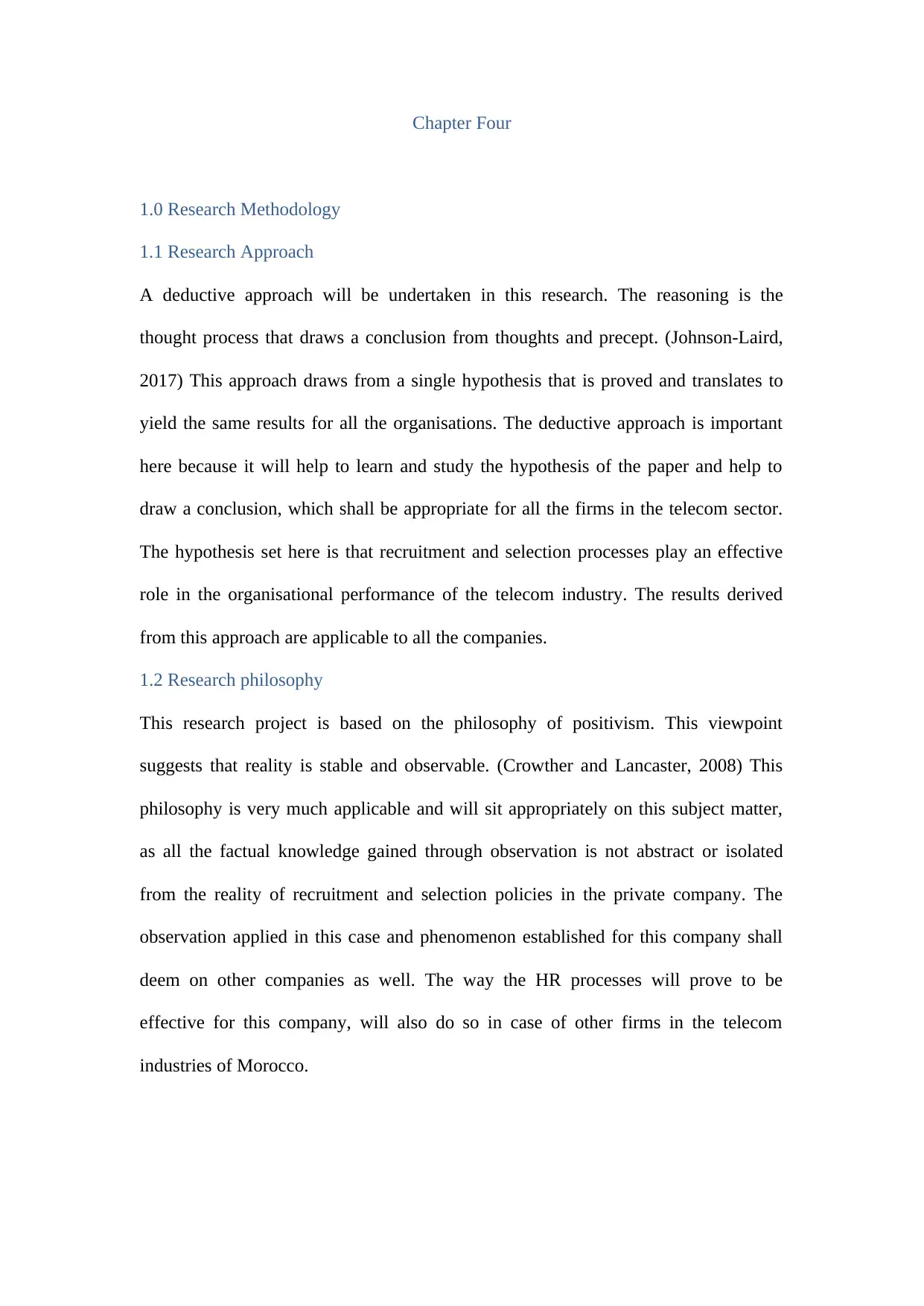
Chapter Four
1.0 Research Methodology
1.1 Research Approach
A deductive approach will be undertaken in this research. The reasoning is the
thought process that draws a conclusion from thoughts and precept. (Johnson-Laird,
2017) This approach draws from a single hypothesis that is proved and translates to
yield the same results for all the organisations. The deductive approach is important
here because it will help to learn and study the hypothesis of the paper and help to
draw a conclusion, which shall be appropriate for all the firms in the telecom sector.
The hypothesis set here is that recruitment and selection processes play an effective
role in the organisational performance of the telecom industry. The results derived
from this approach are applicable to all the companies.
1.2 Research philosophy
This research project is based on the philosophy of positivism. This viewpoint
suggests that reality is stable and observable. (Crowther and Lancaster, 2008) This
philosophy is very much applicable and will sit appropriately on this subject matter,
as all the factual knowledge gained through observation is not abstract or isolated
from the reality of recruitment and selection policies in the private company. The
observation applied in this case and phenomenon established for this company shall
deem on other companies as well. The way the HR processes will prove to be
effective for this company, will also do so in case of other firms in the telecom
industries of Morocco.
1.0 Research Methodology
1.1 Research Approach
A deductive approach will be undertaken in this research. The reasoning is the
thought process that draws a conclusion from thoughts and precept. (Johnson-Laird,
2017) This approach draws from a single hypothesis that is proved and translates to
yield the same results for all the organisations. The deductive approach is important
here because it will help to learn and study the hypothesis of the paper and help to
draw a conclusion, which shall be appropriate for all the firms in the telecom sector.
The hypothesis set here is that recruitment and selection processes play an effective
role in the organisational performance of the telecom industry. The results derived
from this approach are applicable to all the companies.
1.2 Research philosophy
This research project is based on the philosophy of positivism. This viewpoint
suggests that reality is stable and observable. (Crowther and Lancaster, 2008) This
philosophy is very much applicable and will sit appropriately on this subject matter,
as all the factual knowledge gained through observation is not abstract or isolated
from the reality of recruitment and selection policies in the private company. The
observation applied in this case and phenomenon established for this company shall
deem on other companies as well. The way the HR processes will prove to be
effective for this company, will also do so in case of other firms in the telecom
industries of Morocco.
Secure Best Marks with AI Grader
Need help grading? Try our AI Grader for instant feedback on your assignments.

1.3 Research Design
Multiple forms of methods of research may be used when undertaking proper
research. The two broad aspects include quantitative and qualitative research. In the
case in point, the research design will emphasise on quantitative or mixed methods of
research. The mixed method of research will comprise of surveys, questionnaires, and
discussion groups. All these methods of data collection will supplement one another
so that any lack of information "can compensate for uni-paradigmatic limitations.”
(Ponterotto, Mathew and Raughley, 2017) In this way, the information gathered in the
quantitative methods boosts the dependability and validity of the collected data.
(Zohrabi, 2013) The range of data available after the gathering of the information also
magnifies the reliability of it. This is a need in the case study of the Moroccan
telecom industry, as only reliable and extensive data, made available through the
mixed method, will provide sufficient results and understanding of the true
effectiveness of the processes of recruitment and selection in the performance of an
organisation of this sector. The mixed method approach will also blend together the
best of both the methods of quantitative and qualitative research, offering greater
flexibility.
1.5 Study Population
The population that will be targeted in order to conduct this study will encompass HR
managers, practitioners, and workers. Both the personnel in the higher tier of the
management as well as down to the levels of workers will be included in the research.
Both the mainstream as well as the non-mainstream workers at the operational and
managerial levels of staff will be covered.
1.6 Unit of Analysis
These include both the dependent and independent variable
Multiple forms of methods of research may be used when undertaking proper
research. The two broad aspects include quantitative and qualitative research. In the
case in point, the research design will emphasise on quantitative or mixed methods of
research. The mixed method of research will comprise of surveys, questionnaires, and
discussion groups. All these methods of data collection will supplement one another
so that any lack of information "can compensate for uni-paradigmatic limitations.”
(Ponterotto, Mathew and Raughley, 2017) In this way, the information gathered in the
quantitative methods boosts the dependability and validity of the collected data.
(Zohrabi, 2013) The range of data available after the gathering of the information also
magnifies the reliability of it. This is a need in the case study of the Moroccan
telecom industry, as only reliable and extensive data, made available through the
mixed method, will provide sufficient results and understanding of the true
effectiveness of the processes of recruitment and selection in the performance of an
organisation of this sector. The mixed method approach will also blend together the
best of both the methods of quantitative and qualitative research, offering greater
flexibility.
1.5 Study Population
The population that will be targeted in order to conduct this study will encompass HR
managers, practitioners, and workers. Both the personnel in the higher tier of the
management as well as down to the levels of workers will be included in the research.
Both the mainstream as well as the non-mainstream workers at the operational and
managerial levels of staff will be covered.
1.6 Unit of Analysis
These include both the dependent and independent variable
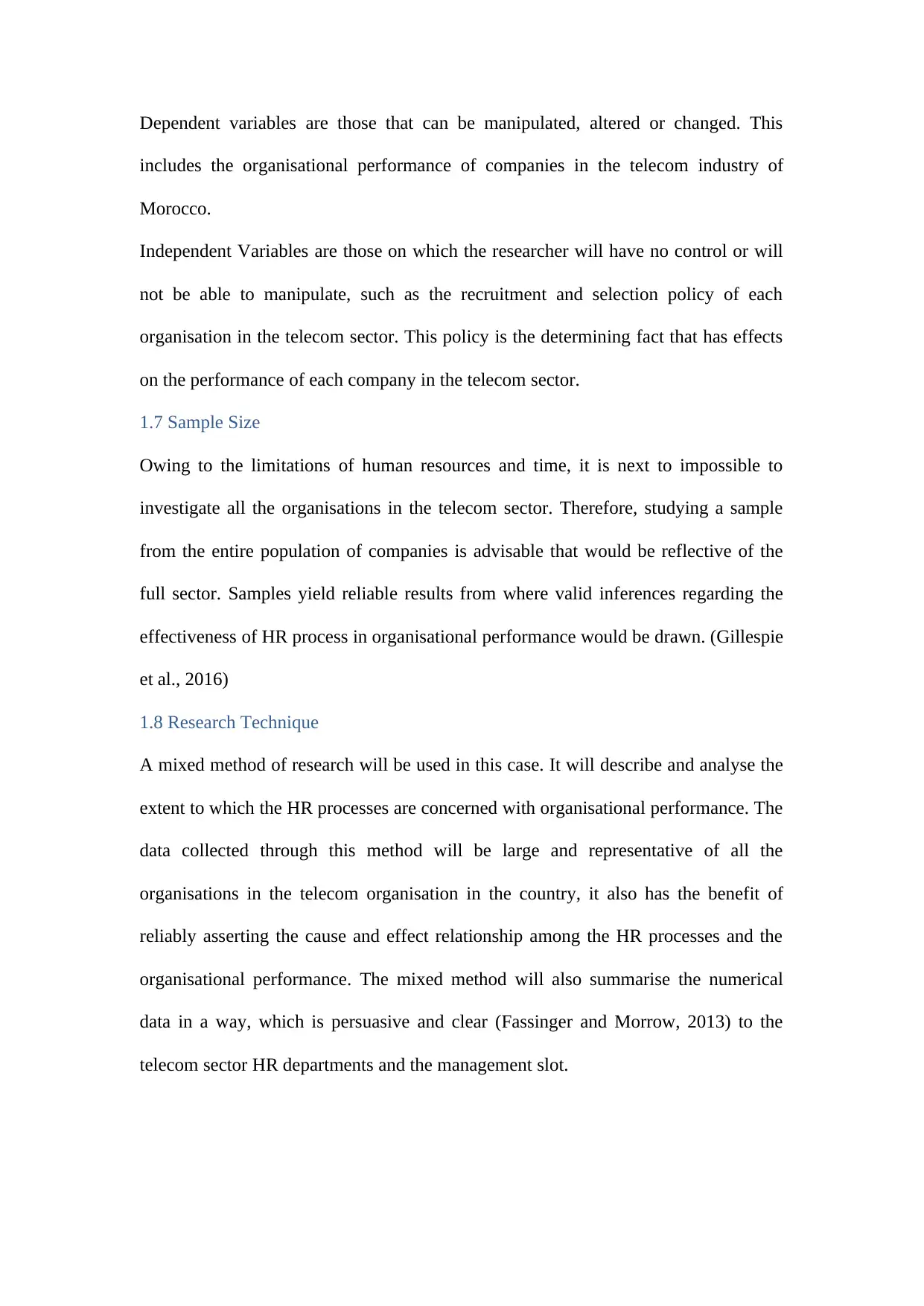
Dependent variables are those that can be manipulated, altered or changed. This
includes the organisational performance of companies in the telecom industry of
Morocco.
Independent Variables are those on which the researcher will have no control or will
not be able to manipulate, such as the recruitment and selection policy of each
organisation in the telecom sector. This policy is the determining fact that has effects
on the performance of each company in the telecom sector.
1.7 Sample Size
Owing to the limitations of human resources and time, it is next to impossible to
investigate all the organisations in the telecom sector. Therefore, studying a sample
from the entire population of companies is advisable that would be reflective of the
full sector. Samples yield reliable results from where valid inferences regarding the
effectiveness of HR process in organisational performance would be drawn. (Gillespie
et al., 2016)
1.8 Research Technique
A mixed method of research will be used in this case. It will describe and analyse the
extent to which the HR processes are concerned with organisational performance. The
data collected through this method will be large and representative of all the
organisations in the telecom organisation in the country, it also has the benefit of
reliably asserting the cause and effect relationship among the HR processes and the
organisational performance. The mixed method will also summarise the numerical
data in a way, which is persuasive and clear (Fassinger and Morrow, 2013) to the
telecom sector HR departments and the management slot.
includes the organisational performance of companies in the telecom industry of
Morocco.
Independent Variables are those on which the researcher will have no control or will
not be able to manipulate, such as the recruitment and selection policy of each
organisation in the telecom sector. This policy is the determining fact that has effects
on the performance of each company in the telecom sector.
1.7 Sample Size
Owing to the limitations of human resources and time, it is next to impossible to
investigate all the organisations in the telecom sector. Therefore, studying a sample
from the entire population of companies is advisable that would be reflective of the
full sector. Samples yield reliable results from where valid inferences regarding the
effectiveness of HR process in organisational performance would be drawn. (Gillespie
et al., 2016)
1.8 Research Technique
A mixed method of research will be used in this case. It will describe and analyse the
extent to which the HR processes are concerned with organisational performance. The
data collected through this method will be large and representative of all the
organisations in the telecom organisation in the country, it also has the benefit of
reliably asserting the cause and effect relationship among the HR processes and the
organisational performance. The mixed method will also summarise the numerical
data in a way, which is persuasive and clear (Fassinger and Morrow, 2013) to the
telecom sector HR departments and the management slot.
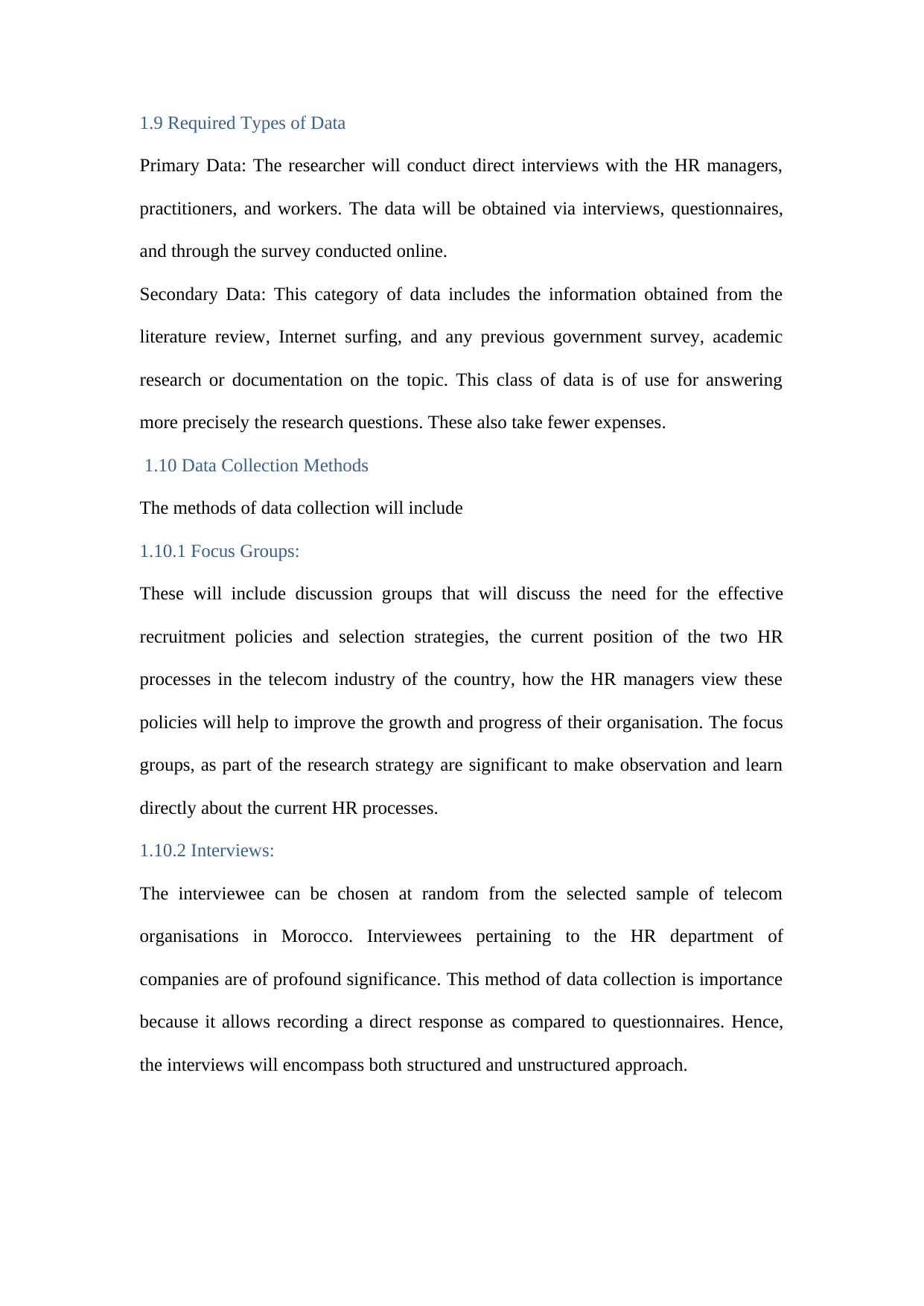
1.9 Required Types of Data
Primary Data: The researcher will conduct direct interviews with the HR managers,
practitioners, and workers. The data will be obtained via interviews, questionnaires,
and through the survey conducted online.
Secondary Data: This category of data includes the information obtained from the
literature review, Internet surfing, and any previous government survey, academic
research or documentation on the topic. This class of data is of use for answering
more precisely the research questions. These also take fewer expenses.
1.10 Data Collection Methods
The methods of data collection will include
1.10.1 Focus Groups:
These will include discussion groups that will discuss the need for the effective
recruitment policies and selection strategies, the current position of the two HR
processes in the telecom industry of the country, how the HR managers view these
policies will help to improve the growth and progress of their organisation. The focus
groups, as part of the research strategy are significant to make observation and learn
directly about the current HR processes.
1.10.2 Interviews:
The interviewee can be chosen at random from the selected sample of telecom
organisations in Morocco. Interviewees pertaining to the HR department of
companies are of profound significance. This method of data collection is importance
because it allows recording a direct response as compared to questionnaires. Hence,
the interviews will encompass both structured and unstructured approach.
Primary Data: The researcher will conduct direct interviews with the HR managers,
practitioners, and workers. The data will be obtained via interviews, questionnaires,
and through the survey conducted online.
Secondary Data: This category of data includes the information obtained from the
literature review, Internet surfing, and any previous government survey, academic
research or documentation on the topic. This class of data is of use for answering
more precisely the research questions. These also take fewer expenses.
1.10 Data Collection Methods
The methods of data collection will include
1.10.1 Focus Groups:
These will include discussion groups that will discuss the need for the effective
recruitment policies and selection strategies, the current position of the two HR
processes in the telecom industry of the country, how the HR managers view these
policies will help to improve the growth and progress of their organisation. The focus
groups, as part of the research strategy are significant to make observation and learn
directly about the current HR processes.
1.10.2 Interviews:
The interviewee can be chosen at random from the selected sample of telecom
organisations in Morocco. Interviewees pertaining to the HR department of
companies are of profound significance. This method of data collection is importance
because it allows recording a direct response as compared to questionnaires. Hence,
the interviews will encompass both structured and unstructured approach.
Secure Best Marks with AI Grader
Need help grading? Try our AI Grader for instant feedback on your assignments.
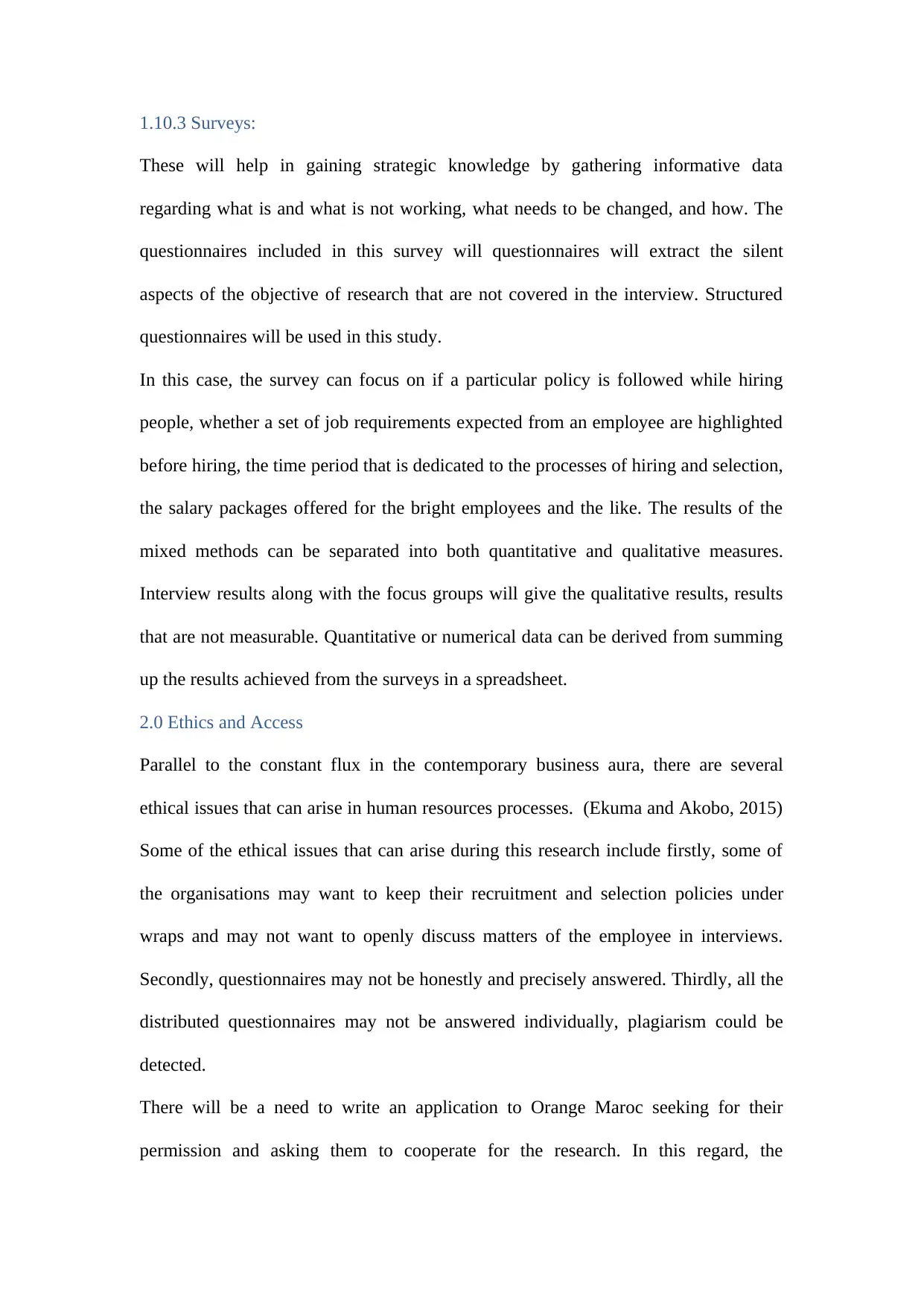
1.10.3 Surveys:
These will help in gaining strategic knowledge by gathering informative data
regarding what is and what is not working, what needs to be changed, and how. The
questionnaires included in this survey will questionnaires will extract the silent
aspects of the objective of research that are not covered in the interview. Structured
questionnaires will be used in this study.
In this case, the survey can focus on if a particular policy is followed while hiring
people, whether a set of job requirements expected from an employee are highlighted
before hiring, the time period that is dedicated to the processes of hiring and selection,
the salary packages offered for the bright employees and the like. The results of the
mixed methods can be separated into both quantitative and qualitative measures.
Interview results along with the focus groups will give the qualitative results, results
that are not measurable. Quantitative or numerical data can be derived from summing
up the results achieved from the surveys in a spreadsheet.
2.0 Ethics and Access
Parallel to the constant flux in the contemporary business aura, there are several
ethical issues that can arise in human resources processes. (Ekuma and Akobo, 2015)
Some of the ethical issues that can arise during this research include firstly, some of
the organisations may want to keep their recruitment and selection policies under
wraps and may not want to openly discuss matters of the employee in interviews.
Secondly, questionnaires may not be honestly and precisely answered. Thirdly, all the
distributed questionnaires may not be answered individually, plagiarism could be
detected.
There will be a need to write an application to Orange Maroc seeking for their
permission and asking them to cooperate for the research. In this regard, the
These will help in gaining strategic knowledge by gathering informative data
regarding what is and what is not working, what needs to be changed, and how. The
questionnaires included in this survey will questionnaires will extract the silent
aspects of the objective of research that are not covered in the interview. Structured
questionnaires will be used in this study.
In this case, the survey can focus on if a particular policy is followed while hiring
people, whether a set of job requirements expected from an employee are highlighted
before hiring, the time period that is dedicated to the processes of hiring and selection,
the salary packages offered for the bright employees and the like. The results of the
mixed methods can be separated into both quantitative and qualitative measures.
Interview results along with the focus groups will give the qualitative results, results
that are not measurable. Quantitative or numerical data can be derived from summing
up the results achieved from the surveys in a spreadsheet.
2.0 Ethics and Access
Parallel to the constant flux in the contemporary business aura, there are several
ethical issues that can arise in human resources processes. (Ekuma and Akobo, 2015)
Some of the ethical issues that can arise during this research include firstly, some of
the organisations may want to keep their recruitment and selection policies under
wraps and may not want to openly discuss matters of the employee in interviews.
Secondly, questionnaires may not be honestly and precisely answered. Thirdly, all the
distributed questionnaires may not be answered individually, plagiarism could be
detected.
There will be a need to write an application to Orange Maroc seeking for their
permission and asking them to cooperate for the research. In this regard, the
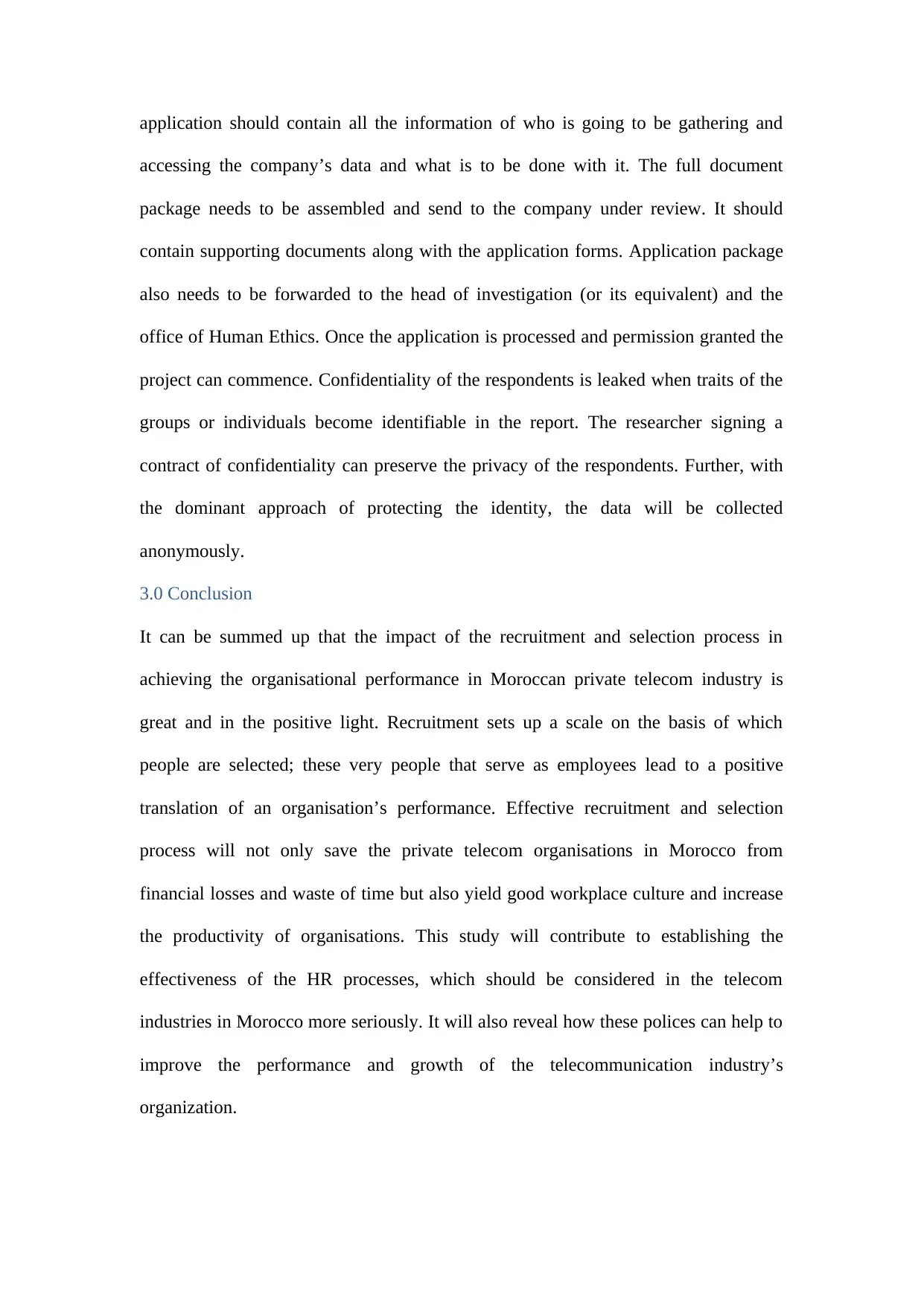
application should contain all the information of who is going to be gathering and
accessing the company’s data and what is to be done with it. The full document
package needs to be assembled and send to the company under review. It should
contain supporting documents along with the application forms. Application package
also needs to be forwarded to the head of investigation (or its equivalent) and the
office of Human Ethics. Once the application is processed and permission granted the
project can commence. Confidentiality of the respondents is leaked when traits of the
groups or individuals become identifiable in the report. The researcher signing a
contract of confidentiality can preserve the privacy of the respondents. Further, with
the dominant approach of protecting the identity, the data will be collected
anonymously.
3.0 Conclusion
It can be summed up that the impact of the recruitment and selection process in
achieving the organisational performance in Moroccan private telecom industry is
great and in the positive light. Recruitment sets up a scale on the basis of which
people are selected; these very people that serve as employees lead to a positive
translation of an organisation’s performance. Effective recruitment and selection
process will not only save the private telecom organisations in Morocco from
financial losses and waste of time but also yield good workplace culture and increase
the productivity of organisations. This study will contribute to establishing the
effectiveness of the HR processes, which should be considered in the telecom
industries in Morocco more seriously. It will also reveal how these polices can help to
improve the performance and growth of the telecommunication industry’s
organization.
accessing the company’s data and what is to be done with it. The full document
package needs to be assembled and send to the company under review. It should
contain supporting documents along with the application forms. Application package
also needs to be forwarded to the head of investigation (or its equivalent) and the
office of Human Ethics. Once the application is processed and permission granted the
project can commence. Confidentiality of the respondents is leaked when traits of the
groups or individuals become identifiable in the report. The researcher signing a
contract of confidentiality can preserve the privacy of the respondents. Further, with
the dominant approach of protecting the identity, the data will be collected
anonymously.
3.0 Conclusion
It can be summed up that the impact of the recruitment and selection process in
achieving the organisational performance in Moroccan private telecom industry is
great and in the positive light. Recruitment sets up a scale on the basis of which
people are selected; these very people that serve as employees lead to a positive
translation of an organisation’s performance. Effective recruitment and selection
process will not only save the private telecom organisations in Morocco from
financial losses and waste of time but also yield good workplace culture and increase
the productivity of organisations. This study will contribute to establishing the
effectiveness of the HR processes, which should be considered in the telecom
industries in Morocco more seriously. It will also reveal how these polices can help to
improve the performance and growth of the telecommunication industry’s
organization.
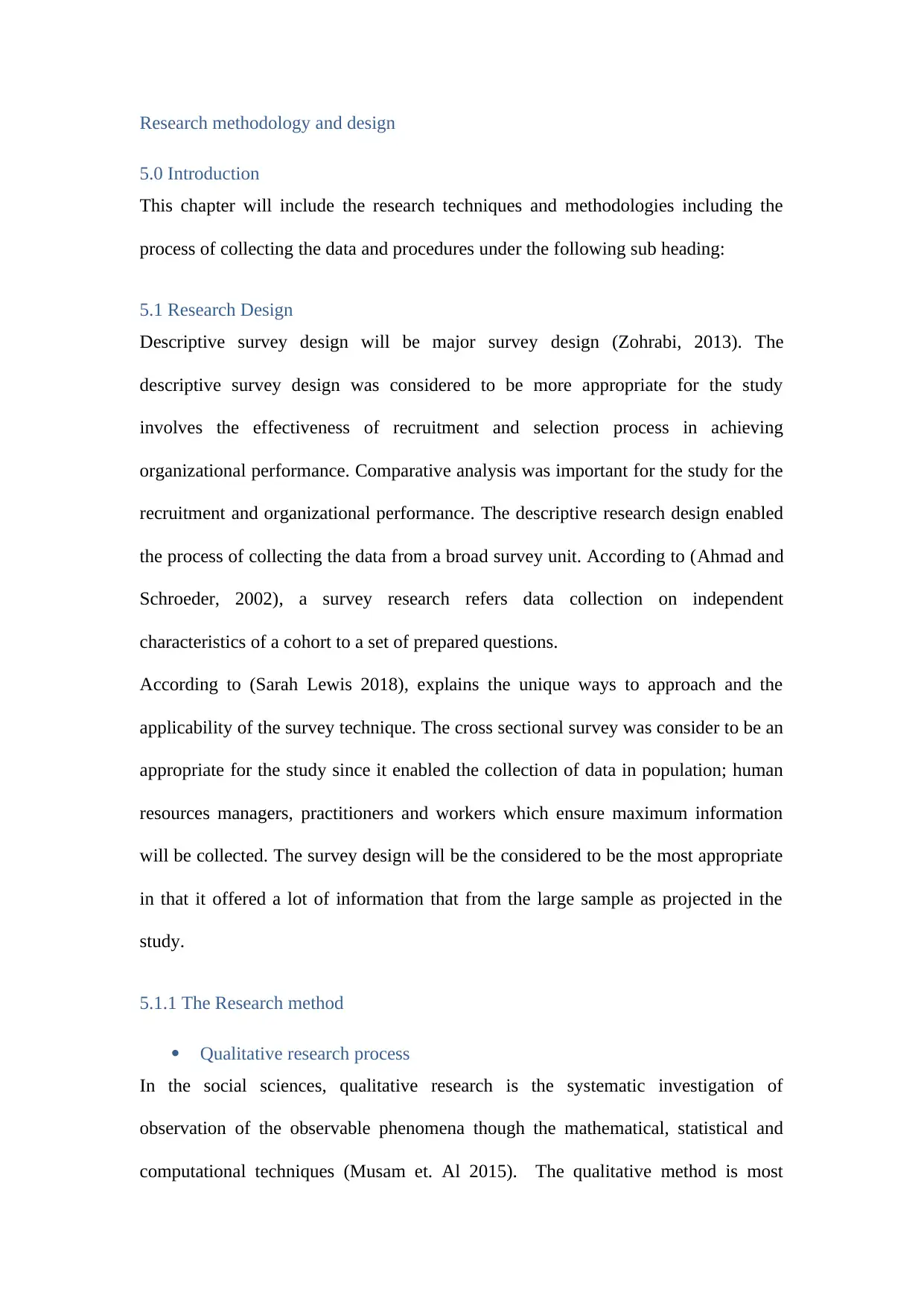
Research methodology and design
5.0 Introduction
This chapter will include the research techniques and methodologies including the
process of collecting the data and procedures under the following sub heading:
5.1 Research Design
Descriptive survey design will be major survey design (Zohrabi, 2013). The
descriptive survey design was considered to be more appropriate for the study
involves the effectiveness of recruitment and selection process in achieving
organizational performance. Comparative analysis was important for the study for the
recruitment and organizational performance. The descriptive research design enabled
the process of collecting the data from a broad survey unit. According to (Ahmad and
Schroeder, 2002), a survey research refers data collection on independent
characteristics of a cohort to a set of prepared questions.
According to (Sarah Lewis 2018), explains the unique ways to approach and the
applicability of the survey technique. The cross sectional survey was consider to be an
appropriate for the study since it enabled the collection of data in population; human
resources managers, practitioners and workers which ensure maximum information
will be collected. The survey design will be the considered to be the most appropriate
in that it offered a lot of information that from the large sample as projected in the
study.
5.1.1 The Research method
Qualitative research process
In the social sciences, qualitative research is the systematic investigation of
observation of the observable phenomena though the mathematical, statistical and
computational techniques (Musam et. Al 2015). The qualitative method is most
5.0 Introduction
This chapter will include the research techniques and methodologies including the
process of collecting the data and procedures under the following sub heading:
5.1 Research Design
Descriptive survey design will be major survey design (Zohrabi, 2013). The
descriptive survey design was considered to be more appropriate for the study
involves the effectiveness of recruitment and selection process in achieving
organizational performance. Comparative analysis was important for the study for the
recruitment and organizational performance. The descriptive research design enabled
the process of collecting the data from a broad survey unit. According to (Ahmad and
Schroeder, 2002), a survey research refers data collection on independent
characteristics of a cohort to a set of prepared questions.
According to (Sarah Lewis 2018), explains the unique ways to approach and the
applicability of the survey technique. The cross sectional survey was consider to be an
appropriate for the study since it enabled the collection of data in population; human
resources managers, practitioners and workers which ensure maximum information
will be collected. The survey design will be the considered to be the most appropriate
in that it offered a lot of information that from the large sample as projected in the
study.
5.1.1 The Research method
Qualitative research process
In the social sciences, qualitative research is the systematic investigation of
observation of the observable phenomena though the mathematical, statistical and
computational techniques (Musam et. Al 2015). The qualitative method is most
Paraphrase This Document
Need a fresh take? Get an instant paraphrase of this document with our AI Paraphraser
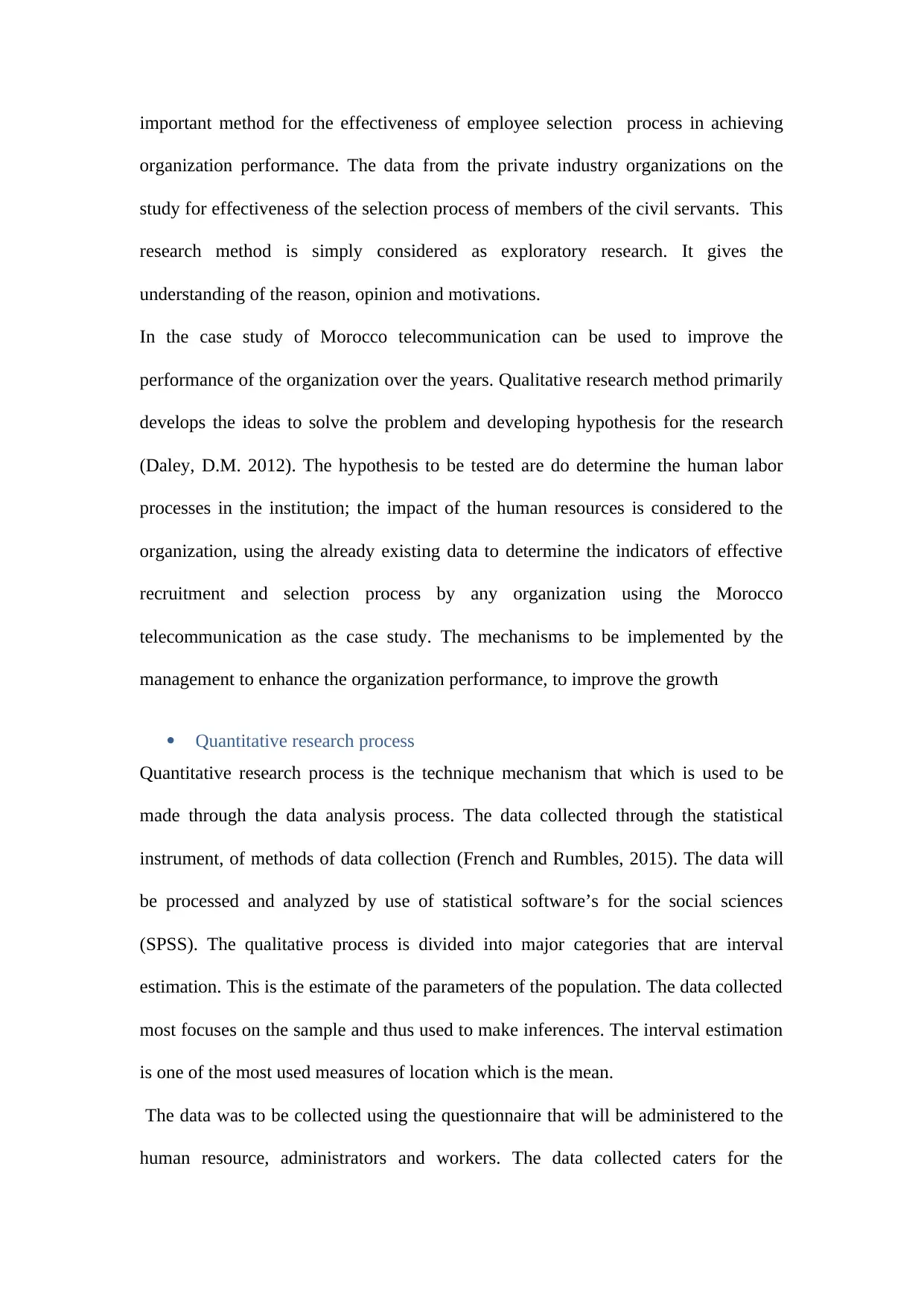
important method for the effectiveness of employee selection process in achieving
organization performance. The data from the private industry organizations on the
study for effectiveness of the selection process of members of the civil servants. This
research method is simply considered as exploratory research. It gives the
understanding of the reason, opinion and motivations.
In the case study of Morocco telecommunication can be used to improve the
performance of the organization over the years. Qualitative research method primarily
develops the ideas to solve the problem and developing hypothesis for the research
(Daley, D.M. 2012). The hypothesis to be tested are do determine the human labor
processes in the institution; the impact of the human resources is considered to the
organization, using the already existing data to determine the indicators of effective
recruitment and selection process by any organization using the Morocco
telecommunication as the case study. The mechanisms to be implemented by the
management to enhance the organization performance, to improve the growth
Quantitative research process
Quantitative research process is the technique mechanism that which is used to be
made through the data analysis process. The data collected through the statistical
instrument, of methods of data collection (French and Rumbles, 2015). The data will
be processed and analyzed by use of statistical software’s for the social sciences
(SPSS). The qualitative process is divided into major categories that are interval
estimation. This is the estimate of the parameters of the population. The data collected
most focuses on the sample and thus used to make inferences. The interval estimation
is one of the most used measures of location which is the mean.
The data was to be collected using the questionnaire that will be administered to the
human resource, administrators and workers. The data collected caters for the
organization performance. The data from the private industry organizations on the
study for effectiveness of the selection process of members of the civil servants. This
research method is simply considered as exploratory research. It gives the
understanding of the reason, opinion and motivations.
In the case study of Morocco telecommunication can be used to improve the
performance of the organization over the years. Qualitative research method primarily
develops the ideas to solve the problem and developing hypothesis for the research
(Daley, D.M. 2012). The hypothesis to be tested are do determine the human labor
processes in the institution; the impact of the human resources is considered to the
organization, using the already existing data to determine the indicators of effective
recruitment and selection process by any organization using the Morocco
telecommunication as the case study. The mechanisms to be implemented by the
management to enhance the organization performance, to improve the growth
Quantitative research process
Quantitative research process is the technique mechanism that which is used to be
made through the data analysis process. The data collected through the statistical
instrument, of methods of data collection (French and Rumbles, 2015). The data will
be processed and analyzed by use of statistical software’s for the social sciences
(SPSS). The qualitative process is divided into major categories that are interval
estimation. This is the estimate of the parameters of the population. The data collected
most focuses on the sample and thus used to make inferences. The interval estimation
is one of the most used measures of location which is the mean.
The data was to be collected using the questionnaire that will be administered to the
human resource, administrators and workers. The data collected caters for the
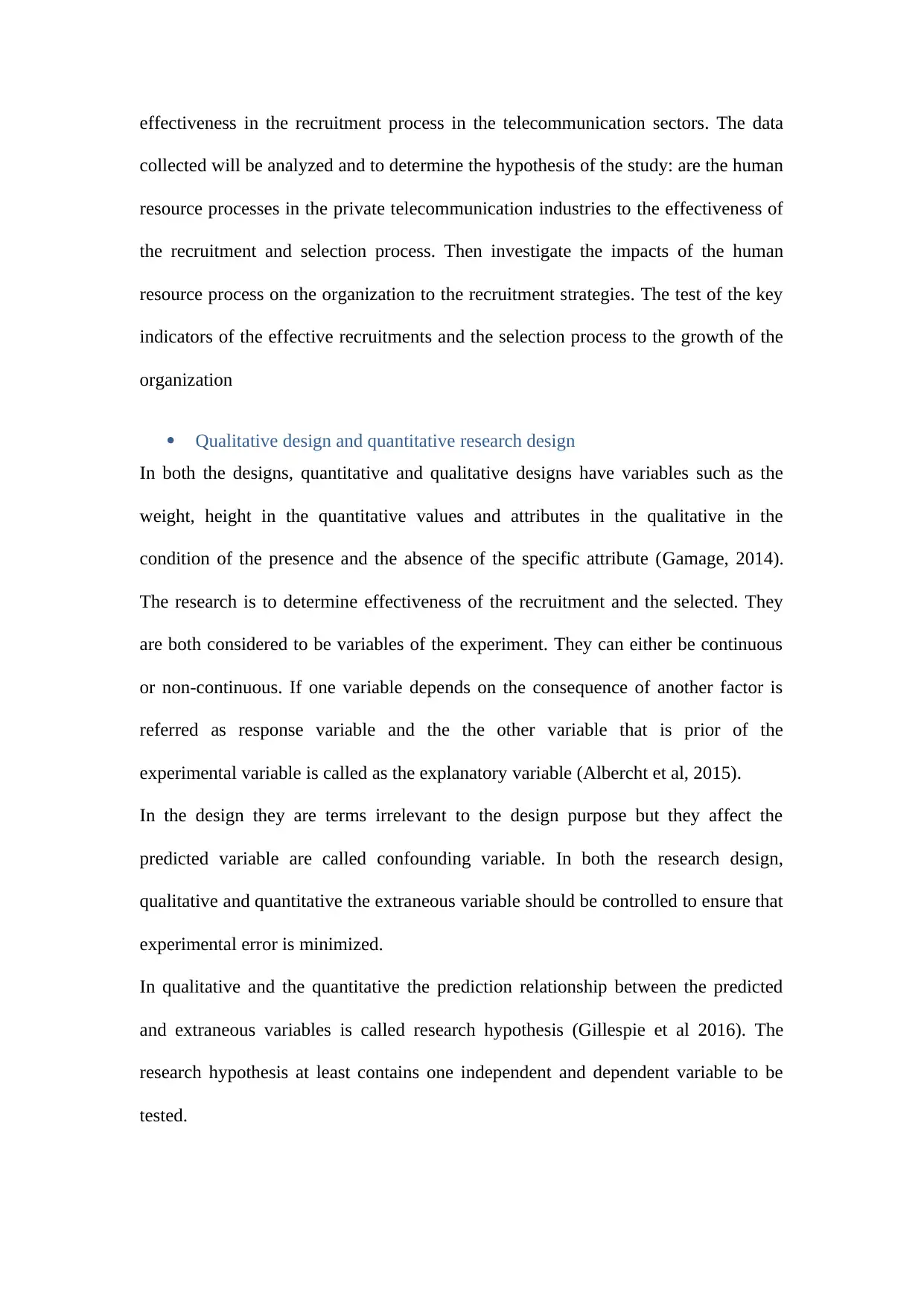
effectiveness in the recruitment process in the telecommunication sectors. The data
collected will be analyzed and to determine the hypothesis of the study: are the human
resource processes in the private telecommunication industries to the effectiveness of
the recruitment and selection process. Then investigate the impacts of the human
resource process on the organization to the recruitment strategies. The test of the key
indicators of the effective recruitments and the selection process to the growth of the
organization
Qualitative design and quantitative research design
In both the designs, quantitative and qualitative designs have variables such as the
weight, height in the quantitative values and attributes in the qualitative in the
condition of the presence and the absence of the specific attribute (Gamage, 2014).
The research is to determine effectiveness of the recruitment and the selected. They
are both considered to be variables of the experiment. They can either be continuous
or non-continuous. If one variable depends on the consequence of another factor is
referred as response variable and the the other variable that is prior of the
experimental variable is called as the explanatory variable (Albercht et al, 2015).
In the design they are terms irrelevant to the design purpose but they affect the
predicted variable are called confounding variable. In both the research design,
qualitative and quantitative the extraneous variable should be controlled to ensure that
experimental error is minimized.
In qualitative and the quantitative the prediction relationship between the predicted
and extraneous variables is called research hypothesis (Gillespie et al 2016). The
research hypothesis at least contains one independent and dependent variable to be
tested.
collected will be analyzed and to determine the hypothesis of the study: are the human
resource processes in the private telecommunication industries to the effectiveness of
the recruitment and selection process. Then investigate the impacts of the human
resource process on the organization to the recruitment strategies. The test of the key
indicators of the effective recruitments and the selection process to the growth of the
organization
Qualitative design and quantitative research design
In both the designs, quantitative and qualitative designs have variables such as the
weight, height in the quantitative values and attributes in the qualitative in the
condition of the presence and the absence of the specific attribute (Gamage, 2014).
The research is to determine effectiveness of the recruitment and the selected. They
are both considered to be variables of the experiment. They can either be continuous
or non-continuous. If one variable depends on the consequence of another factor is
referred as response variable and the the other variable that is prior of the
experimental variable is called as the explanatory variable (Albercht et al, 2015).
In the design they are terms irrelevant to the design purpose but they affect the
predicted variable are called confounding variable. In both the research design,
qualitative and quantitative the extraneous variable should be controlled to ensure that
experimental error is minimized.
In qualitative and the quantitative the prediction relationship between the predicted
and extraneous variables is called research hypothesis (Gillespie et al 2016). The
research hypothesis at least contains one independent and dependent variable to be
tested.
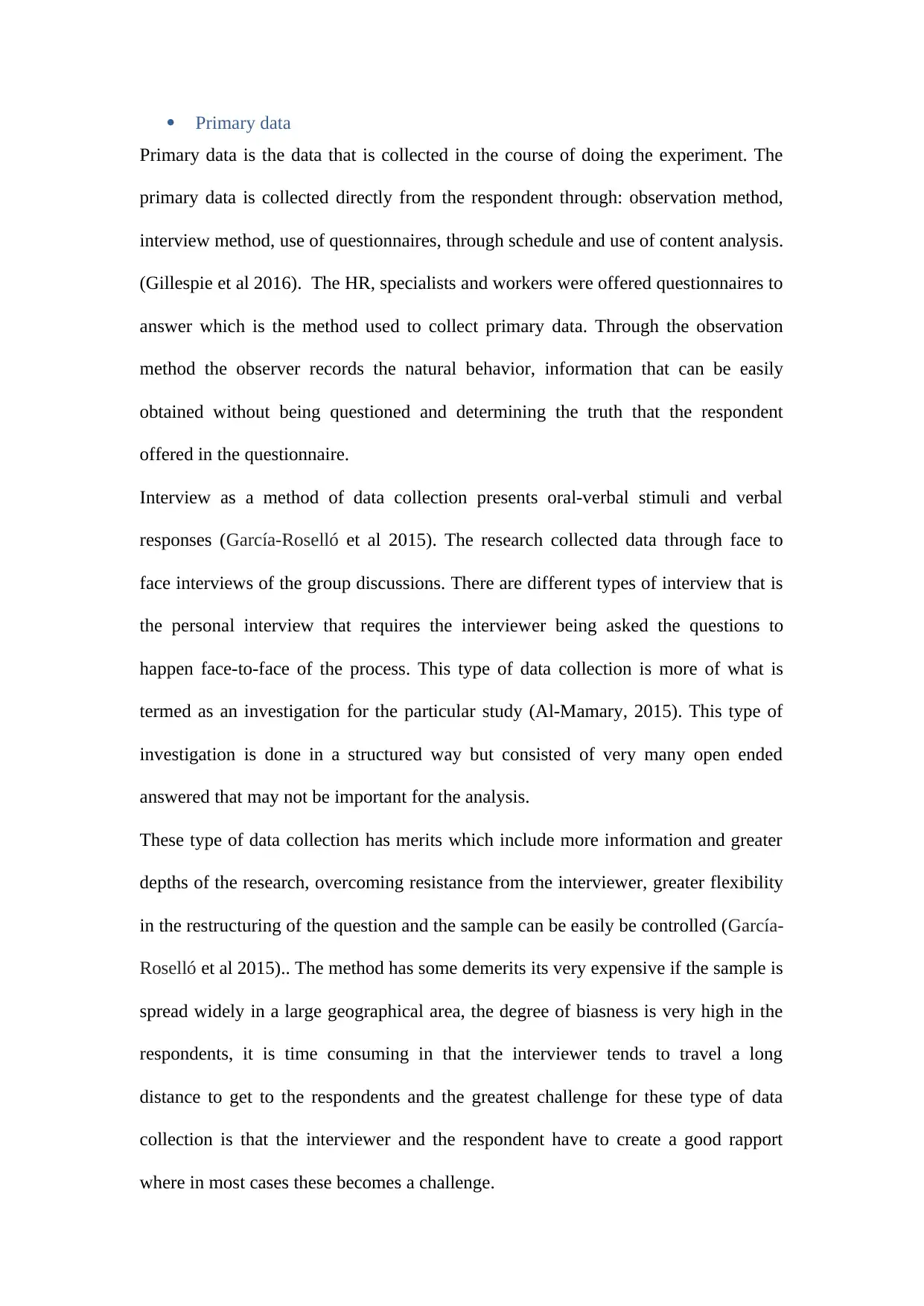
Primary data
Primary data is the data that is collected in the course of doing the experiment. The
primary data is collected directly from the respondent through: observation method,
interview method, use of questionnaires, through schedule and use of content analysis.
(Gillespie et al 2016). The HR, specialists and workers were offered questionnaires to
answer which is the method used to collect primary data. Through the observation
method the observer records the natural behavior, information that can be easily
obtained without being questioned and determining the truth that the respondent
offered in the questionnaire.
Interview as a method of data collection presents oral-verbal stimuli and verbal
responses (García‐Roselló et al 2015). The research collected data through face to
face interviews of the group discussions. There are different types of interview that is
the personal interview that requires the interviewer being asked the questions to
happen face-to-face of the process. This type of data collection is more of what is
termed as an investigation for the particular study (Al-Mamary, 2015). This type of
investigation is done in a structured way but consisted of very many open ended
answered that may not be important for the analysis.
These type of data collection has merits which include more information and greater
depths of the research, overcoming resistance from the interviewer, greater flexibility
in the restructuring of the question and the sample can be easily be controlled (García‐
Roselló et al 2015).. The method has some demerits its very expensive if the sample is
spread widely in a large geographical area, the degree of biasness is very high in the
respondents, it is time consuming in that the interviewer tends to travel a long
distance to get to the respondents and the greatest challenge for these type of data
collection is that the interviewer and the respondent have to create a good rapport
where in most cases these becomes a challenge.
Primary data is the data that is collected in the course of doing the experiment. The
primary data is collected directly from the respondent through: observation method,
interview method, use of questionnaires, through schedule and use of content analysis.
(Gillespie et al 2016). The HR, specialists and workers were offered questionnaires to
answer which is the method used to collect primary data. Through the observation
method the observer records the natural behavior, information that can be easily
obtained without being questioned and determining the truth that the respondent
offered in the questionnaire.
Interview as a method of data collection presents oral-verbal stimuli and verbal
responses (García‐Roselló et al 2015). The research collected data through face to
face interviews of the group discussions. There are different types of interview that is
the personal interview that requires the interviewer being asked the questions to
happen face-to-face of the process. This type of data collection is more of what is
termed as an investigation for the particular study (Al-Mamary, 2015). This type of
investigation is done in a structured way but consisted of very many open ended
answered that may not be important for the analysis.
These type of data collection has merits which include more information and greater
depths of the research, overcoming resistance from the interviewer, greater flexibility
in the restructuring of the question and the sample can be easily be controlled (García‐
Roselló et al 2015).. The method has some demerits its very expensive if the sample is
spread widely in a large geographical area, the degree of biasness is very high in the
respondents, it is time consuming in that the interviewer tends to travel a long
distance to get to the respondents and the greatest challenge for these type of data
collection is that the interviewer and the respondent have to create a good rapport
where in most cases these becomes a challenge.
Secure Best Marks with AI Grader
Need help grading? Try our AI Grader for instant feedback on your assignments.

A telephone interview is the other method in which primary data is collected from the
respondents through the telephone handset (Sgambatti et al 2016). These method has
merits on that it very flexible in that gives room for the rescheduling of the time and
the questions that are to be answered, its more fast in that it no movement from one
location to another, cheaper that there is no travelling cost hence economical, number
of staffs required to is minimal since calls can be made at different times and these
method allows the sample to be representative and wider distributed as much as
possible.
The method is challenging on that its short period, these method can only be used on
those who have telephone facilities and the questions are short and to the point.
Questionnaires method is used to collect the primary data (Sgambatti et al 2016).
Most of the respondents were the HR and the workers who were most involved with
the recruitment and processing of the organization and its impact to the growth of the
organization.
Secondary data
This alludes to data that was collected for some other purposes that not for the current
study that is at hand (Atkinson & Brandolini, 2001). There are different sources of
data that are termed as the secondary data which include censuses, information
collected by an organization for other research purposes (Guest, 1998). The data from
previous research as shown in chapter two(literature review) on the impact of the
recruitment and processing in achieving the organizational performance. These data
save the time that would have been used to collect the data from the fields in the case
of the qualitative data. These data helps to capture the development in the area of
study as compared to the previous research that had been done previously. The
respondents through the telephone handset (Sgambatti et al 2016). These method has
merits on that it very flexible in that gives room for the rescheduling of the time and
the questions that are to be answered, its more fast in that it no movement from one
location to another, cheaper that there is no travelling cost hence economical, number
of staffs required to is minimal since calls can be made at different times and these
method allows the sample to be representative and wider distributed as much as
possible.
The method is challenging on that its short period, these method can only be used on
those who have telephone facilities and the questions are short and to the point.
Questionnaires method is used to collect the primary data (Sgambatti et al 2016).
Most of the respondents were the HR and the workers who were most involved with
the recruitment and processing of the organization and its impact to the growth of the
organization.
Secondary data
This alludes to data that was collected for some other purposes that not for the current
study that is at hand (Atkinson & Brandolini, 2001). There are different sources of
data that are termed as the secondary data which include censuses, information
collected by an organization for other research purposes (Guest, 1998). The data from
previous research as shown in chapter two(literature review) on the impact of the
recruitment and processing in achieving the organizational performance. These data
save the time that would have been used to collect the data from the fields in the case
of the qualitative data. These data helps to capture the development in the area of
study as compared to the previous research that had been done previously. The
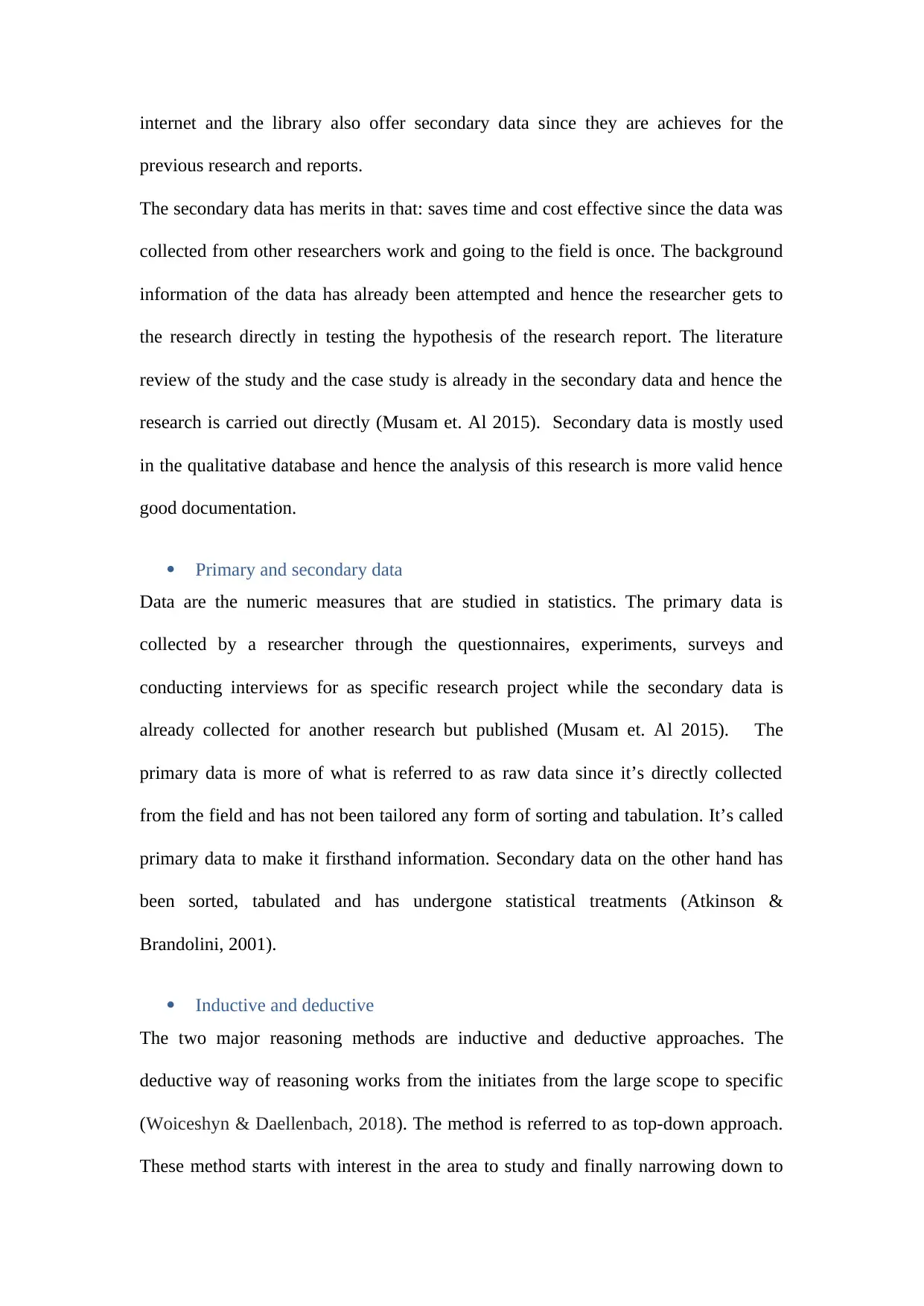
internet and the library also offer secondary data since they are achieves for the
previous research and reports.
The secondary data has merits in that: saves time and cost effective since the data was
collected from other researchers work and going to the field is once. The background
information of the data has already been attempted and hence the researcher gets to
the research directly in testing the hypothesis of the research report. The literature
review of the study and the case study is already in the secondary data and hence the
research is carried out directly (Musam et. Al 2015). Secondary data is mostly used
in the qualitative database and hence the analysis of this research is more valid hence
good documentation.
Primary and secondary data
Data are the numeric measures that are studied in statistics. The primary data is
collected by a researcher through the questionnaires, experiments, surveys and
conducting interviews for as specific research project while the secondary data is
already collected for another research but published (Musam et. Al 2015). The
primary data is more of what is referred to as raw data since it’s directly collected
from the field and has not been tailored any form of sorting and tabulation. It’s called
primary data to make it firsthand information. Secondary data on the other hand has
been sorted, tabulated and has undergone statistical treatments (Atkinson &
Brandolini, 2001).
Inductive and deductive
The two major reasoning methods are inductive and deductive approaches. The
deductive way of reasoning works from the initiates from the large scope to specific
(Woiceshyn & Daellenbach, 2018). The method is referred to as top-down approach.
These method starts with interest in the area to study and finally narrowing down to
previous research and reports.
The secondary data has merits in that: saves time and cost effective since the data was
collected from other researchers work and going to the field is once. The background
information of the data has already been attempted and hence the researcher gets to
the research directly in testing the hypothesis of the research report. The literature
review of the study and the case study is already in the secondary data and hence the
research is carried out directly (Musam et. Al 2015). Secondary data is mostly used
in the qualitative database and hence the analysis of this research is more valid hence
good documentation.
Primary and secondary data
Data are the numeric measures that are studied in statistics. The primary data is
collected by a researcher through the questionnaires, experiments, surveys and
conducting interviews for as specific research project while the secondary data is
already collected for another research but published (Musam et. Al 2015). The
primary data is more of what is referred to as raw data since it’s directly collected
from the field and has not been tailored any form of sorting and tabulation. It’s called
primary data to make it firsthand information. Secondary data on the other hand has
been sorted, tabulated and has undergone statistical treatments (Atkinson &
Brandolini, 2001).
Inductive and deductive
The two major reasoning methods are inductive and deductive approaches. The
deductive way of reasoning works from the initiates from the large scope to specific
(Woiceshyn & Daellenbach, 2018). The method is referred to as top-down approach.
These method starts with interest in the area to study and finally narrowing down to
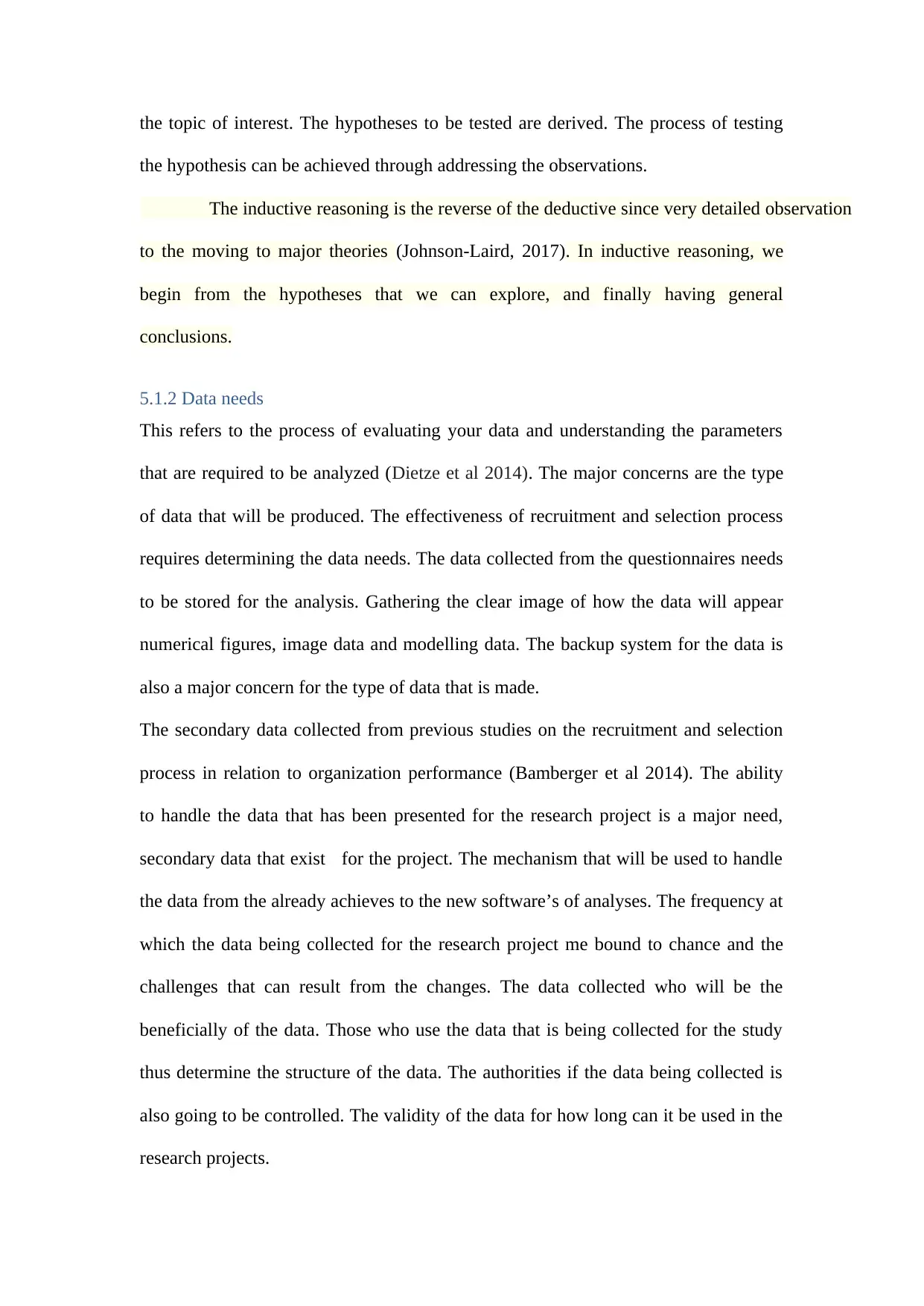
the topic of interest. The hypotheses to be tested are derived. The process of testing
the hypothesis can be achieved through addressing the observations.
The inductive reasoning is the reverse of the deductive since very detailed observation
to the moving to major theories (Johnson-Laird, 2017). In inductive reasoning, we
begin from the hypotheses that we can explore, and finally having general
conclusions.
5.1.2 Data needs
This refers to the process of evaluating your data and understanding the parameters
that are required to be analyzed (Dietze et al 2014). The major concerns are the type
of data that will be produced. The effectiveness of recruitment and selection process
requires determining the data needs. The data collected from the questionnaires needs
to be stored for the analysis. Gathering the clear image of how the data will appear
numerical figures, image data and modelling data. The backup system for the data is
also a major concern for the type of data that is made.
The secondary data collected from previous studies on the recruitment and selection
process in relation to organization performance (Bamberger et al 2014). The ability
to handle the data that has been presented for the research project is a major need,
secondary data that exist for the project. The mechanism that will be used to handle
the data from the already achieves to the new software’s of analyses. The frequency at
which the data being collected for the research project me bound to chance and the
challenges that can result from the changes. The data collected who will be the
beneficially of the data. Those who use the data that is being collected for the study
thus determine the structure of the data. The authorities if the data being collected is
also going to be controlled. The validity of the data for how long can it be used in the
research projects.
the hypothesis can be achieved through addressing the observations.
The inductive reasoning is the reverse of the deductive since very detailed observation
to the moving to major theories (Johnson-Laird, 2017). In inductive reasoning, we
begin from the hypotheses that we can explore, and finally having general
conclusions.
5.1.2 Data needs
This refers to the process of evaluating your data and understanding the parameters
that are required to be analyzed (Dietze et al 2014). The major concerns are the type
of data that will be produced. The effectiveness of recruitment and selection process
requires determining the data needs. The data collected from the questionnaires needs
to be stored for the analysis. Gathering the clear image of how the data will appear
numerical figures, image data and modelling data. The backup system for the data is
also a major concern for the type of data that is made.
The secondary data collected from previous studies on the recruitment and selection
process in relation to organization performance (Bamberger et al 2014). The ability
to handle the data that has been presented for the research project is a major need,
secondary data that exist for the project. The mechanism that will be used to handle
the data from the already achieves to the new software’s of analyses. The frequency at
which the data being collected for the research project me bound to chance and the
challenges that can result from the changes. The data collected who will be the
beneficially of the data. Those who use the data that is being collected for the study
thus determine the structure of the data. The authorities if the data being collected is
also going to be controlled. The validity of the data for how long can it be used in the
research projects.
Paraphrase This Document
Need a fresh take? Get an instant paraphrase of this document with our AI Paraphraser
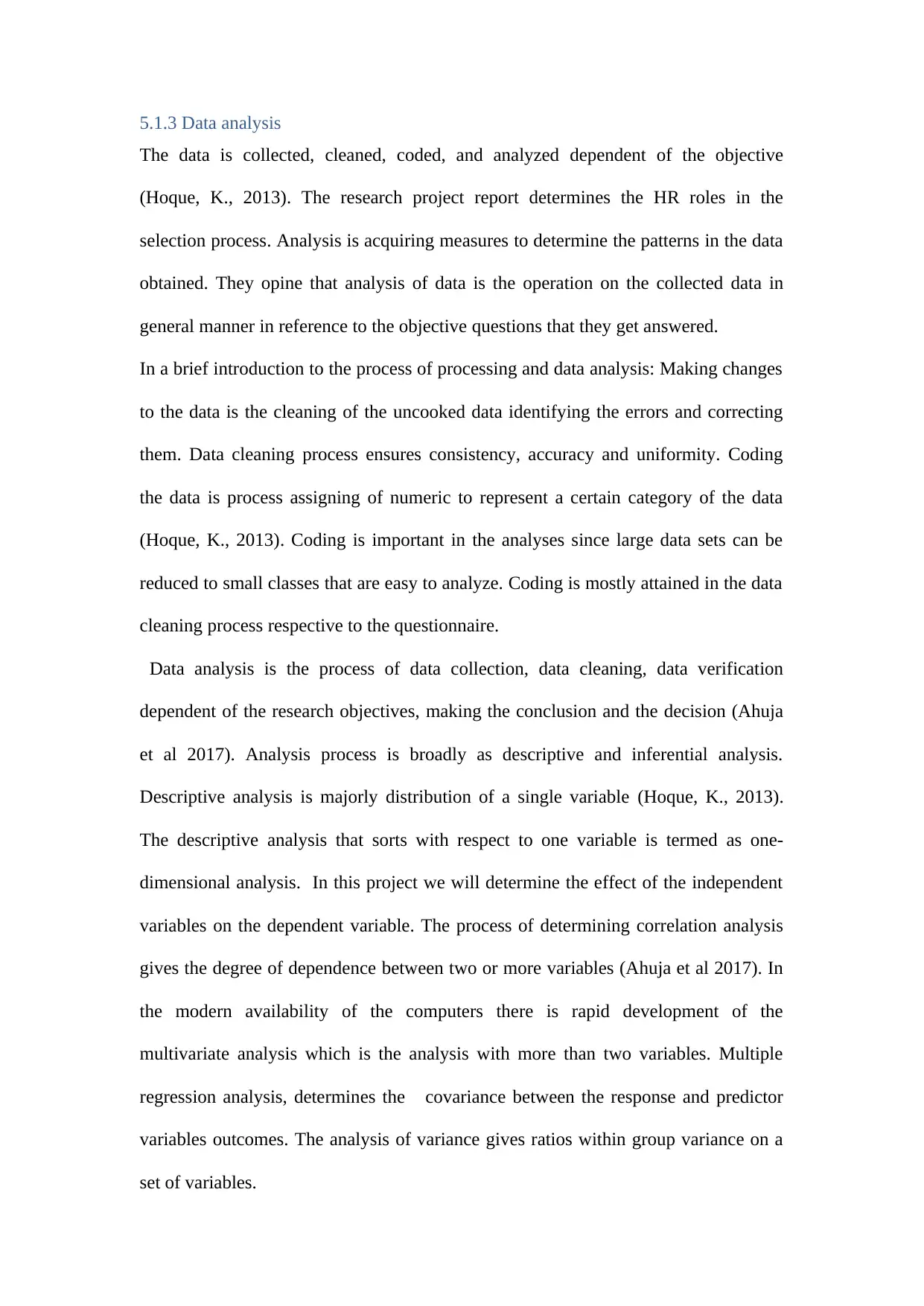
5.1.3 Data analysis
The data is collected, cleaned, coded, and analyzed dependent of the objective
(Hoque, K., 2013). The research project report determines the HR roles in the
selection process. Analysis is acquiring measures to determine the patterns in the data
obtained. They opine that analysis of data is the operation on the collected data in
general manner in reference to the objective questions that they get answered.
In a brief introduction to the process of processing and data analysis: Making changes
to the data is the cleaning of the uncooked data identifying the errors and correcting
them. Data cleaning process ensures consistency, accuracy and uniformity. Coding
the data is process assigning of numeric to represent a certain category of the data
(Hoque, K., 2013). Coding is important in the analyses since large data sets can be
reduced to small classes that are easy to analyze. Coding is mostly attained in the data
cleaning process respective to the questionnaire.
Data analysis is the process of data collection, data cleaning, data verification
dependent of the research objectives, making the conclusion and the decision (Ahuja
et al 2017). Analysis process is broadly as descriptive and inferential analysis.
Descriptive analysis is majorly distribution of a single variable (Hoque, K., 2013).
The descriptive analysis that sorts with respect to one variable is termed as one-
dimensional analysis. In this project we will determine the effect of the independent
variables on the dependent variable. The process of determining correlation analysis
gives the degree of dependence between two or more variables (Ahuja et al 2017). In
the modern availability of the computers there is rapid development of the
multivariate analysis which is the analysis with more than two variables. Multiple
regression analysis, determines the covariance between the response and predictor
variables outcomes. The analysis of variance gives ratios within group variance on a
set of variables.
The data is collected, cleaned, coded, and analyzed dependent of the objective
(Hoque, K., 2013). The research project report determines the HR roles in the
selection process. Analysis is acquiring measures to determine the patterns in the data
obtained. They opine that analysis of data is the operation on the collected data in
general manner in reference to the objective questions that they get answered.
In a brief introduction to the process of processing and data analysis: Making changes
to the data is the cleaning of the uncooked data identifying the errors and correcting
them. Data cleaning process ensures consistency, accuracy and uniformity. Coding
the data is process assigning of numeric to represent a certain category of the data
(Hoque, K., 2013). Coding is important in the analyses since large data sets can be
reduced to small classes that are easy to analyze. Coding is mostly attained in the data
cleaning process respective to the questionnaire.
Data analysis is the process of data collection, data cleaning, data verification
dependent of the research objectives, making the conclusion and the decision (Ahuja
et al 2017). Analysis process is broadly as descriptive and inferential analysis.
Descriptive analysis is majorly distribution of a single variable (Hoque, K., 2013).
The descriptive analysis that sorts with respect to one variable is termed as one-
dimensional analysis. In this project we will determine the effect of the independent
variables on the dependent variable. The process of determining correlation analysis
gives the degree of dependence between two or more variables (Ahuja et al 2017). In
the modern availability of the computers there is rapid development of the
multivariate analysis which is the analysis with more than two variables. Multiple
regression analysis, determines the covariance between the response and predictor
variables outcomes. The analysis of variance gives ratios within group variance on a
set of variables.
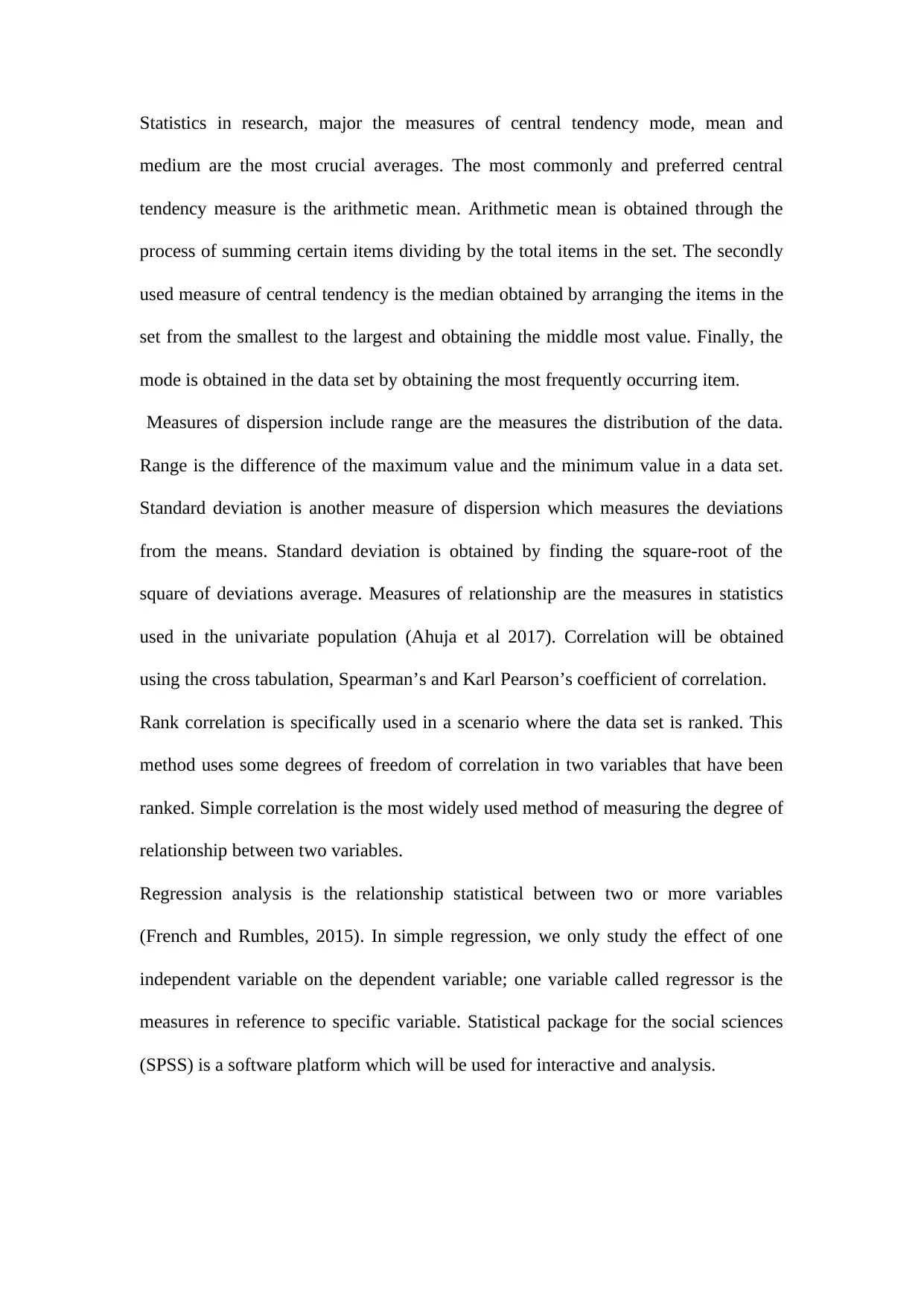
Statistics in research, major the measures of central tendency mode, mean and
medium are the most crucial averages. The most commonly and preferred central
tendency measure is the arithmetic mean. Arithmetic mean is obtained through the
process of summing certain items dividing by the total items in the set. The secondly
used measure of central tendency is the median obtained by arranging the items in the
set from the smallest to the largest and obtaining the middle most value. Finally, the
mode is obtained in the data set by obtaining the most frequently occurring item.
Measures of dispersion include range are the measures the distribution of the data.
Range is the difference of the maximum value and the minimum value in a data set.
Standard deviation is another measure of dispersion which measures the deviations
from the means. Standard deviation is obtained by finding the square-root of the
square of deviations average. Measures of relationship are the measures in statistics
used in the univariate population (Ahuja et al 2017). Correlation will be obtained
using the cross tabulation, Spearman’s and Karl Pearson’s coefficient of correlation.
Rank correlation is specifically used in a scenario where the data set is ranked. This
method uses some degrees of freedom of correlation in two variables that have been
ranked. Simple correlation is the most widely used method of measuring the degree of
relationship between two variables.
Regression analysis is the relationship statistical between two or more variables
(French and Rumbles, 2015). In simple regression, we only study the effect of one
independent variable on the dependent variable; one variable called regressor is the
measures in reference to specific variable. Statistical package for the social sciences
(SPSS) is a software platform which will be used for interactive and analysis.
medium are the most crucial averages. The most commonly and preferred central
tendency measure is the arithmetic mean. Arithmetic mean is obtained through the
process of summing certain items dividing by the total items in the set. The secondly
used measure of central tendency is the median obtained by arranging the items in the
set from the smallest to the largest and obtaining the middle most value. Finally, the
mode is obtained in the data set by obtaining the most frequently occurring item.
Measures of dispersion include range are the measures the distribution of the data.
Range is the difference of the maximum value and the minimum value in a data set.
Standard deviation is another measure of dispersion which measures the deviations
from the means. Standard deviation is obtained by finding the square-root of the
square of deviations average. Measures of relationship are the measures in statistics
used in the univariate population (Ahuja et al 2017). Correlation will be obtained
using the cross tabulation, Spearman’s and Karl Pearson’s coefficient of correlation.
Rank correlation is specifically used in a scenario where the data set is ranked. This
method uses some degrees of freedom of correlation in two variables that have been
ranked. Simple correlation is the most widely used method of measuring the degree of
relationship between two variables.
Regression analysis is the relationship statistical between two or more variables
(French and Rumbles, 2015). In simple regression, we only study the effect of one
independent variable on the dependent variable; one variable called regressor is the
measures in reference to specific variable. Statistical package for the social sciences
(SPSS) is a software platform which will be used for interactive and analysis.
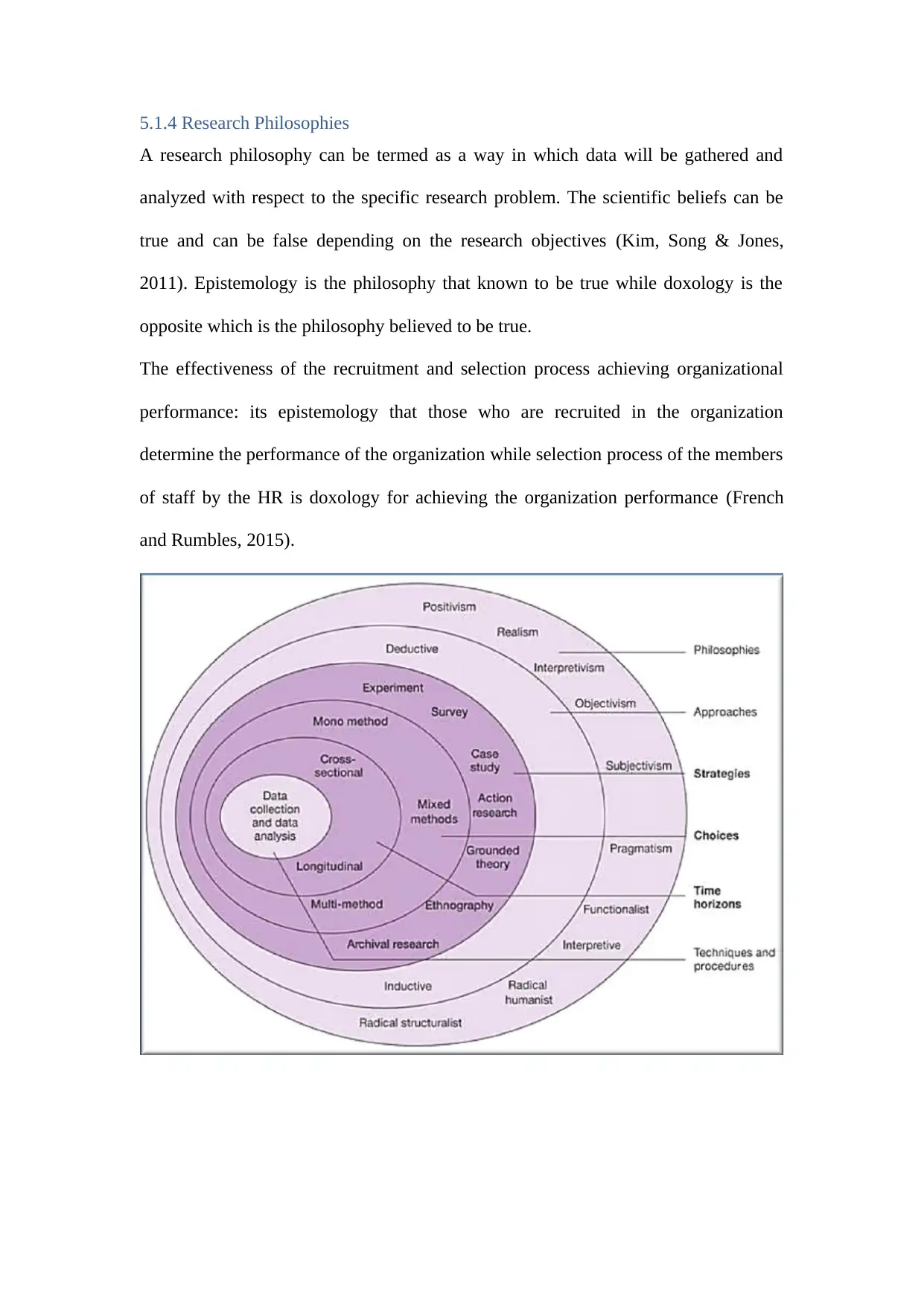
5.1.4 Research Philosophies
A research philosophy can be termed as a way in which data will be gathered and
analyzed with respect to the specific research problem. The scientific beliefs can be
true and can be false depending on the research objectives (Kim, Song & Jones,
2011). Epistemology is the philosophy that known to be true while doxology is the
opposite which is the philosophy believed to be true.
The effectiveness of the recruitment and selection process achieving organizational
performance: its epistemology that those who are recruited in the organization
determine the performance of the organization while selection process of the members
of staff by the HR is doxology for achieving the organization performance (French
and Rumbles, 2015).
A research philosophy can be termed as a way in which data will be gathered and
analyzed with respect to the specific research problem. The scientific beliefs can be
true and can be false depending on the research objectives (Kim, Song & Jones,
2011). Epistemology is the philosophy that known to be true while doxology is the
opposite which is the philosophy believed to be true.
The effectiveness of the recruitment and selection process achieving organizational
performance: its epistemology that those who are recruited in the organization
determine the performance of the organization while selection process of the members
of staff by the HR is doxology for achieving the organization performance (French
and Rumbles, 2015).
Secure Best Marks with AI Grader
Need help grading? Try our AI Grader for instant feedback on your assignments.
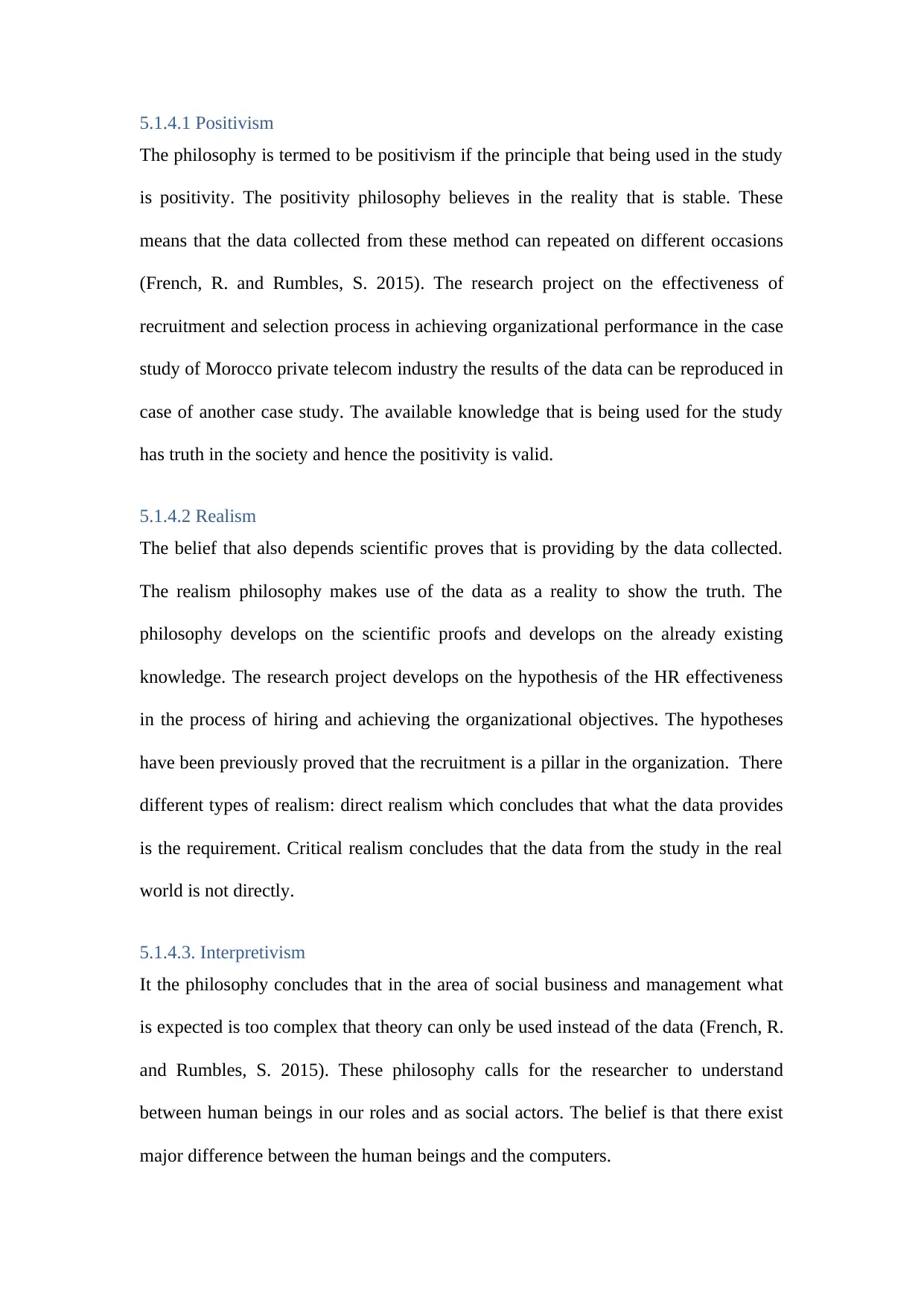
5.1.4.1 Positivism
The philosophy is termed to be positivism if the principle that being used in the study
is positivity. The positivity philosophy believes in the reality that is stable. These
means that the data collected from these method can repeated on different occasions
(French, R. and Rumbles, S. 2015). The research project on the effectiveness of
recruitment and selection process in achieving organizational performance in the case
study of Morocco private telecom industry the results of the data can be reproduced in
case of another case study. The available knowledge that is being used for the study
has truth in the society and hence the positivity is valid.
5.1.4.2 Realism
The belief that also depends scientific proves that is providing by the data collected.
The realism philosophy makes use of the data as a reality to show the truth. The
philosophy develops on the scientific proofs and develops on the already existing
knowledge. The research project develops on the hypothesis of the HR effectiveness
in the process of hiring and achieving the organizational objectives. The hypotheses
have been previously proved that the recruitment is a pillar in the organization. There
different types of realism: direct realism which concludes that what the data provides
is the requirement. Critical realism concludes that the data from the study in the real
world is not directly.
5.1.4.3. Interpretivism
It the philosophy concludes that in the area of social business and management what
is expected is too complex that theory can only be used instead of the data (French, R.
and Rumbles, S. 2015). These philosophy calls for the researcher to understand
between human beings in our roles and as social actors. The belief is that there exist
major difference between the human beings and the computers.
The philosophy is termed to be positivism if the principle that being used in the study
is positivity. The positivity philosophy believes in the reality that is stable. These
means that the data collected from these method can repeated on different occasions
(French, R. and Rumbles, S. 2015). The research project on the effectiveness of
recruitment and selection process in achieving organizational performance in the case
study of Morocco private telecom industry the results of the data can be reproduced in
case of another case study. The available knowledge that is being used for the study
has truth in the society and hence the positivity is valid.
5.1.4.2 Realism
The belief that also depends scientific proves that is providing by the data collected.
The realism philosophy makes use of the data as a reality to show the truth. The
philosophy develops on the scientific proofs and develops on the already existing
knowledge. The research project develops on the hypothesis of the HR effectiveness
in the process of hiring and achieving the organizational objectives. The hypotheses
have been previously proved that the recruitment is a pillar in the organization. There
different types of realism: direct realism which concludes that what the data provides
is the requirement. Critical realism concludes that the data from the study in the real
world is not directly.
5.1.4.3. Interpretivism
It the philosophy concludes that in the area of social business and management what
is expected is too complex that theory can only be used instead of the data (French, R.
and Rumbles, S. 2015). These philosophy calls for the researcher to understand
between human beings in our roles and as social actors. The belief is that there exist
major difference between the human beings and the computers.
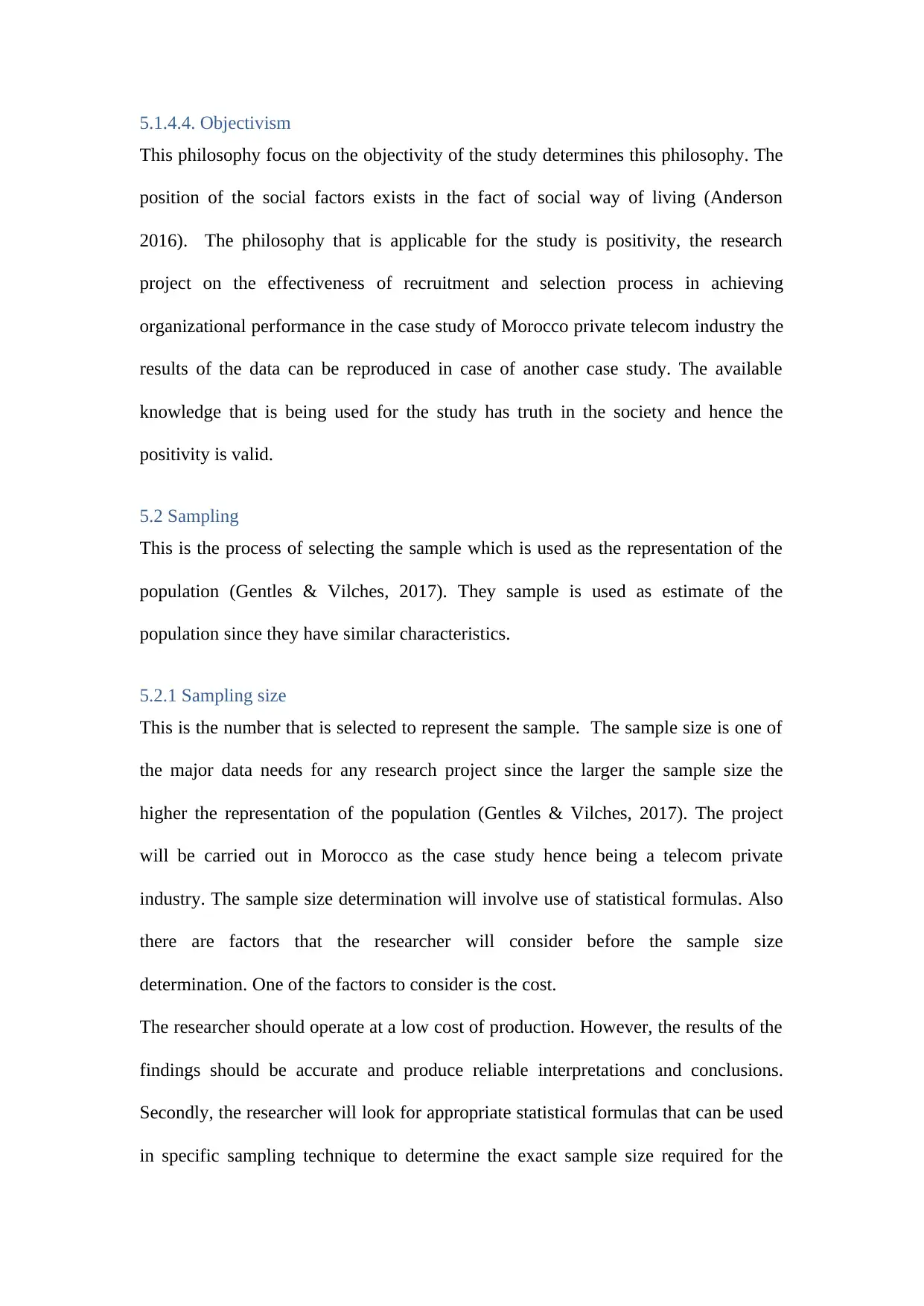
5.1.4.4. Objectivism
This philosophy focus on the objectivity of the study determines this philosophy. The
position of the social factors exists in the fact of social way of living (Anderson
2016). The philosophy that is applicable for the study is positivity, the research
project on the effectiveness of recruitment and selection process in achieving
organizational performance in the case study of Morocco private telecom industry the
results of the data can be reproduced in case of another case study. The available
knowledge that is being used for the study has truth in the society and hence the
positivity is valid.
5.2 Sampling
This is the process of selecting the sample which is used as the representation of the
population (Gentles & Vilches, 2017). They sample is used as estimate of the
population since they have similar characteristics.
5.2.1 Sampling size
This is the number that is selected to represent the sample. The sample size is one of
the major data needs for any research project since the larger the sample size the
higher the representation of the population (Gentles & Vilches, 2017). The project
will be carried out in Morocco as the case study hence being a telecom private
industry. The sample size determination will involve use of statistical formulas. Also
there are factors that the researcher will consider before the sample size
determination. One of the factors to consider is the cost.
The researcher should operate at a low cost of production. However, the results of the
findings should be accurate and produce reliable interpretations and conclusions.
Secondly, the researcher will look for appropriate statistical formulas that can be used
in specific sampling technique to determine the exact sample size required for the
This philosophy focus on the objectivity of the study determines this philosophy. The
position of the social factors exists in the fact of social way of living (Anderson
2016). The philosophy that is applicable for the study is positivity, the research
project on the effectiveness of recruitment and selection process in achieving
organizational performance in the case study of Morocco private telecom industry the
results of the data can be reproduced in case of another case study. The available
knowledge that is being used for the study has truth in the society and hence the
positivity is valid.
5.2 Sampling
This is the process of selecting the sample which is used as the representation of the
population (Gentles & Vilches, 2017). They sample is used as estimate of the
population since they have similar characteristics.
5.2.1 Sampling size
This is the number that is selected to represent the sample. The sample size is one of
the major data needs for any research project since the larger the sample size the
higher the representation of the population (Gentles & Vilches, 2017). The project
will be carried out in Morocco as the case study hence being a telecom private
industry. The sample size determination will involve use of statistical formulas. Also
there are factors that the researcher will consider before the sample size
determination. One of the factors to consider is the cost.
The researcher should operate at a low cost of production. However, the results of the
findings should be accurate and produce reliable interpretations and conclusions.
Secondly, the researcher will look for appropriate statistical formulas that can be used
in specific sampling technique to determine the exact sample size required for the
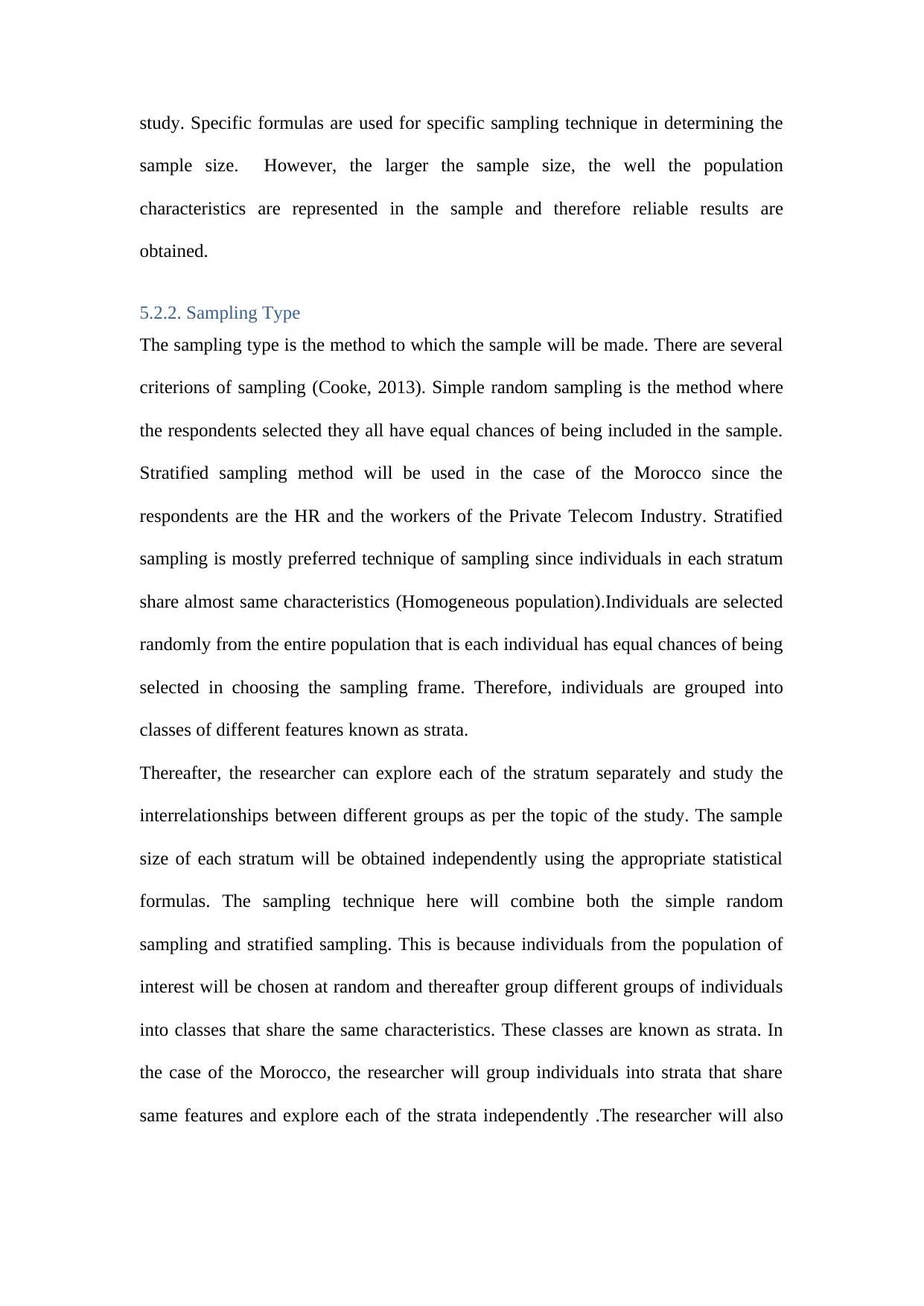
study. Specific formulas are used for specific sampling technique in determining the
sample size. However, the larger the sample size, the well the population
characteristics are represented in the sample and therefore reliable results are
obtained.
5.2.2. Sampling Type
The sampling type is the method to which the sample will be made. There are several
criterions of sampling (Cooke, 2013). Simple random sampling is the method where
the respondents selected they all have equal chances of being included in the sample.
Stratified sampling method will be used in the case of the Morocco since the
respondents are the HR and the workers of the Private Telecom Industry. Stratified
sampling is mostly preferred technique of sampling since individuals in each stratum
share almost same characteristics (Homogeneous population).Individuals are selected
randomly from the entire population that is each individual has equal chances of being
selected in choosing the sampling frame. Therefore, individuals are grouped into
classes of different features known as strata.
Thereafter, the researcher can explore each of the stratum separately and study the
interrelationships between different groups as per the topic of the study. The sample
size of each stratum will be obtained independently using the appropriate statistical
formulas. The sampling technique here will combine both the simple random
sampling and stratified sampling. This is because individuals from the population of
interest will be chosen at random and thereafter group different groups of individuals
into classes that share the same characteristics. These classes are known as strata. In
the case of the Morocco, the researcher will group individuals into strata that share
same features and explore each of the strata independently .The researcher will also
sample size. However, the larger the sample size, the well the population
characteristics are represented in the sample and therefore reliable results are
obtained.
5.2.2. Sampling Type
The sampling type is the method to which the sample will be made. There are several
criterions of sampling (Cooke, 2013). Simple random sampling is the method where
the respondents selected they all have equal chances of being included in the sample.
Stratified sampling method will be used in the case of the Morocco since the
respondents are the HR and the workers of the Private Telecom Industry. Stratified
sampling is mostly preferred technique of sampling since individuals in each stratum
share almost same characteristics (Homogeneous population).Individuals are selected
randomly from the entire population that is each individual has equal chances of being
selected in choosing the sampling frame. Therefore, individuals are grouped into
classes of different features known as strata.
Thereafter, the researcher can explore each of the stratum separately and study the
interrelationships between different groups as per the topic of the study. The sample
size of each stratum will be obtained independently using the appropriate statistical
formulas. The sampling technique here will combine both the simple random
sampling and stratified sampling. This is because individuals from the population of
interest will be chosen at random and thereafter group different groups of individuals
into classes that share the same characteristics. These classes are known as strata. In
the case of the Morocco, the researcher will group individuals into strata that share
same features and explore each of the strata independently .The researcher will also
Paraphrase This Document
Need a fresh take? Get an instant paraphrase of this document with our AI Paraphraser
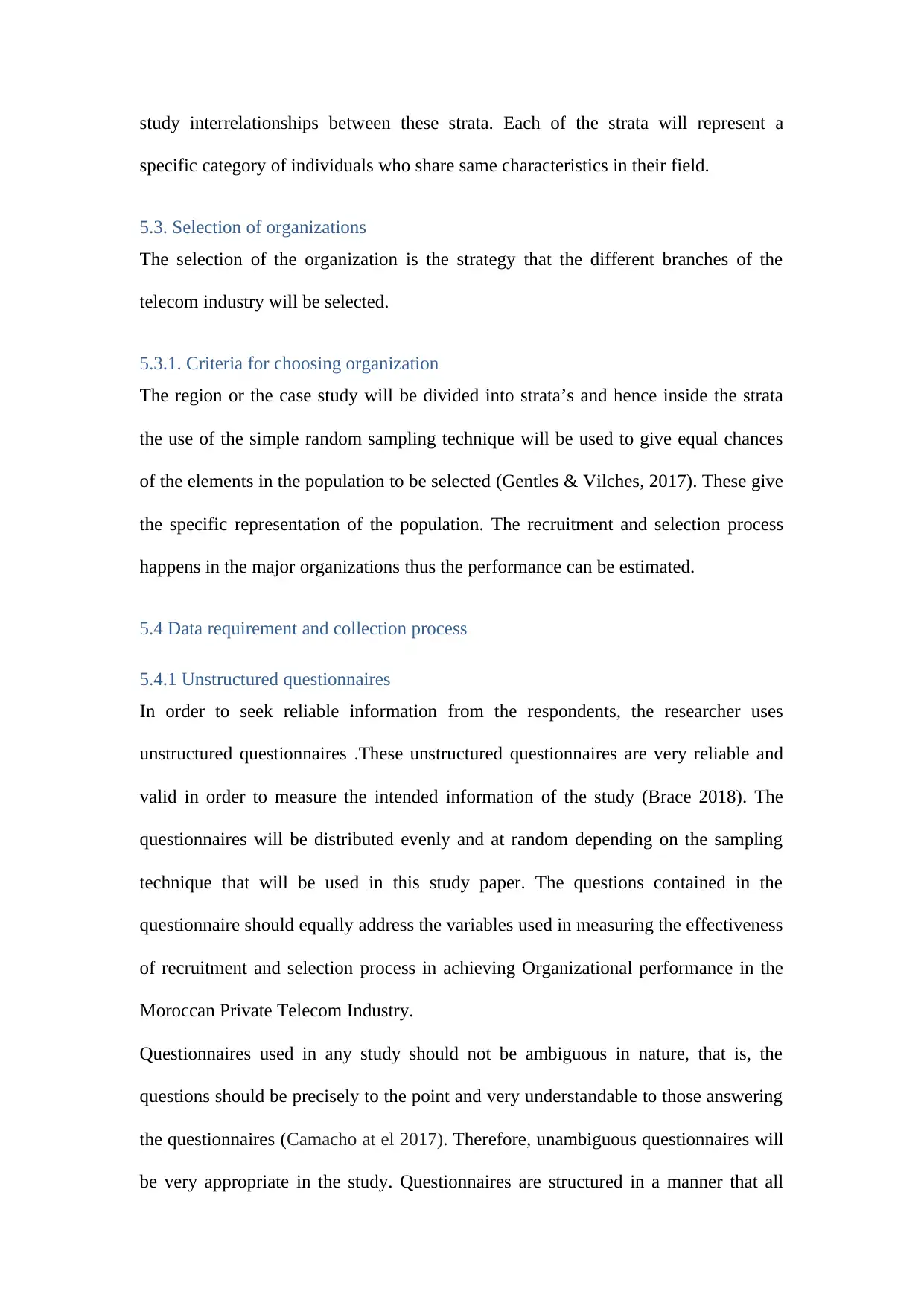
study interrelationships between these strata. Each of the strata will represent a
specific category of individuals who share same characteristics in their field.
5.3. Selection of organizations
The selection of the organization is the strategy that the different branches of the
telecom industry will be selected.
5.3.1. Criteria for choosing organization
The region or the case study will be divided into strata’s and hence inside the strata
the use of the simple random sampling technique will be used to give equal chances
of the elements in the population to be selected (Gentles & Vilches, 2017). These give
the specific representation of the population. The recruitment and selection process
happens in the major organizations thus the performance can be estimated.
5.4 Data requirement and collection process
5.4.1 Unstructured questionnaires
In order to seek reliable information from the respondents, the researcher uses
unstructured questionnaires .These unstructured questionnaires are very reliable and
valid in order to measure the intended information of the study (Brace 2018). The
questionnaires will be distributed evenly and at random depending on the sampling
technique that will be used in this study paper. The questions contained in the
questionnaire should equally address the variables used in measuring the effectiveness
of recruitment and selection process in achieving Organizational performance in the
Moroccan Private Telecom Industry.
Questionnaires used in any study should not be ambiguous in nature, that is, the
questions should be precisely to the point and very understandable to those answering
the questionnaires (Camacho at el 2017). Therefore, unambiguous questionnaires will
be very appropriate in the study. Questionnaires are structured in a manner that all
specific category of individuals who share same characteristics in their field.
5.3. Selection of organizations
The selection of the organization is the strategy that the different branches of the
telecom industry will be selected.
5.3.1. Criteria for choosing organization
The region or the case study will be divided into strata’s and hence inside the strata
the use of the simple random sampling technique will be used to give equal chances
of the elements in the population to be selected (Gentles & Vilches, 2017). These give
the specific representation of the population. The recruitment and selection process
happens in the major organizations thus the performance can be estimated.
5.4 Data requirement and collection process
5.4.1 Unstructured questionnaires
In order to seek reliable information from the respondents, the researcher uses
unstructured questionnaires .These unstructured questionnaires are very reliable and
valid in order to measure the intended information of the study (Brace 2018). The
questionnaires will be distributed evenly and at random depending on the sampling
technique that will be used in this study paper. The questions contained in the
questionnaire should equally address the variables used in measuring the effectiveness
of recruitment and selection process in achieving Organizational performance in the
Moroccan Private Telecom Industry.
Questionnaires used in any study should not be ambiguous in nature, that is, the
questions should be precisely to the point and very understandable to those answering
the questionnaires (Camacho at el 2017). Therefore, unambiguous questionnaires will
be very appropriate in the study. Questionnaires are structured in a manner that all
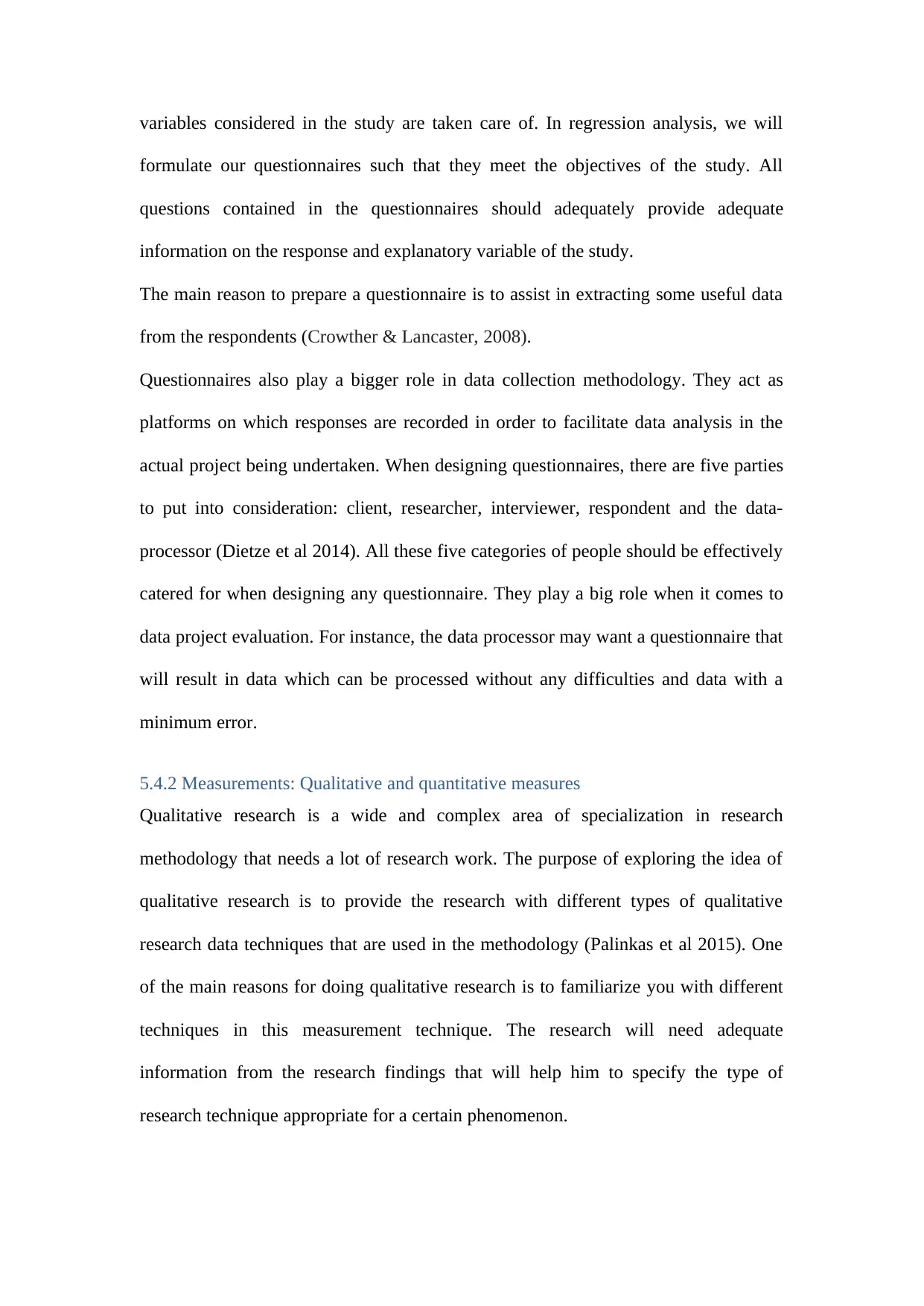
variables considered in the study are taken care of. In regression analysis, we will
formulate our questionnaires such that they meet the objectives of the study. All
questions contained in the questionnaires should adequately provide adequate
information on the response and explanatory variable of the study.
The main reason to prepare a questionnaire is to assist in extracting some useful data
from the respondents (Crowther & Lancaster, 2008).
Questionnaires also play a bigger role in data collection methodology. They act as
platforms on which responses are recorded in order to facilitate data analysis in the
actual project being undertaken. When designing questionnaires, there are five parties
to put into consideration: client, researcher, interviewer, respondent and the data-
processor (Dietze et al 2014). All these five categories of people should be effectively
catered for when designing any questionnaire. They play a big role when it comes to
data project evaluation. For instance, the data processor may want a questionnaire that
will result in data which can be processed without any difficulties and data with a
minimum error.
5.4.2 Measurements: Qualitative and quantitative measures
Qualitative research is a wide and complex area of specialization in research
methodology that needs a lot of research work. The purpose of exploring the idea of
qualitative research is to provide the research with different types of qualitative
research data techniques that are used in the methodology (Palinkas et al 2015). One
of the main reasons for doing qualitative research is to familiarize you with different
techniques in this measurement technique. The research will need adequate
information from the research findings that will help him to specify the type of
research technique appropriate for a certain phenomenon.
formulate our questionnaires such that they meet the objectives of the study. All
questions contained in the questionnaires should adequately provide adequate
information on the response and explanatory variable of the study.
The main reason to prepare a questionnaire is to assist in extracting some useful data
from the respondents (Crowther & Lancaster, 2008).
Questionnaires also play a bigger role in data collection methodology. They act as
platforms on which responses are recorded in order to facilitate data analysis in the
actual project being undertaken. When designing questionnaires, there are five parties
to put into consideration: client, researcher, interviewer, respondent and the data-
processor (Dietze et al 2014). All these five categories of people should be effectively
catered for when designing any questionnaire. They play a big role when it comes to
data project evaluation. For instance, the data processor may want a questionnaire that
will result in data which can be processed without any difficulties and data with a
minimum error.
5.4.2 Measurements: Qualitative and quantitative measures
Qualitative research is a wide and complex area of specialization in research
methodology that needs a lot of research work. The purpose of exploring the idea of
qualitative research is to provide the research with different types of qualitative
research data techniques that are used in the methodology (Palinkas et al 2015). One
of the main reasons for doing qualitative research is to familiarize you with different
techniques in this measurement technique. The research will need adequate
information from the research findings that will help him to specify the type of
research technique appropriate for a certain phenomenon.
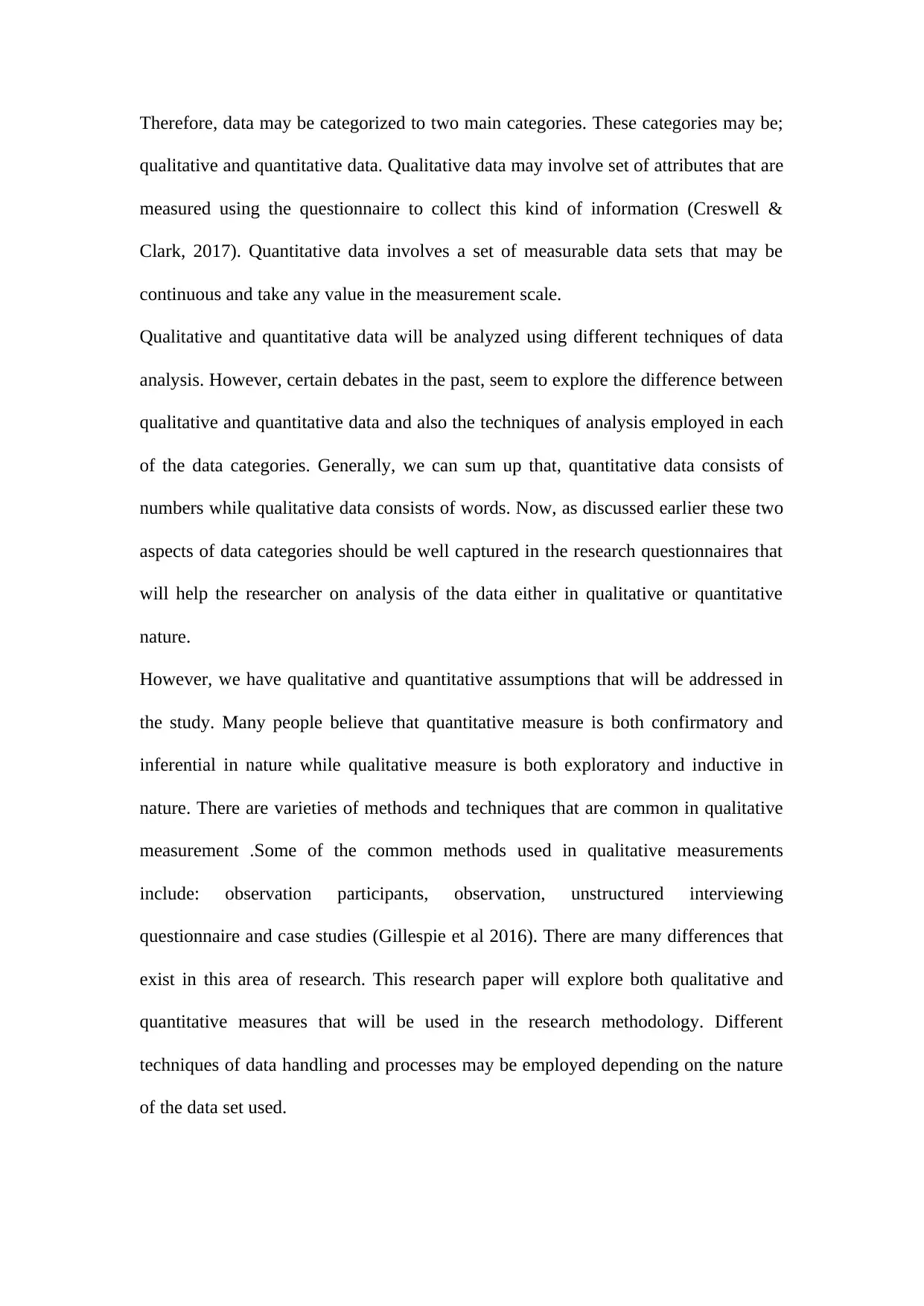
Therefore, data may be categorized to two main categories. These categories may be;
qualitative and quantitative data. Qualitative data may involve set of attributes that are
measured using the questionnaire to collect this kind of information (Creswell &
Clark, 2017). Quantitative data involves a set of measurable data sets that may be
continuous and take any value in the measurement scale.
Qualitative and quantitative data will be analyzed using different techniques of data
analysis. However, certain debates in the past, seem to explore the difference between
qualitative and quantitative data and also the techniques of analysis employed in each
of the data categories. Generally, we can sum up that, quantitative data consists of
numbers while qualitative data consists of words. Now, as discussed earlier these two
aspects of data categories should be well captured in the research questionnaires that
will help the researcher on analysis of the data either in qualitative or quantitative
nature.
However, we have qualitative and quantitative assumptions that will be addressed in
the study. Many people believe that quantitative measure is both confirmatory and
inferential in nature while qualitative measure is both exploratory and inductive in
nature. There are varieties of methods and techniques that are common in qualitative
measurement .Some of the common methods used in qualitative measurements
include: observation participants, observation, unstructured interviewing
questionnaire and case studies (Gillespie et al 2016). There are many differences that
exist in this area of research. This research paper will explore both qualitative and
quantitative measures that will be used in the research methodology. Different
techniques of data handling and processes may be employed depending on the nature
of the data set used.
qualitative and quantitative data. Qualitative data may involve set of attributes that are
measured using the questionnaire to collect this kind of information (Creswell &
Clark, 2017). Quantitative data involves a set of measurable data sets that may be
continuous and take any value in the measurement scale.
Qualitative and quantitative data will be analyzed using different techniques of data
analysis. However, certain debates in the past, seem to explore the difference between
qualitative and quantitative data and also the techniques of analysis employed in each
of the data categories. Generally, we can sum up that, quantitative data consists of
numbers while qualitative data consists of words. Now, as discussed earlier these two
aspects of data categories should be well captured in the research questionnaires that
will help the researcher on analysis of the data either in qualitative or quantitative
nature.
However, we have qualitative and quantitative assumptions that will be addressed in
the study. Many people believe that quantitative measure is both confirmatory and
inferential in nature while qualitative measure is both exploratory and inductive in
nature. There are varieties of methods and techniques that are common in qualitative
measurement .Some of the common methods used in qualitative measurements
include: observation participants, observation, unstructured interviewing
questionnaire and case studies (Gillespie et al 2016). There are many differences that
exist in this area of research. This research paper will explore both qualitative and
quantitative measures that will be used in the research methodology. Different
techniques of data handling and processes may be employed depending on the nature
of the data set used.
Secure Best Marks with AI Grader
Need help grading? Try our AI Grader for instant feedback on your assignments.
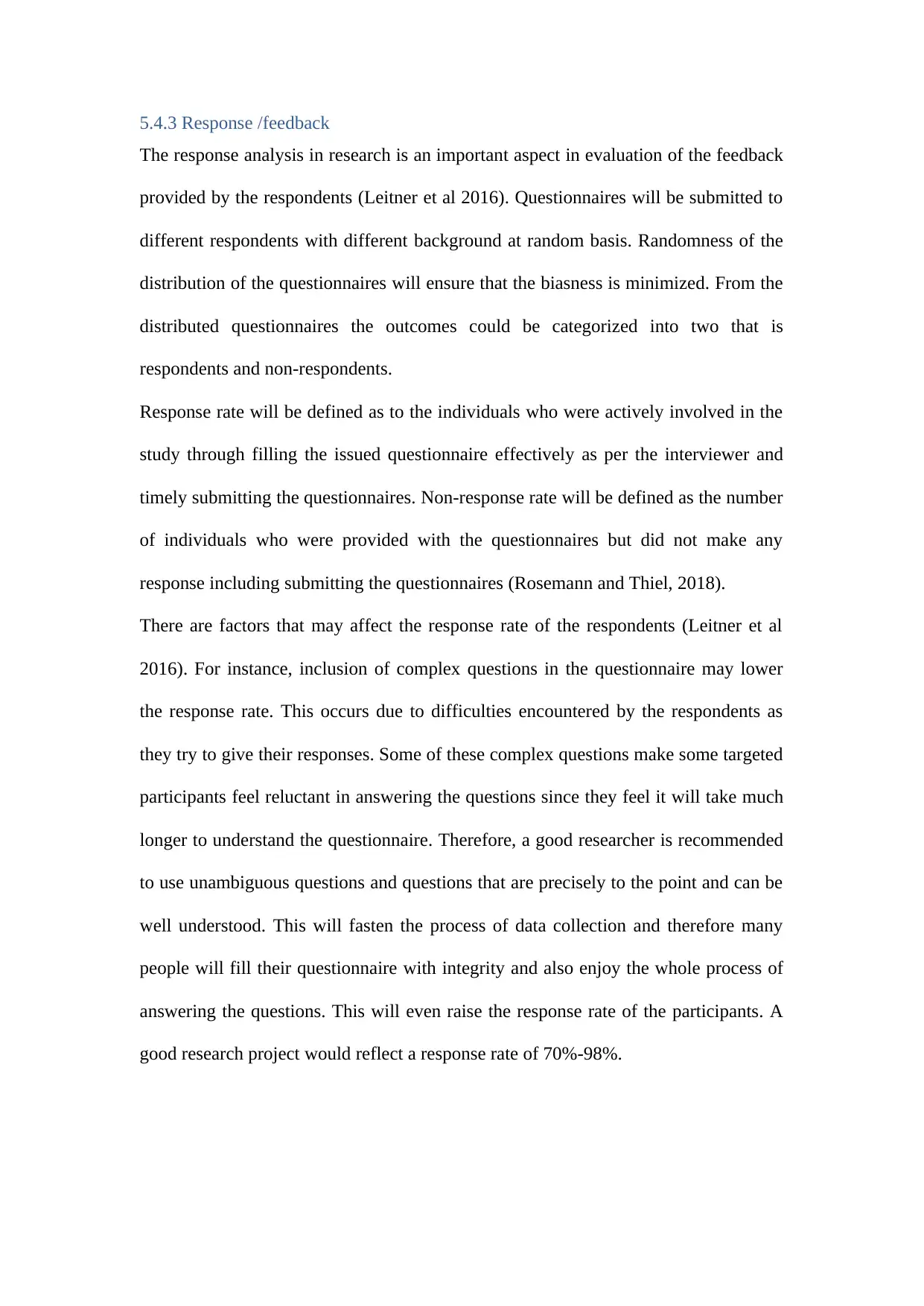
5.4.3 Response /feedback
The response analysis in research is an important aspect in evaluation of the feedback
provided by the respondents (Leitner et al 2016). Questionnaires will be submitted to
different respondents with different background at random basis. Randomness of the
distribution of the questionnaires will ensure that the biasness is minimized. From the
distributed questionnaires the outcomes could be categorized into two that is
respondents and non-respondents.
Response rate will be defined as to the individuals who were actively involved in the
study through filling the issued questionnaire effectively as per the interviewer and
timely submitting the questionnaires. Non-response rate will be defined as the number
of individuals who were provided with the questionnaires but did not make any
response including submitting the questionnaires (Rosemann and Thiel, 2018).
There are factors that may affect the response rate of the respondents (Leitner et al
2016). For instance, inclusion of complex questions in the questionnaire may lower
the response rate. This occurs due to difficulties encountered by the respondents as
they try to give their responses. Some of these complex questions make some targeted
participants feel reluctant in answering the questions since they feel it will take much
longer to understand the questionnaire. Therefore, a good researcher is recommended
to use unambiguous questions and questions that are precisely to the point and can be
well understood. This will fasten the process of data collection and therefore many
people will fill their questionnaire with integrity and also enjoy the whole process of
answering the questions. This will even raise the response rate of the participants. A
good research project would reflect a response rate of 70%-98%.
The response analysis in research is an important aspect in evaluation of the feedback
provided by the respondents (Leitner et al 2016). Questionnaires will be submitted to
different respondents with different background at random basis. Randomness of the
distribution of the questionnaires will ensure that the biasness is minimized. From the
distributed questionnaires the outcomes could be categorized into two that is
respondents and non-respondents.
Response rate will be defined as to the individuals who were actively involved in the
study through filling the issued questionnaire effectively as per the interviewer and
timely submitting the questionnaires. Non-response rate will be defined as the number
of individuals who were provided with the questionnaires but did not make any
response including submitting the questionnaires (Rosemann and Thiel, 2018).
There are factors that may affect the response rate of the respondents (Leitner et al
2016). For instance, inclusion of complex questions in the questionnaire may lower
the response rate. This occurs due to difficulties encountered by the respondents as
they try to give their responses. Some of these complex questions make some targeted
participants feel reluctant in answering the questions since they feel it will take much
longer to understand the questionnaire. Therefore, a good researcher is recommended
to use unambiguous questions and questions that are precisely to the point and can be
well understood. This will fasten the process of data collection and therefore many
people will fill their questionnaire with integrity and also enjoy the whole process of
answering the questions. This will even raise the response rate of the participants. A
good research project would reflect a response rate of 70%-98%.
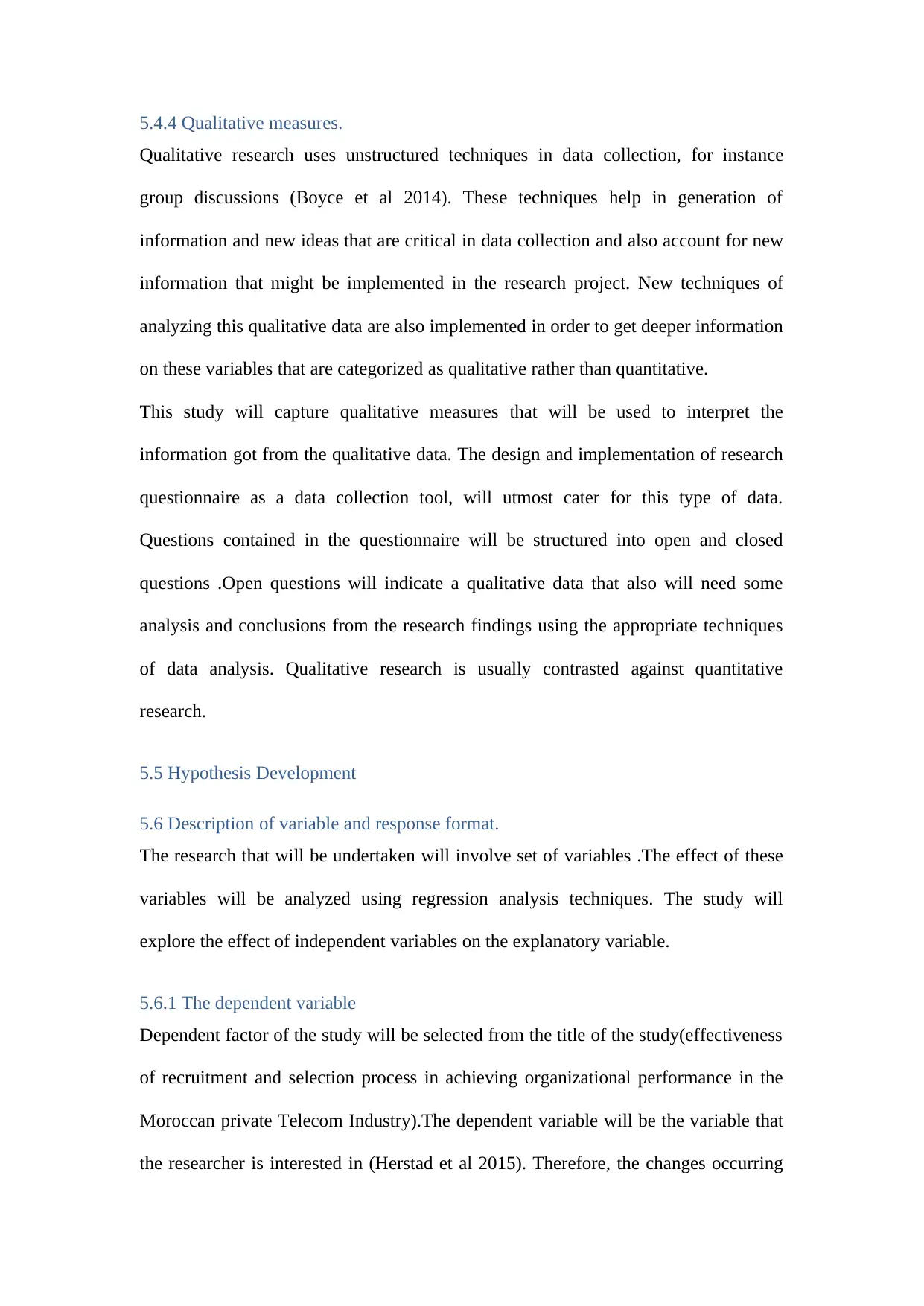
5.4.4 Qualitative measures.
Qualitative research uses unstructured techniques in data collection, for instance
group discussions (Boyce et al 2014). These techniques help in generation of
information and new ideas that are critical in data collection and also account for new
information that might be implemented in the research project. New techniques of
analyzing this qualitative data are also implemented in order to get deeper information
on these variables that are categorized as qualitative rather than quantitative.
This study will capture qualitative measures that will be used to interpret the
information got from the qualitative data. The design and implementation of research
questionnaire as a data collection tool, will utmost cater for this type of data.
Questions contained in the questionnaire will be structured into open and closed
questions .Open questions will indicate a qualitative data that also will need some
analysis and conclusions from the research findings using the appropriate techniques
of data analysis. Qualitative research is usually contrasted against quantitative
research.
5.5 Hypothesis Development
5.6 Description of variable and response format.
The research that will be undertaken will involve set of variables .The effect of these
variables will be analyzed using regression analysis techniques. The study will
explore the effect of independent variables on the explanatory variable.
5.6.1 The dependent variable
Dependent factor of the study will be selected from the title of the study(effectiveness
of recruitment and selection process in achieving organizational performance in the
Moroccan private Telecom Industry).The dependent variable will be the variable that
the researcher is interested in (Herstad et al 2015). Therefore, the changes occurring
Qualitative research uses unstructured techniques in data collection, for instance
group discussions (Boyce et al 2014). These techniques help in generation of
information and new ideas that are critical in data collection and also account for new
information that might be implemented in the research project. New techniques of
analyzing this qualitative data are also implemented in order to get deeper information
on these variables that are categorized as qualitative rather than quantitative.
This study will capture qualitative measures that will be used to interpret the
information got from the qualitative data. The design and implementation of research
questionnaire as a data collection tool, will utmost cater for this type of data.
Questions contained in the questionnaire will be structured into open and closed
questions .Open questions will indicate a qualitative data that also will need some
analysis and conclusions from the research findings using the appropriate techniques
of data analysis. Qualitative research is usually contrasted against quantitative
research.
5.5 Hypothesis Development
5.6 Description of variable and response format.
The research that will be undertaken will involve set of variables .The effect of these
variables will be analyzed using regression analysis techniques. The study will
explore the effect of independent variables on the explanatory variable.
5.6.1 The dependent variable
Dependent factor of the study will be selected from the title of the study(effectiveness
of recruitment and selection process in achieving organizational performance in the
Moroccan private Telecom Industry).The dependent variable will be the variable that
the researcher is interested in (Herstad et al 2015). Therefore, the changes occurring
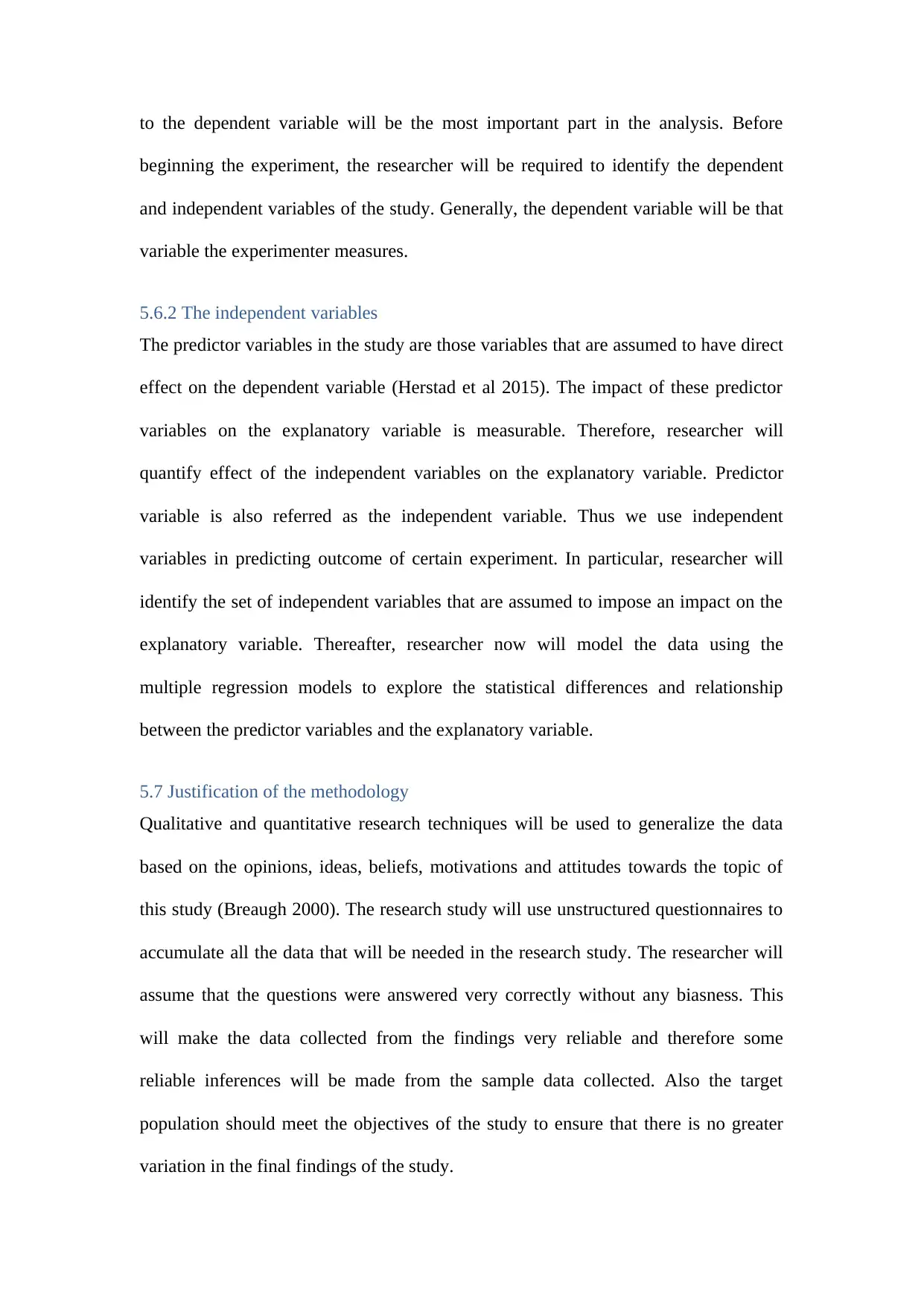
to the dependent variable will be the most important part in the analysis. Before
beginning the experiment, the researcher will be required to identify the dependent
and independent variables of the study. Generally, the dependent variable will be that
variable the experimenter measures.
5.6.2 The independent variables
The predictor variables in the study are those variables that are assumed to have direct
effect on the dependent variable (Herstad et al 2015). The impact of these predictor
variables on the explanatory variable is measurable. Therefore, researcher will
quantify effect of the independent variables on the explanatory variable. Predictor
variable is also referred as the independent variable. Thus we use independent
variables in predicting outcome of certain experiment. In particular, researcher will
identify the set of independent variables that are assumed to impose an impact on the
explanatory variable. Thereafter, researcher now will model the data using the
multiple regression models to explore the statistical differences and relationship
between the predictor variables and the explanatory variable.
5.7 Justification of the methodology
Qualitative and quantitative research techniques will be used to generalize the data
based on the opinions, ideas, beliefs, motivations and attitudes towards the topic of
this study (Breaugh 2000). The research study will use unstructured questionnaires to
accumulate all the data that will be needed in the research study. The researcher will
assume that the questions were answered very correctly without any biasness. This
will make the data collected from the findings very reliable and therefore some
reliable inferences will be made from the sample data collected. Also the target
population should meet the objectives of the study to ensure that there is no greater
variation in the final findings of the study.
beginning the experiment, the researcher will be required to identify the dependent
and independent variables of the study. Generally, the dependent variable will be that
variable the experimenter measures.
5.6.2 The independent variables
The predictor variables in the study are those variables that are assumed to have direct
effect on the dependent variable (Herstad et al 2015). The impact of these predictor
variables on the explanatory variable is measurable. Therefore, researcher will
quantify effect of the independent variables on the explanatory variable. Predictor
variable is also referred as the independent variable. Thus we use independent
variables in predicting outcome of certain experiment. In particular, researcher will
identify the set of independent variables that are assumed to impose an impact on the
explanatory variable. Thereafter, researcher now will model the data using the
multiple regression models to explore the statistical differences and relationship
between the predictor variables and the explanatory variable.
5.7 Justification of the methodology
Qualitative and quantitative research techniques will be used to generalize the data
based on the opinions, ideas, beliefs, motivations and attitudes towards the topic of
this study (Breaugh 2000). The research study will use unstructured questionnaires to
accumulate all the data that will be needed in the research study. The researcher will
assume that the questions were answered very correctly without any biasness. This
will make the data collected from the findings very reliable and therefore some
reliable inferences will be made from the sample data collected. Also the target
population should meet the objectives of the study to ensure that there is no greater
variation in the final findings of the study.
Paraphrase This Document
Need a fresh take? Get an instant paraphrase of this document with our AI Paraphraser

One will gain a deeper insight as to what happens on the dependent or explanatory
variable after manipulation of the information from the independent variables. The
regression model will address the impact of the predictor variables on the explanatory
variable. The value of R-squared in the regression model will measure the adequacy
of the model, whether the information given fits the data appropriately. A bigger
value of R-squared will indicate that the model is good and therefore can be used in
forecasting /predicting the outcome of the experiment using the underlying
independent variables of the study.
5.8 Validity and reliability
Data gathered from unstructured questionnaires will be determined that they are
reliable since if the act is to be repeated more than twice the same information will be
obtained. Reliability is the act that measure the consistency of the results that given by
a score test (Mansi et al 2013). The effectiveness of recruitment and selection process
in achieving the organizational performance the case study of Morocco Private
Industry if a different location was to be selected then the same results would be
obtained.
The research project will determine the reliability using the Cronbach’s alpha to
measure the internal reliability where the alpha lies between 0 and 1(Mansi et al
2013). The larger the alpha the higher the internal consistency of the variable of study,
coefficients like the Pearson”s correlation can be used to determine the correlation in
the variables.
The validity of the instruments of measurement is also crucial in the study. The area
of validity of the research project will be determined from the start which involves the
criterion validity, the internal validity, external validity, the sampling validity and the
statistical conclusion validity. The internal validity will be determined using the
variable after manipulation of the information from the independent variables. The
regression model will address the impact of the predictor variables on the explanatory
variable. The value of R-squared in the regression model will measure the adequacy
of the model, whether the information given fits the data appropriately. A bigger
value of R-squared will indicate that the model is good and therefore can be used in
forecasting /predicting the outcome of the experiment using the underlying
independent variables of the study.
5.8 Validity and reliability
Data gathered from unstructured questionnaires will be determined that they are
reliable since if the act is to be repeated more than twice the same information will be
obtained. Reliability is the act that measure the consistency of the results that given by
a score test (Mansi et al 2013). The effectiveness of recruitment and selection process
in achieving the organizational performance the case study of Morocco Private
Industry if a different location was to be selected then the same results would be
obtained.
The research project will determine the reliability using the Cronbach’s alpha to
measure the internal reliability where the alpha lies between 0 and 1(Mansi et al
2013). The larger the alpha the higher the internal consistency of the variable of study,
coefficients like the Pearson”s correlation can be used to determine the correlation in
the variables.
The validity of the instruments of measurement is also crucial in the study. The area
of validity of the research project will be determined from the start which involves the
criterion validity, the internal validity, external validity, the sampling validity and the
statistical conclusion validity. The internal validity will be determined using the

correlation coefficients, the external validity will be determined using research works
on the selection process, sampling validity will be determine using the pilot study and
statistical conclusion validity will be determine through the use of critical values.
5.9 Limitations
The research project will experience some challenges that include:
The study will focus effectiveness and the selection process which is the task
of the HR thus the objectives of the organization dependents of those who will
be hired.
The study will take place in Morocco which the telecom industry will be
selected as the case study, thus will not be actual representation of the
recruitment thus making conclusion will be a challenge.
The researcher will administer questionnaires and some of the members will
not be will to answer the questions that have been administered. Some of the
respondent who has been stratified selected thus means that the sample
selected will not have been attained.
The respondents may consider some of the information that is used in
employee selection process to be confidential thus need not to be disclosed.
Questionnaires will have spaces that during the analysis process these values
will be considered missing value that cause internal validity will be low.
The data collection process which will be administered will have the
movement from one location to another that will be time consuming. The
region under study is large and thus much time may be used in the process of
collecting data.
on the selection process, sampling validity will be determine using the pilot study and
statistical conclusion validity will be determine through the use of critical values.
5.9 Limitations
The research project will experience some challenges that include:
The study will focus effectiveness and the selection process which is the task
of the HR thus the objectives of the organization dependents of those who will
be hired.
The study will take place in Morocco which the telecom industry will be
selected as the case study, thus will not be actual representation of the
recruitment thus making conclusion will be a challenge.
The researcher will administer questionnaires and some of the members will
not be will to answer the questions that have been administered. Some of the
respondent who has been stratified selected thus means that the sample
selected will not have been attained.
The respondents may consider some of the information that is used in
employee selection process to be confidential thus need not to be disclosed.
Questionnaires will have spaces that during the analysis process these values
will be considered missing value that cause internal validity will be low.
The data collection process which will be administered will have the
movement from one location to another that will be time consuming. The
region under study is large and thus much time may be used in the process of
collecting data.
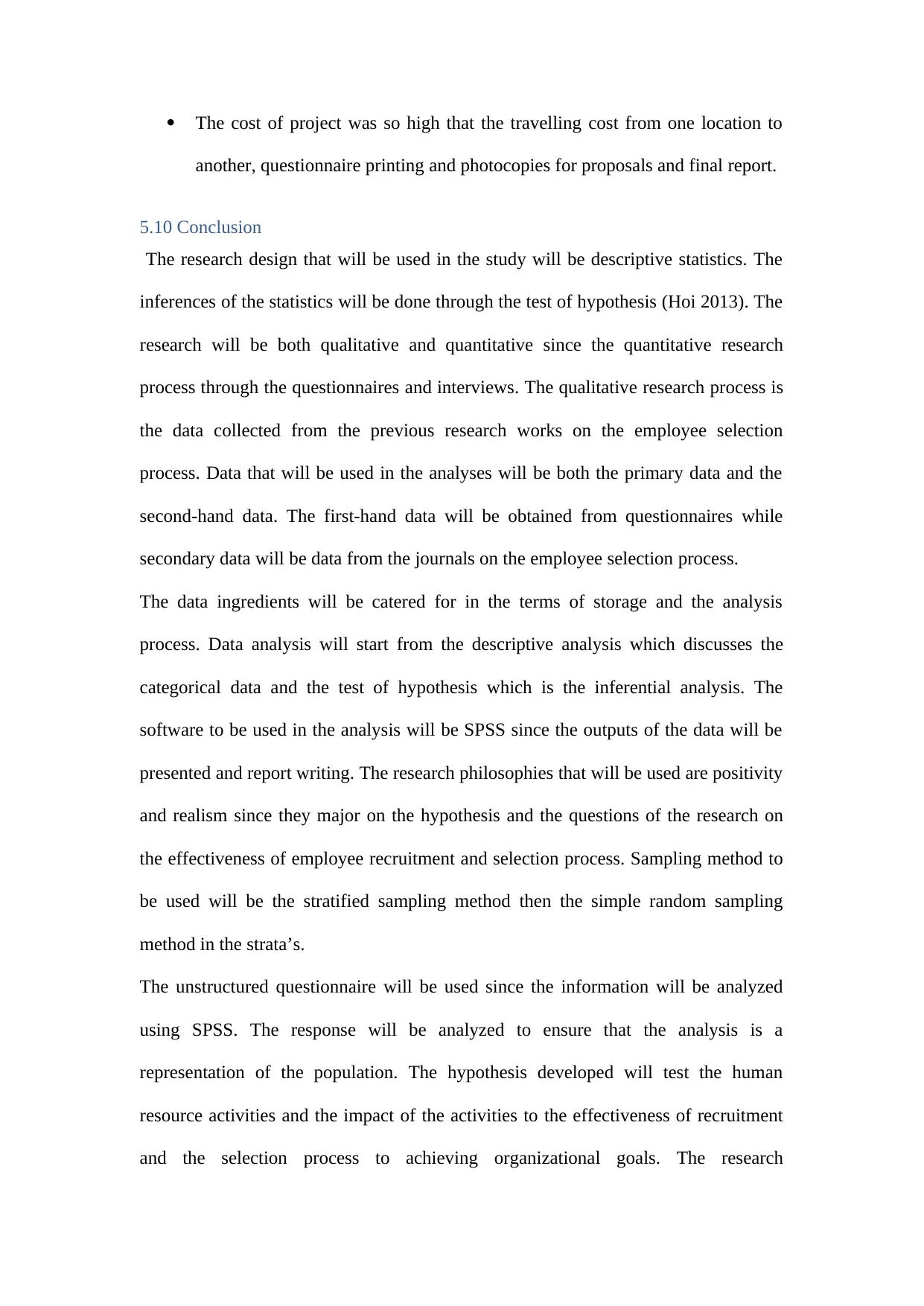
The cost of project was so high that the travelling cost from one location to
another, questionnaire printing and photocopies for proposals and final report.
5.10 Conclusion
The research design that will be used in the study will be descriptive statistics. The
inferences of the statistics will be done through the test of hypothesis (Hoi 2013). The
research will be both qualitative and quantitative since the quantitative research
process through the questionnaires and interviews. The qualitative research process is
the data collected from the previous research works on the employee selection
process. Data that will be used in the analyses will be both the primary data and the
second-hand data. The first-hand data will be obtained from questionnaires while
secondary data will be data from the journals on the employee selection process.
The data ingredients will be catered for in the terms of storage and the analysis
process. Data analysis will start from the descriptive analysis which discusses the
categorical data and the test of hypothesis which is the inferential analysis. The
software to be used in the analysis will be SPSS since the outputs of the data will be
presented and report writing. The research philosophies that will be used are positivity
and realism since they major on the hypothesis and the questions of the research on
the effectiveness of employee recruitment and selection process. Sampling method to
be used will be the stratified sampling method then the simple random sampling
method in the strata’s.
The unstructured questionnaire will be used since the information will be analyzed
using SPSS. The response will be analyzed to ensure that the analysis is a
representation of the population. The hypothesis developed will test the human
resource activities and the impact of the activities to the effectiveness of recruitment
and the selection process to achieving organizational goals. The research
another, questionnaire printing and photocopies for proposals and final report.
5.10 Conclusion
The research design that will be used in the study will be descriptive statistics. The
inferences of the statistics will be done through the test of hypothesis (Hoi 2013). The
research will be both qualitative and quantitative since the quantitative research
process through the questionnaires and interviews. The qualitative research process is
the data collected from the previous research works on the employee selection
process. Data that will be used in the analyses will be both the primary data and the
second-hand data. The first-hand data will be obtained from questionnaires while
secondary data will be data from the journals on the employee selection process.
The data ingredients will be catered for in the terms of storage and the analysis
process. Data analysis will start from the descriptive analysis which discusses the
categorical data and the test of hypothesis which is the inferential analysis. The
software to be used in the analysis will be SPSS since the outputs of the data will be
presented and report writing. The research philosophies that will be used are positivity
and realism since they major on the hypothesis and the questions of the research on
the effectiveness of employee recruitment and selection process. Sampling method to
be used will be the stratified sampling method then the simple random sampling
method in the strata’s.
The unstructured questionnaire will be used since the information will be analyzed
using SPSS. The response will be analyzed to ensure that the analysis is a
representation of the population. The hypothesis developed will test the human
resource activities and the impact of the activities to the effectiveness of recruitment
and the selection process to achieving organizational goals. The research
Secure Best Marks with AI Grader
Need help grading? Try our AI Grader for instant feedback on your assignments.
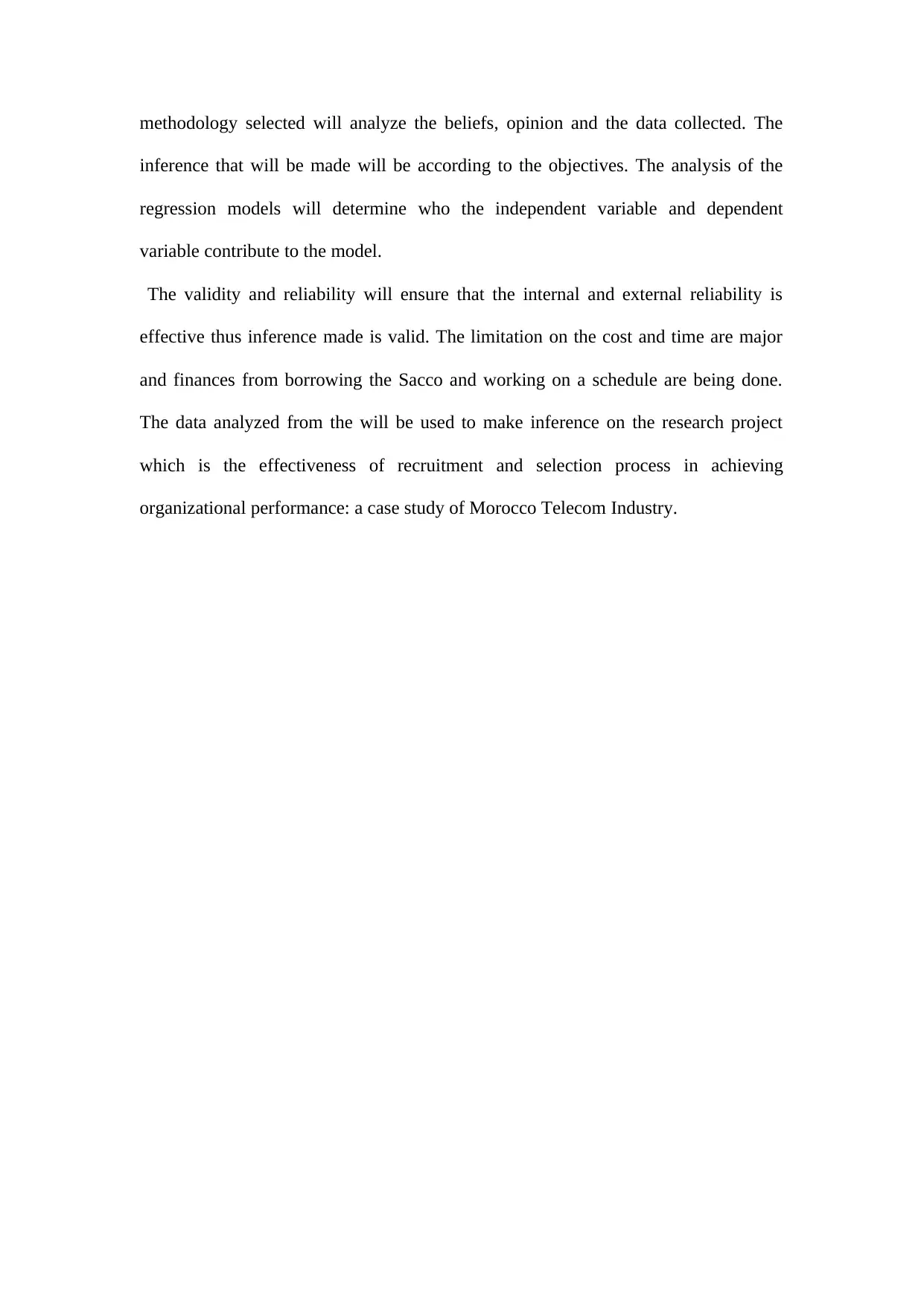
methodology selected will analyze the beliefs, opinion and the data collected. The
inference that will be made will be according to the objectives. The analysis of the
regression models will determine who the independent variable and dependent
variable contribute to the model.
The validity and reliability will ensure that the internal and external reliability is
effective thus inference made is valid. The limitation on the cost and time are major
and finances from borrowing the Sacco and working on a schedule are being done.
The data analyzed from the will be used to make inference on the research project
which is the effectiveness of recruitment and selection process in achieving
organizational performance: a case study of Morocco Telecom Industry.
inference that will be made will be according to the objectives. The analysis of the
regression models will determine who the independent variable and dependent
variable contribute to the model.
The validity and reliability will ensure that the internal and external reliability is
effective thus inference made is valid. The limitation on the cost and time are major
and finances from borrowing the Sacco and working on a schedule are being done.
The data analyzed from the will be used to make inference on the research project
which is the effectiveness of recruitment and selection process in achieving
organizational performance: a case study of Morocco Telecom Industry.
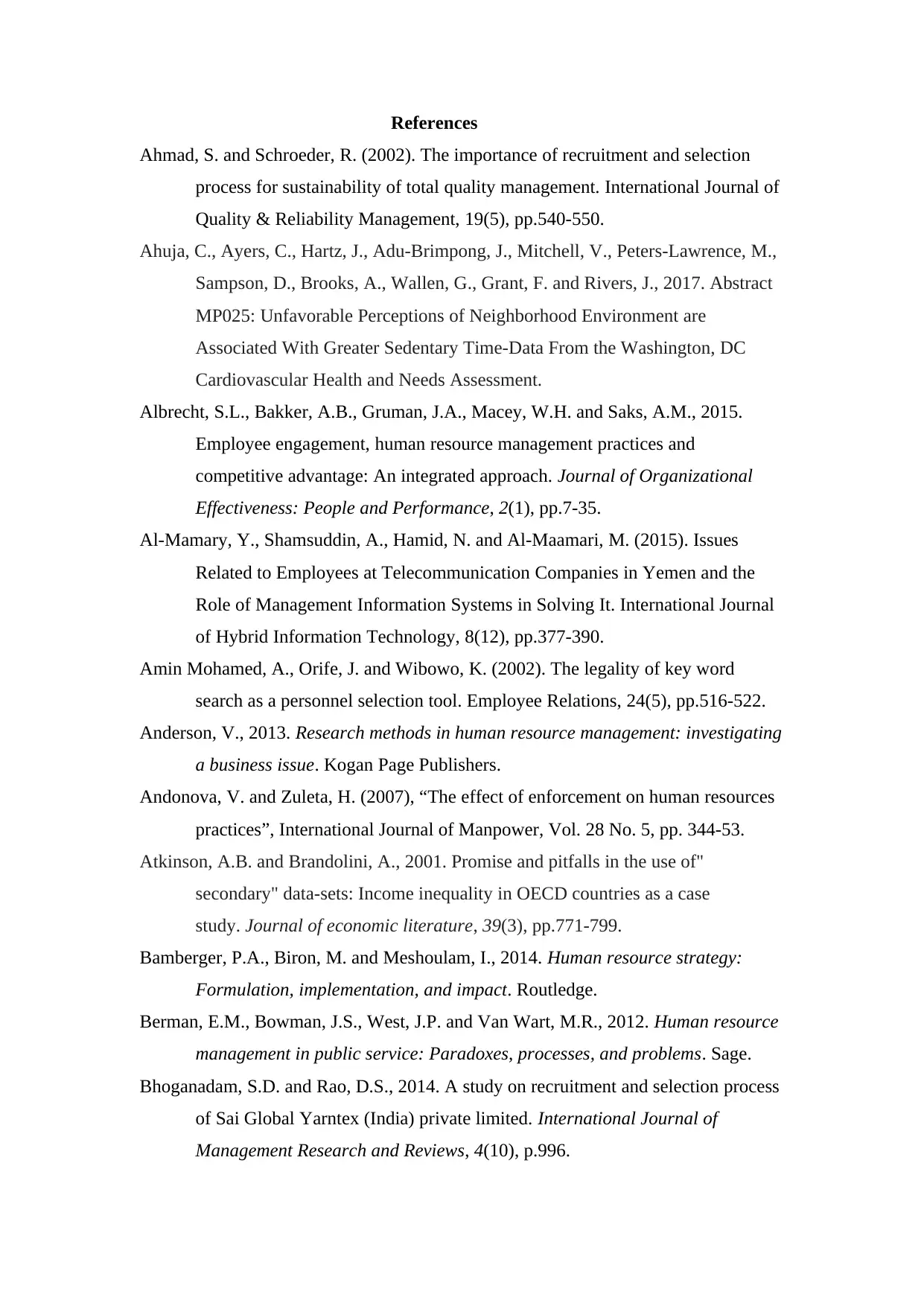
References
Ahmad, S. and Schroeder, R. (2002). The importance of recruitment and selection
process for sustainability of total quality management. International Journal of
Quality & Reliability Management, 19(5), pp.540-550.
Ahuja, C., Ayers, C., Hartz, J., Adu-Brimpong, J., Mitchell, V., Peters-Lawrence, M.,
Sampson, D., Brooks, A., Wallen, G., Grant, F. and Rivers, J., 2017. Abstract
MP025: Unfavorable Perceptions of Neighborhood Environment are
Associated With Greater Sedentary Time-Data From the Washington, DC
Cardiovascular Health and Needs Assessment.
Albrecht, S.L., Bakker, A.B., Gruman, J.A., Macey, W.H. and Saks, A.M., 2015.
Employee engagement, human resource management practices and
competitive advantage: An integrated approach. Journal of Organizational
Effectiveness: People and Performance, 2(1), pp.7-35.
Al-Mamary, Y., Shamsuddin, A., Hamid, N. and Al-Maamari, M. (2015). Issues
Related to Employees at Telecommunication Companies in Yemen and the
Role of Management Information Systems in Solving It. International Journal
of Hybrid Information Technology, 8(12), pp.377-390.
Amin Mohamed, A., Orife, J. and Wibowo, K. (2002). The legality of key word
search as a personnel selection tool. Employee Relations, 24(5), pp.516-522.
Anderson, V., 2013. Research methods in human resource management: investigating
a business issue. Kogan Page Publishers.
Andonova, V. and Zuleta, H. (2007), “The effect of enforcement on human resources
practices”, International Journal of Manpower, Vol. 28 No. 5, pp. 344-53.
Atkinson, A.B. and Brandolini, A., 2001. Promise and pitfalls in the use of"
secondary" data-sets: Income inequality in OECD countries as a case
study. Journal of economic literature, 39(3), pp.771-799.
Bamberger, P.A., Biron, M. and Meshoulam, I., 2014. Human resource strategy:
Formulation, implementation, and impact. Routledge.
Berman, E.M., Bowman, J.S., West, J.P. and Van Wart, M.R., 2012. Human resource
management in public service: Paradoxes, processes, and problems. Sage.
Bhoganadam, S.D. and Rao, D.S., 2014. A study on recruitment and selection process
of Sai Global Yarntex (India) private limited. International Journal of
Management Research and Reviews, 4(10), p.996.
Ahmad, S. and Schroeder, R. (2002). The importance of recruitment and selection
process for sustainability of total quality management. International Journal of
Quality & Reliability Management, 19(5), pp.540-550.
Ahuja, C., Ayers, C., Hartz, J., Adu-Brimpong, J., Mitchell, V., Peters-Lawrence, M.,
Sampson, D., Brooks, A., Wallen, G., Grant, F. and Rivers, J., 2017. Abstract
MP025: Unfavorable Perceptions of Neighborhood Environment are
Associated With Greater Sedentary Time-Data From the Washington, DC
Cardiovascular Health and Needs Assessment.
Albrecht, S.L., Bakker, A.B., Gruman, J.A., Macey, W.H. and Saks, A.M., 2015.
Employee engagement, human resource management practices and
competitive advantage: An integrated approach. Journal of Organizational
Effectiveness: People and Performance, 2(1), pp.7-35.
Al-Mamary, Y., Shamsuddin, A., Hamid, N. and Al-Maamari, M. (2015). Issues
Related to Employees at Telecommunication Companies in Yemen and the
Role of Management Information Systems in Solving It. International Journal
of Hybrid Information Technology, 8(12), pp.377-390.
Amin Mohamed, A., Orife, J. and Wibowo, K. (2002). The legality of key word
search as a personnel selection tool. Employee Relations, 24(5), pp.516-522.
Anderson, V., 2013. Research methods in human resource management: investigating
a business issue. Kogan Page Publishers.
Andonova, V. and Zuleta, H. (2007), “The effect of enforcement on human resources
practices”, International Journal of Manpower, Vol. 28 No. 5, pp. 344-53.
Atkinson, A.B. and Brandolini, A., 2001. Promise and pitfalls in the use of"
secondary" data-sets: Income inequality in OECD countries as a case
study. Journal of economic literature, 39(3), pp.771-799.
Bamberger, P.A., Biron, M. and Meshoulam, I., 2014. Human resource strategy:
Formulation, implementation, and impact. Routledge.
Berman, E.M., Bowman, J.S., West, J.P. and Van Wart, M.R., 2012. Human resource
management in public service: Paradoxes, processes, and problems. Sage.
Bhoganadam, S.D. and Rao, D.S., 2014. A study on recruitment and selection process
of Sai Global Yarntex (India) private limited. International Journal of
Management Research and Reviews, 4(10), p.996.
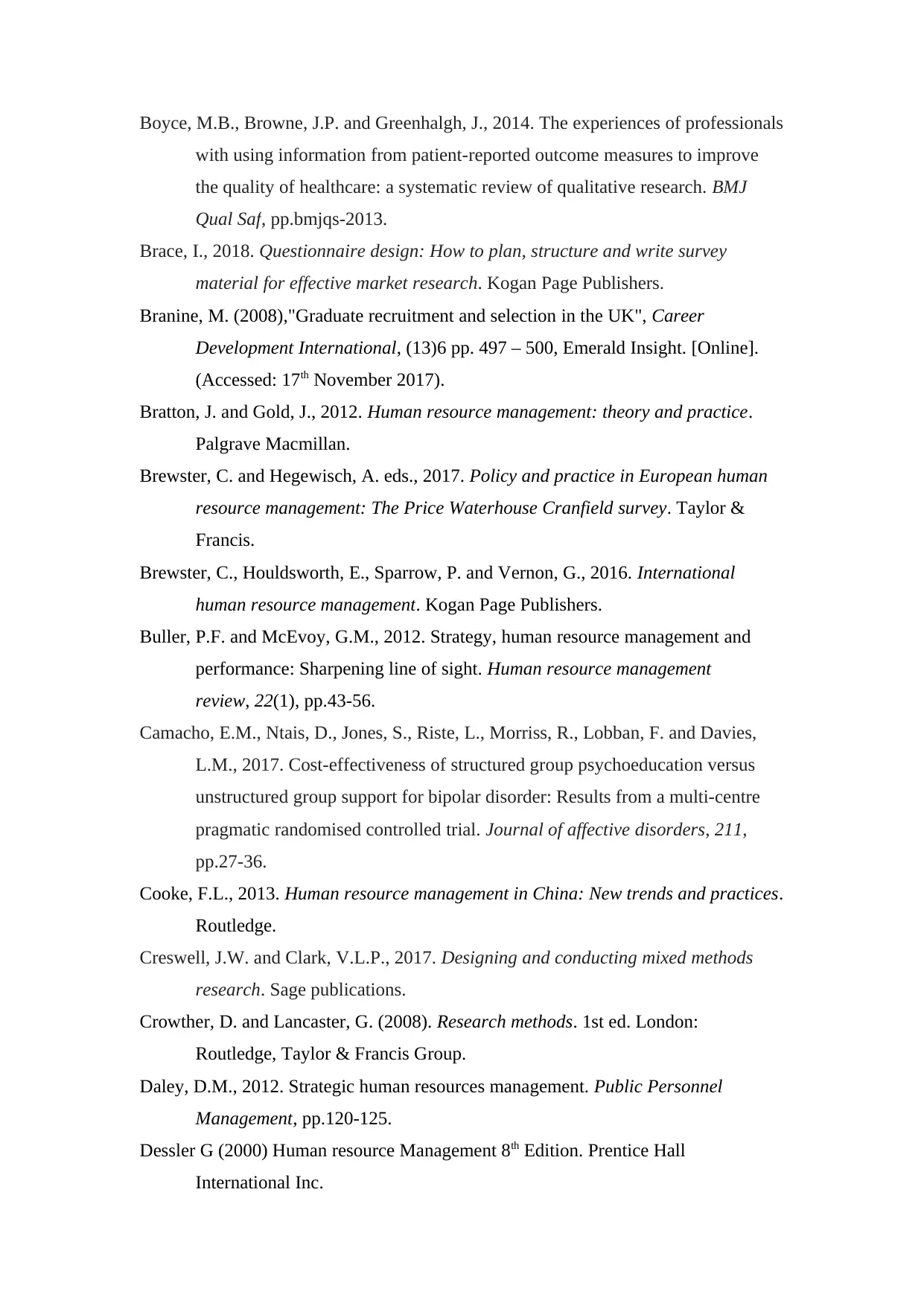
Boyce, M.B., Browne, J.P. and Greenhalgh, J., 2014. The experiences of professionals
with using information from patient-reported outcome measures to improve
the quality of healthcare: a systematic review of qualitative research. BMJ
Qual Saf, pp.bmjqs-2013.
Brace, I., 2018. Questionnaire design: How to plan, structure and write survey
material for effective market research. Kogan Page Publishers.
Branine, M. (2008),"Graduate recruitment and selection in the UK", Career
Development International, (13)6 pp. 497 – 500, Emerald Insight. [Online].
(Accessed: 17th November 2017).
Bratton, J. and Gold, J., 2012. Human resource management: theory and practice.
Palgrave Macmillan.
Brewster, C. and Hegewisch, A. eds., 2017. Policy and practice in European human
resource management: The Price Waterhouse Cranfield survey. Taylor &
Francis.
Brewster, C., Houldsworth, E., Sparrow, P. and Vernon, G., 2016. International
human resource management. Kogan Page Publishers.
Buller, P.F. and McEvoy, G.M., 2012. Strategy, human resource management and
performance: Sharpening line of sight. Human resource management
review, 22(1), pp.43-56.
Camacho, E.M., Ntais, D., Jones, S., Riste, L., Morriss, R., Lobban, F. and Davies,
L.M., 2017. Cost-effectiveness of structured group psychoeducation versus
unstructured group support for bipolar disorder: Results from a multi-centre
pragmatic randomised controlled trial. Journal of affective disorders, 211,
pp.27-36.
Cooke, F.L., 2013. Human resource management in China: New trends and practices.
Routledge.
Creswell, J.W. and Clark, V.L.P., 2017. Designing and conducting mixed methods
research. Sage publications.
Crowther, D. and Lancaster, G. (2008). Research methods. 1st ed. London:
Routledge, Taylor & Francis Group.
Daley, D.M., 2012. Strategic human resources management. Public Personnel
Management, pp.120-125.
Dessler G (2000) Human resource Management 8th Edition. Prentice Hall
International Inc.
with using information from patient-reported outcome measures to improve
the quality of healthcare: a systematic review of qualitative research. BMJ
Qual Saf, pp.bmjqs-2013.
Brace, I., 2018. Questionnaire design: How to plan, structure and write survey
material for effective market research. Kogan Page Publishers.
Branine, M. (2008),"Graduate recruitment and selection in the UK", Career
Development International, (13)6 pp. 497 – 500, Emerald Insight. [Online].
(Accessed: 17th November 2017).
Bratton, J. and Gold, J., 2012. Human resource management: theory and practice.
Palgrave Macmillan.
Brewster, C. and Hegewisch, A. eds., 2017. Policy and practice in European human
resource management: The Price Waterhouse Cranfield survey. Taylor &
Francis.
Brewster, C., Houldsworth, E., Sparrow, P. and Vernon, G., 2016. International
human resource management. Kogan Page Publishers.
Buller, P.F. and McEvoy, G.M., 2012. Strategy, human resource management and
performance: Sharpening line of sight. Human resource management
review, 22(1), pp.43-56.
Camacho, E.M., Ntais, D., Jones, S., Riste, L., Morriss, R., Lobban, F. and Davies,
L.M., 2017. Cost-effectiveness of structured group psychoeducation versus
unstructured group support for bipolar disorder: Results from a multi-centre
pragmatic randomised controlled trial. Journal of affective disorders, 211,
pp.27-36.
Cooke, F.L., 2013. Human resource management in China: New trends and practices.
Routledge.
Creswell, J.W. and Clark, V.L.P., 2017. Designing and conducting mixed methods
research. Sage publications.
Crowther, D. and Lancaster, G. (2008). Research methods. 1st ed. London:
Routledge, Taylor & Francis Group.
Daley, D.M., 2012. Strategic human resources management. Public Personnel
Management, pp.120-125.
Dessler G (2000) Human resource Management 8th Edition. Prentice Hall
International Inc.
Paraphrase This Document
Need a fresh take? Get an instant paraphrase of this document with our AI Paraphraser
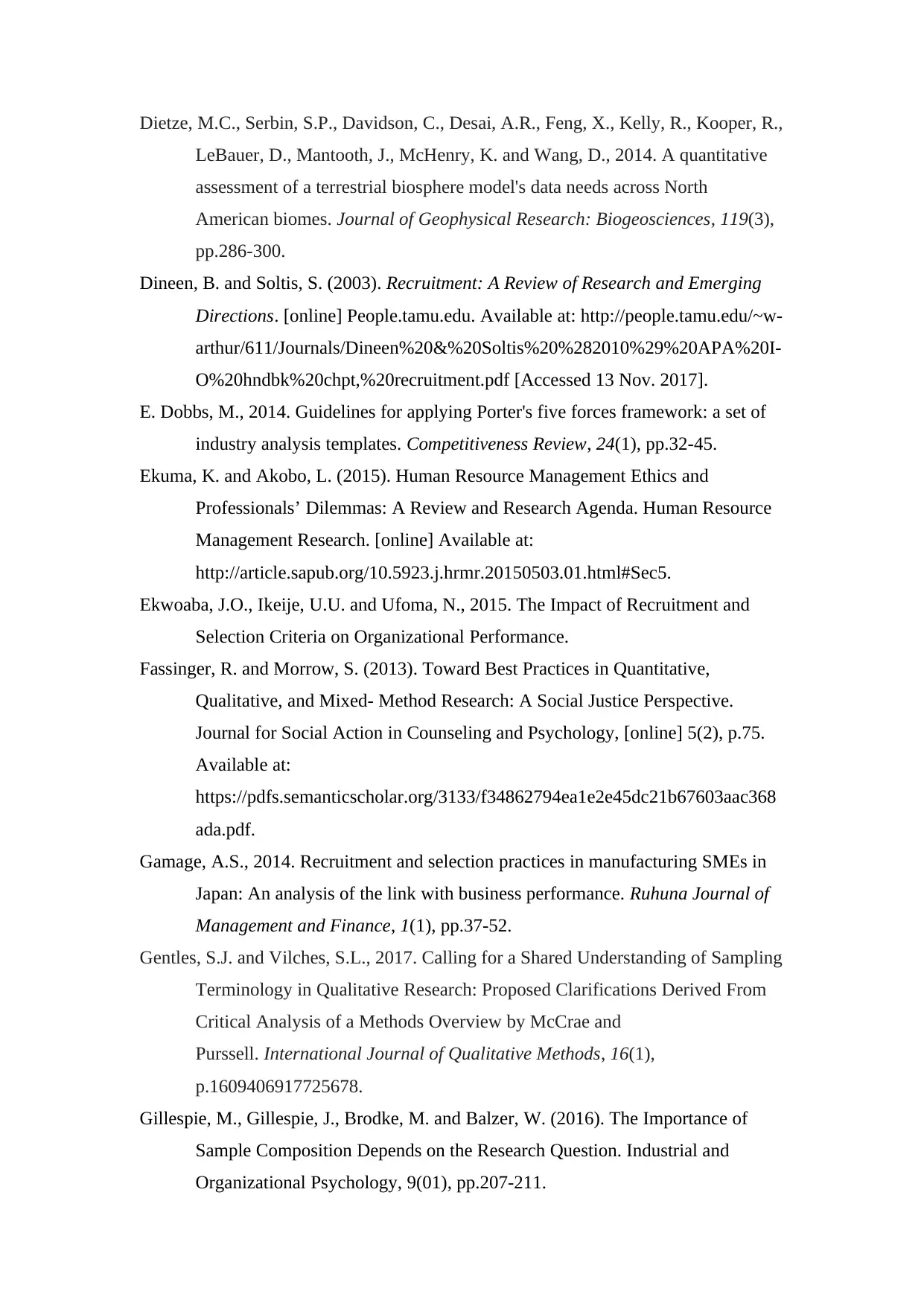
Dietze, M.C., Serbin, S.P., Davidson, C., Desai, A.R., Feng, X., Kelly, R., Kooper, R.,
LeBauer, D., Mantooth, J., McHenry, K. and Wang, D., 2014. A quantitative
assessment of a terrestrial biosphere model's data needs across North
American biomes. Journal of Geophysical Research: Biogeosciences, 119(3),
pp.286-300.
Dineen, B. and Soltis, S. (2003). Recruitment: A Review of Research and Emerging
Directions. [online] People.tamu.edu. Available at: http://people.tamu.edu/~w-
arthur/611/Journals/Dineen%20&%20Soltis%20%282010%29%20APA%20I-
O%20hndbk%20chpt,%20recruitment.pdf [Accessed 13 Nov. 2017].
E. Dobbs, M., 2014. Guidelines for applying Porter's five forces framework: a set of
industry analysis templates. Competitiveness Review, 24(1), pp.32-45.
Ekuma, K. and Akobo, L. (2015). Human Resource Management Ethics and
Professionals’ Dilemmas: A Review and Research Agenda. Human Resource
Management Research. [online] Available at:
http://article.sapub.org/10.5923.j.hrmr.20150503.01.html#Sec5.
Ekwoaba, J.O., Ikeije, U.U. and Ufoma, N., 2015. The Impact of Recruitment and
Selection Criteria on Organizational Performance.
Fassinger, R. and Morrow, S. (2013). Toward Best Practices in Quantitative,
Qualitative, and Mixed- Method Research: A Social Justice Perspective.
Journal for Social Action in Counseling and Psychology, [online] 5(2), p.75.
Available at:
https://pdfs.semanticscholar.org/3133/f34862794ea1e2e45dc21b67603aac368
ada.pdf.
Gamage, A.S., 2014. Recruitment and selection practices in manufacturing SMEs in
Japan: An analysis of the link with business performance. Ruhuna Journal of
Management and Finance, 1(1), pp.37-52.
Gentles, S.J. and Vilches, S.L., 2017. Calling for a Shared Understanding of Sampling
Terminology in Qualitative Research: Proposed Clarifications Derived From
Critical Analysis of a Methods Overview by McCrae and
Purssell. International Journal of Qualitative Methods, 16(1),
p.1609406917725678.
Gillespie, M., Gillespie, J., Brodke, M. and Balzer, W. (2016). The Importance of
Sample Composition Depends on the Research Question. Industrial and
Organizational Psychology, 9(01), pp.207-211.
LeBauer, D., Mantooth, J., McHenry, K. and Wang, D., 2014. A quantitative
assessment of a terrestrial biosphere model's data needs across North
American biomes. Journal of Geophysical Research: Biogeosciences, 119(3),
pp.286-300.
Dineen, B. and Soltis, S. (2003). Recruitment: A Review of Research and Emerging
Directions. [online] People.tamu.edu. Available at: http://people.tamu.edu/~w-
arthur/611/Journals/Dineen%20&%20Soltis%20%282010%29%20APA%20I-
O%20hndbk%20chpt,%20recruitment.pdf [Accessed 13 Nov. 2017].
E. Dobbs, M., 2014. Guidelines for applying Porter's five forces framework: a set of
industry analysis templates. Competitiveness Review, 24(1), pp.32-45.
Ekuma, K. and Akobo, L. (2015). Human Resource Management Ethics and
Professionals’ Dilemmas: A Review and Research Agenda. Human Resource
Management Research. [online] Available at:
http://article.sapub.org/10.5923.j.hrmr.20150503.01.html#Sec5.
Ekwoaba, J.O., Ikeije, U.U. and Ufoma, N., 2015. The Impact of Recruitment and
Selection Criteria on Organizational Performance.
Fassinger, R. and Morrow, S. (2013). Toward Best Practices in Quantitative,
Qualitative, and Mixed- Method Research: A Social Justice Perspective.
Journal for Social Action in Counseling and Psychology, [online] 5(2), p.75.
Available at:
https://pdfs.semanticscholar.org/3133/f34862794ea1e2e45dc21b67603aac368
ada.pdf.
Gamage, A.S., 2014. Recruitment and selection practices in manufacturing SMEs in
Japan: An analysis of the link with business performance. Ruhuna Journal of
Management and Finance, 1(1), pp.37-52.
Gentles, S.J. and Vilches, S.L., 2017. Calling for a Shared Understanding of Sampling
Terminology in Qualitative Research: Proposed Clarifications Derived From
Critical Analysis of a Methods Overview by McCrae and
Purssell. International Journal of Qualitative Methods, 16(1),
p.1609406917725678.
Gillespie, M., Gillespie, J., Brodke, M. and Balzer, W. (2016). The Importance of
Sample Composition Depends on the Research Question. Industrial and
Organizational Psychology, 9(01), pp.207-211.
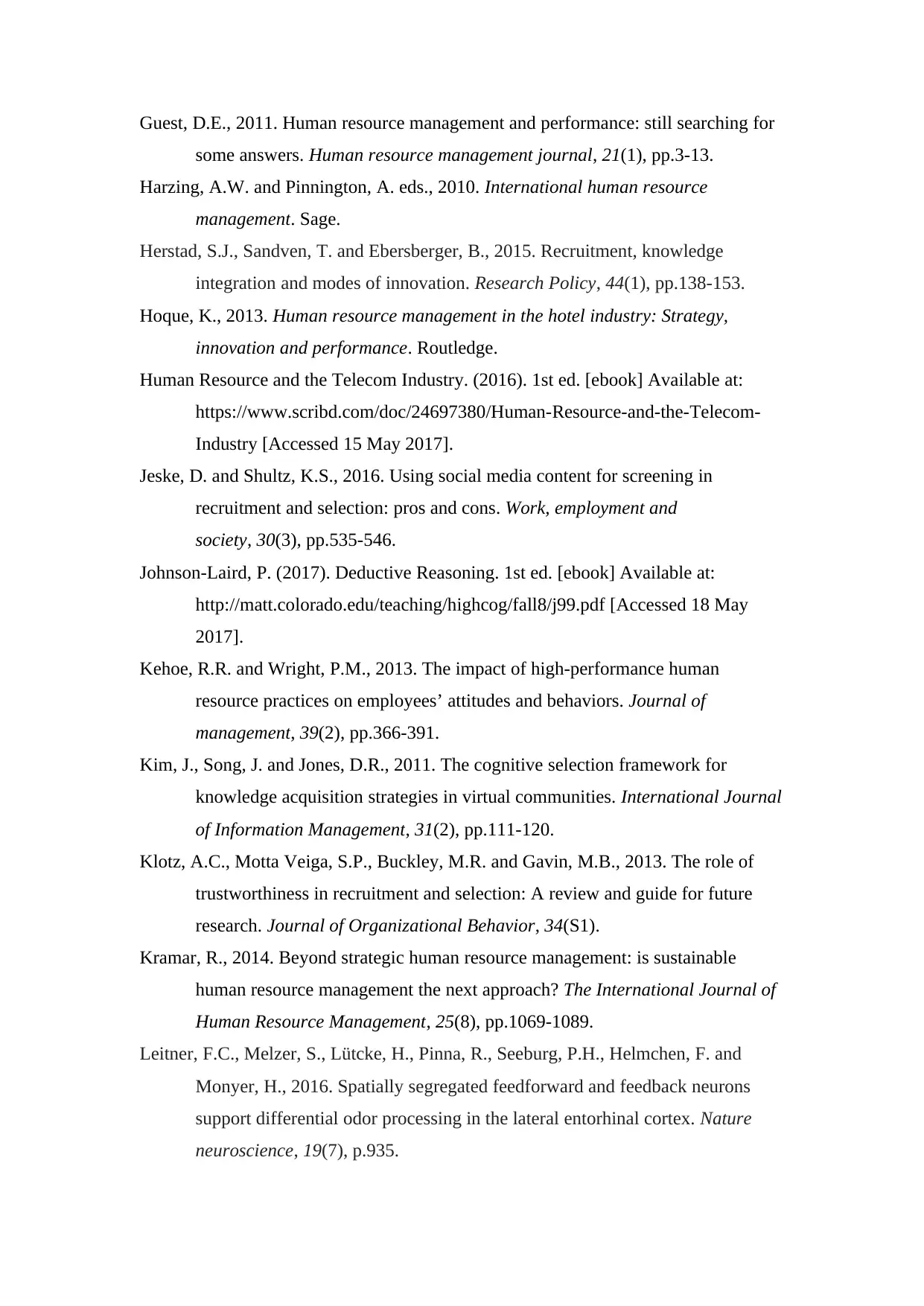
Guest, D.E., 2011. Human resource management and performance: still searching for
some answers. Human resource management journal, 21(1), pp.3-13.
Harzing, A.W. and Pinnington, A. eds., 2010. International human resource
management. Sage.
Herstad, S.J., Sandven, T. and Ebersberger, B., 2015. Recruitment, knowledge
integration and modes of innovation. Research Policy, 44(1), pp.138-153.
Hoque, K., 2013. Human resource management in the hotel industry: Strategy,
innovation and performance. Routledge.
Human Resource and the Telecom Industry. (2016). 1st ed. [ebook] Available at:
https://www.scribd.com/doc/24697380/Human-Resource-and-the-Telecom-
Industry [Accessed 15 May 2017].
Jeske, D. and Shultz, K.S., 2016. Using social media content for screening in
recruitment and selection: pros and cons. Work, employment and
society, 30(3), pp.535-546.
Johnson-Laird, P. (2017). Deductive Reasoning. 1st ed. [ebook] Available at:
http://matt.colorado.edu/teaching/highcog/fall8/j99.pdf [Accessed 18 May
2017].
Kehoe, R.R. and Wright, P.M., 2013. The impact of high-performance human
resource practices on employees’ attitudes and behaviors. Journal of
management, 39(2), pp.366-391.
Kim, J., Song, J. and Jones, D.R., 2011. The cognitive selection framework for
knowledge acquisition strategies in virtual communities. International Journal
of Information Management, 31(2), pp.111-120.
Klotz, A.C., Motta Veiga, S.P., Buckley, M.R. and Gavin, M.B., 2013. The role of
trustworthiness in recruitment and selection: A review and guide for future
research. Journal of Organizational Behavior, 34(S1).
Kramar, R., 2014. Beyond strategic human resource management: is sustainable
human resource management the next approach? The International Journal of
Human Resource Management, 25(8), pp.1069-1089.
Leitner, F.C., Melzer, S., Lütcke, H., Pinna, R., Seeburg, P.H., Helmchen, F. and
Monyer, H., 2016. Spatially segregated feedforward and feedback neurons
support differential odor processing in the lateral entorhinal cortex. Nature
neuroscience, 19(7), p.935.
some answers. Human resource management journal, 21(1), pp.3-13.
Harzing, A.W. and Pinnington, A. eds., 2010. International human resource
management. Sage.
Herstad, S.J., Sandven, T. and Ebersberger, B., 2015. Recruitment, knowledge
integration and modes of innovation. Research Policy, 44(1), pp.138-153.
Hoque, K., 2013. Human resource management in the hotel industry: Strategy,
innovation and performance. Routledge.
Human Resource and the Telecom Industry. (2016). 1st ed. [ebook] Available at:
https://www.scribd.com/doc/24697380/Human-Resource-and-the-Telecom-
Industry [Accessed 15 May 2017].
Jeske, D. and Shultz, K.S., 2016. Using social media content for screening in
recruitment and selection: pros and cons. Work, employment and
society, 30(3), pp.535-546.
Johnson-Laird, P. (2017). Deductive Reasoning. 1st ed. [ebook] Available at:
http://matt.colorado.edu/teaching/highcog/fall8/j99.pdf [Accessed 18 May
2017].
Kehoe, R.R. and Wright, P.M., 2013. The impact of high-performance human
resource practices on employees’ attitudes and behaviors. Journal of
management, 39(2), pp.366-391.
Kim, J., Song, J. and Jones, D.R., 2011. The cognitive selection framework for
knowledge acquisition strategies in virtual communities. International Journal
of Information Management, 31(2), pp.111-120.
Klotz, A.C., Motta Veiga, S.P., Buckley, M.R. and Gavin, M.B., 2013. The role of
trustworthiness in recruitment and selection: A review and guide for future
research. Journal of Organizational Behavior, 34(S1).
Kramar, R., 2014. Beyond strategic human resource management: is sustainable
human resource management the next approach? The International Journal of
Human Resource Management, 25(8), pp.1069-1089.
Leitner, F.C., Melzer, S., Lütcke, H., Pinna, R., Seeburg, P.H., Helmchen, F. and
Monyer, H., 2016. Spatially segregated feedforward and feedback neurons
support differential odor processing in the lateral entorhinal cortex. Nature
neuroscience, 19(7), p.935.
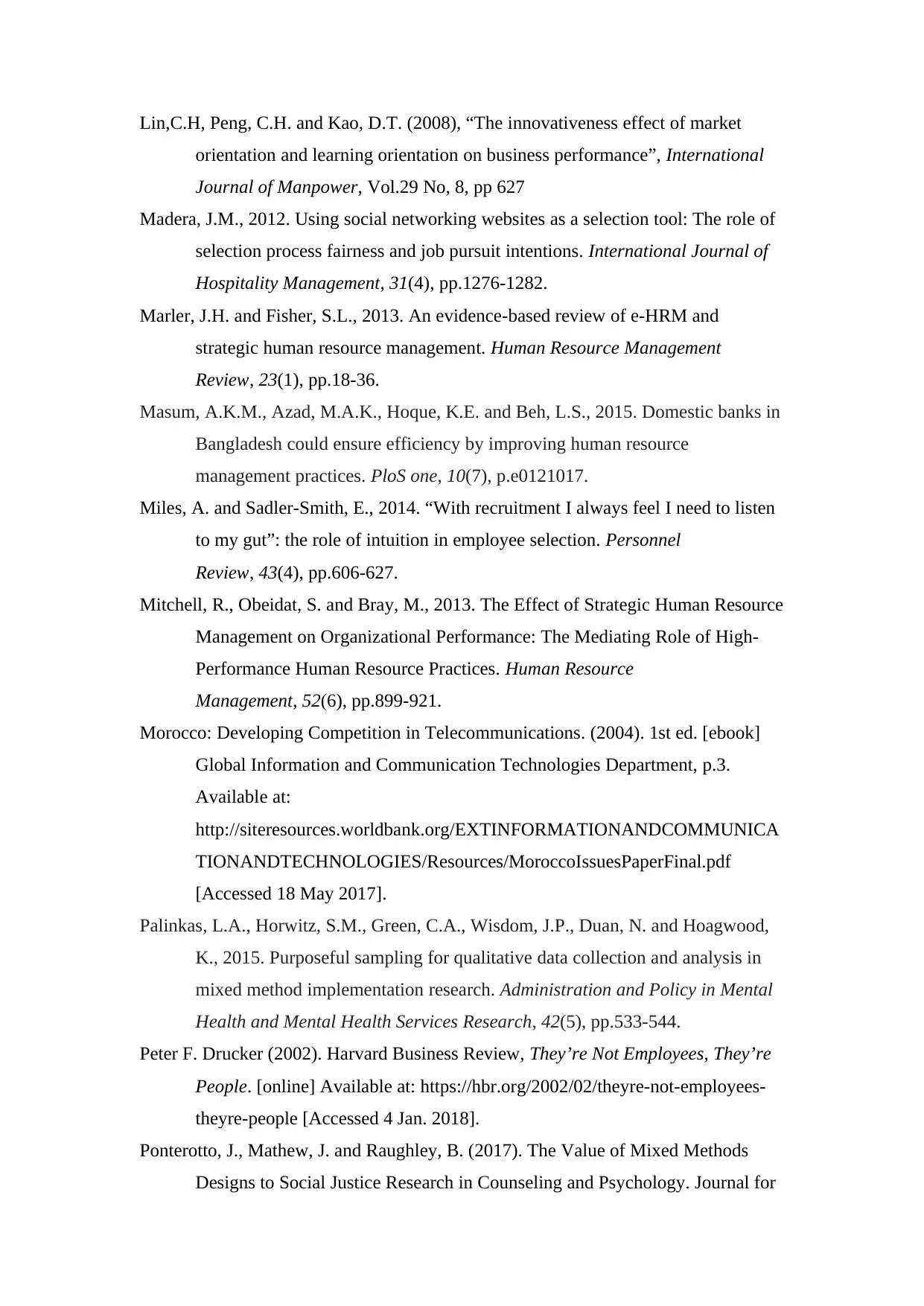
Lin,C.H, Peng, C.H. and Kao, D.T. (2008), “The innovativeness effect of market
orientation and learning orientation on business performance”, International
Journal of Manpower, Vol.29 No, 8, pp 627
Madera, J.M., 2012. Using social networking websites as a selection tool: The role of
selection process fairness and job pursuit intentions. International Journal of
Hospitality Management, 31(4), pp.1276-1282.
Marler, J.H. and Fisher, S.L., 2013. An evidence-based review of e-HRM and
strategic human resource management. Human Resource Management
Review, 23(1), pp.18-36.
Masum, A.K.M., Azad, M.A.K., Hoque, K.E. and Beh, L.S., 2015. Domestic banks in
Bangladesh could ensure efficiency by improving human resource
management practices. PloS one, 10(7), p.e0121017.
Miles, A. and Sadler-Smith, E., 2014. “With recruitment I always feel I need to listen
to my gut”: the role of intuition in employee selection. Personnel
Review, 43(4), pp.606-627.
Mitchell, R., Obeidat, S. and Bray, M., 2013. The Effect of Strategic Human Resource
Management on Organizational Performance: The Mediating Role of High‐
Performance Human Resource Practices. Human Resource
Management, 52(6), pp.899-921.
Morocco: Developing Competition in Telecommunications. (2004). 1st ed. [ebook]
Global Information and Communication Technologies Department, p.3.
Available at:
http://siteresources.worldbank.org/EXTINFORMATIONANDCOMMUNICA
TIONANDTECHNOLOGIES/Resources/MoroccoIssuesPaperFinal.pdf
[Accessed 18 May 2017].
Palinkas, L.A., Horwitz, S.M., Green, C.A., Wisdom, J.P., Duan, N. and Hoagwood,
K., 2015. Purposeful sampling for qualitative data collection and analysis in
mixed method implementation research. Administration and Policy in Mental
Health and Mental Health Services Research, 42(5), pp.533-544.
Peter F. Drucker (2002). Harvard Business Review, They’re Not Employees, They’re
People. [online] Available at: https://hbr.org/2002/02/theyre-not-employees-
theyre-people [Accessed 4 Jan. 2018].
Ponterotto, J., Mathew, J. and Raughley, B. (2017). The Value of Mixed Methods
Designs to Social Justice Research in Counseling and Psychology. Journal for
orientation and learning orientation on business performance”, International
Journal of Manpower, Vol.29 No, 8, pp 627
Madera, J.M., 2012. Using social networking websites as a selection tool: The role of
selection process fairness and job pursuit intentions. International Journal of
Hospitality Management, 31(4), pp.1276-1282.
Marler, J.H. and Fisher, S.L., 2013. An evidence-based review of e-HRM and
strategic human resource management. Human Resource Management
Review, 23(1), pp.18-36.
Masum, A.K.M., Azad, M.A.K., Hoque, K.E. and Beh, L.S., 2015. Domestic banks in
Bangladesh could ensure efficiency by improving human resource
management practices. PloS one, 10(7), p.e0121017.
Miles, A. and Sadler-Smith, E., 2014. “With recruitment I always feel I need to listen
to my gut”: the role of intuition in employee selection. Personnel
Review, 43(4), pp.606-627.
Mitchell, R., Obeidat, S. and Bray, M., 2013. The Effect of Strategic Human Resource
Management on Organizational Performance: The Mediating Role of High‐
Performance Human Resource Practices. Human Resource
Management, 52(6), pp.899-921.
Morocco: Developing Competition in Telecommunications. (2004). 1st ed. [ebook]
Global Information and Communication Technologies Department, p.3.
Available at:
http://siteresources.worldbank.org/EXTINFORMATIONANDCOMMUNICA
TIONANDTECHNOLOGIES/Resources/MoroccoIssuesPaperFinal.pdf
[Accessed 18 May 2017].
Palinkas, L.A., Horwitz, S.M., Green, C.A., Wisdom, J.P., Duan, N. and Hoagwood,
K., 2015. Purposeful sampling for qualitative data collection and analysis in
mixed method implementation research. Administration and Policy in Mental
Health and Mental Health Services Research, 42(5), pp.533-544.
Peter F. Drucker (2002). Harvard Business Review, They’re Not Employees, They’re
People. [online] Available at: https://hbr.org/2002/02/theyre-not-employees-
theyre-people [Accessed 4 Jan. 2018].
Ponterotto, J., Mathew, J. and Raughley, B. (2017). The Value of Mixed Methods
Designs to Social Justice Research in Counseling and Psychology. Journal for
Secure Best Marks with AI Grader
Need help grading? Try our AI Grader for instant feedback on your assignments.
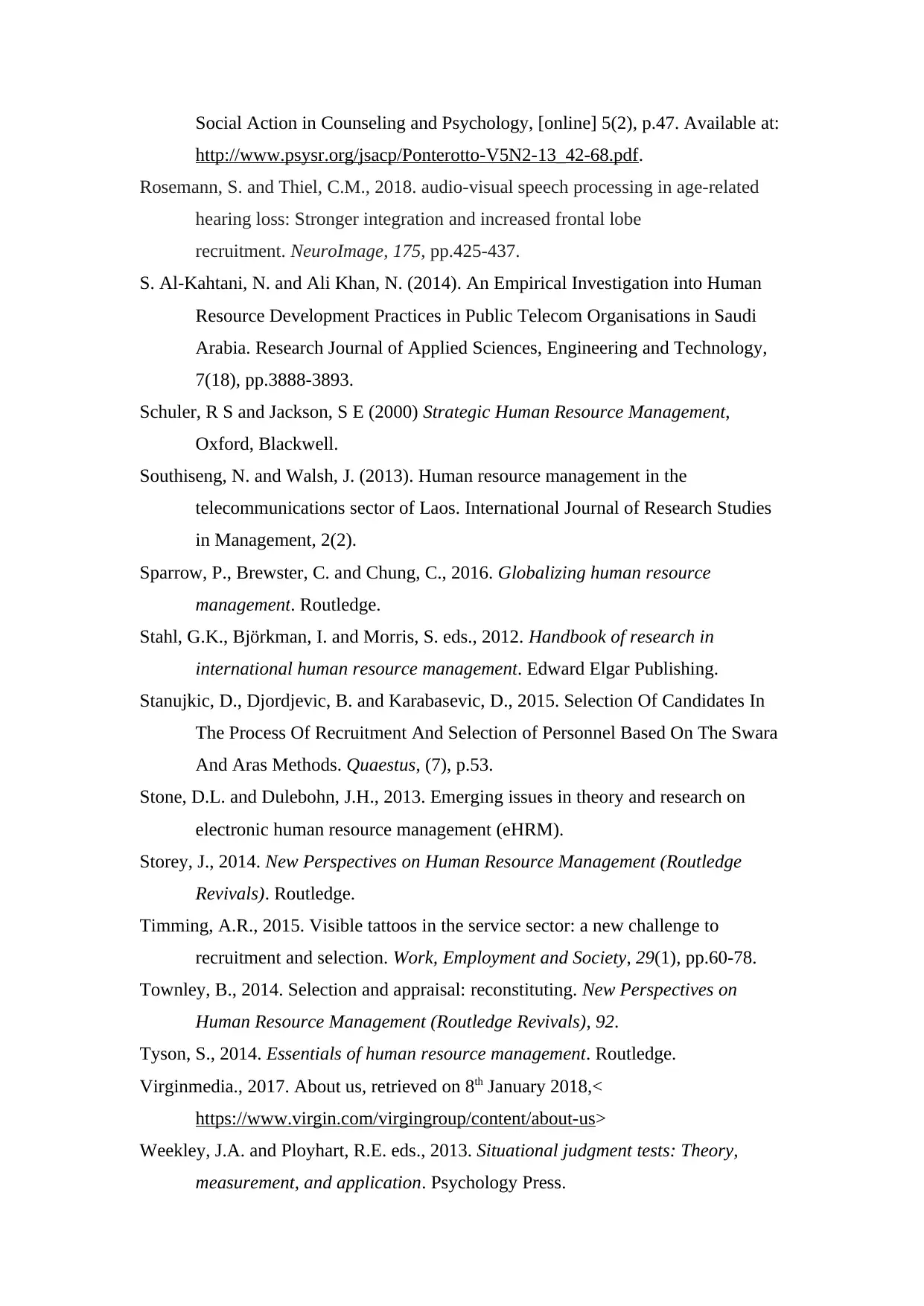
Social Action in Counseling and Psychology, [online] 5(2), p.47. Available at:
http://www.psysr.org/jsacp/Ponterotto-V5N2-13_42-68.pdf.
Rosemann, S. and Thiel, C.M., 2018. audio-visual speech processing in age-related
hearing loss: Stronger integration and increased frontal lobe
recruitment. NeuroImage, 175, pp.425-437.
S. Al-Kahtani, N. and Ali Khan, N. (2014). An Empirical Investigation into Human
Resource Development Practices in Public Telecom Organisations in Saudi
Arabia. Research Journal of Applied Sciences, Engineering and Technology,
7(18), pp.3888-3893.
Schuler, R S and Jackson, S E (2000) Strategic Human Resource Management,
Oxford, Blackwell.
Southiseng, N. and Walsh, J. (2013). Human resource management in the
telecommunications sector of Laos. International Journal of Research Studies
in Management, 2(2).
Sparrow, P., Brewster, C. and Chung, C., 2016. Globalizing human resource
management. Routledge.
Stahl, G.K., Björkman, I. and Morris, S. eds., 2012. Handbook of research in
international human resource management. Edward Elgar Publishing.
Stanujkic, D., Djordjevic, B. and Karabasevic, D., 2015. Selection Of Candidates In
The Process Of Recruitment And Selection of Personnel Based On The Swara
And Aras Methods. Quaestus, (7), p.53.
Stone, D.L. and Dulebohn, J.H., 2013. Emerging issues in theory and research on
electronic human resource management (eHRM).
Storey, J., 2014. New Perspectives on Human Resource Management (Routledge
Revivals). Routledge.
Timming, A.R., 2015. Visible tattoos in the service sector: a new challenge to
recruitment and selection. Work, Employment and Society, 29(1), pp.60-78.
Townley, B., 2014. Selection and appraisal: reconstituting. New Perspectives on
Human Resource Management (Routledge Revivals), 92.
Tyson, S., 2014. Essentials of human resource management. Routledge.
Virginmedia., 2017. About us, retrieved on 8th January 2018,<
https://www.virgin.com/virgingroup/content/about-us>
Weekley, J.A. and Ployhart, R.E. eds., 2013. Situational judgment tests: Theory,
measurement, and application. Psychology Press.
http://www.psysr.org/jsacp/Ponterotto-V5N2-13_42-68.pdf.
Rosemann, S. and Thiel, C.M., 2018. audio-visual speech processing in age-related
hearing loss: Stronger integration and increased frontal lobe
recruitment. NeuroImage, 175, pp.425-437.
S. Al-Kahtani, N. and Ali Khan, N. (2014). An Empirical Investigation into Human
Resource Development Practices in Public Telecom Organisations in Saudi
Arabia. Research Journal of Applied Sciences, Engineering and Technology,
7(18), pp.3888-3893.
Schuler, R S and Jackson, S E (2000) Strategic Human Resource Management,
Oxford, Blackwell.
Southiseng, N. and Walsh, J. (2013). Human resource management in the
telecommunications sector of Laos. International Journal of Research Studies
in Management, 2(2).
Sparrow, P., Brewster, C. and Chung, C., 2016. Globalizing human resource
management. Routledge.
Stahl, G.K., Björkman, I. and Morris, S. eds., 2012. Handbook of research in
international human resource management. Edward Elgar Publishing.
Stanujkic, D., Djordjevic, B. and Karabasevic, D., 2015. Selection Of Candidates In
The Process Of Recruitment And Selection of Personnel Based On The Swara
And Aras Methods. Quaestus, (7), p.53.
Stone, D.L. and Dulebohn, J.H., 2013. Emerging issues in theory and research on
electronic human resource management (eHRM).
Storey, J., 2014. New Perspectives on Human Resource Management (Routledge
Revivals). Routledge.
Timming, A.R., 2015. Visible tattoos in the service sector: a new challenge to
recruitment and selection. Work, Employment and Society, 29(1), pp.60-78.
Townley, B., 2014. Selection and appraisal: reconstituting. New Perspectives on
Human Resource Management (Routledge Revivals), 92.
Tyson, S., 2014. Essentials of human resource management. Routledge.
Virginmedia., 2017. About us, retrieved on 8th January 2018,<
https://www.virgin.com/virgingroup/content/about-us>
Weekley, J.A. and Ployhart, R.E. eds., 2013. Situational judgment tests: Theory,
measurement, and application. Psychology Press.
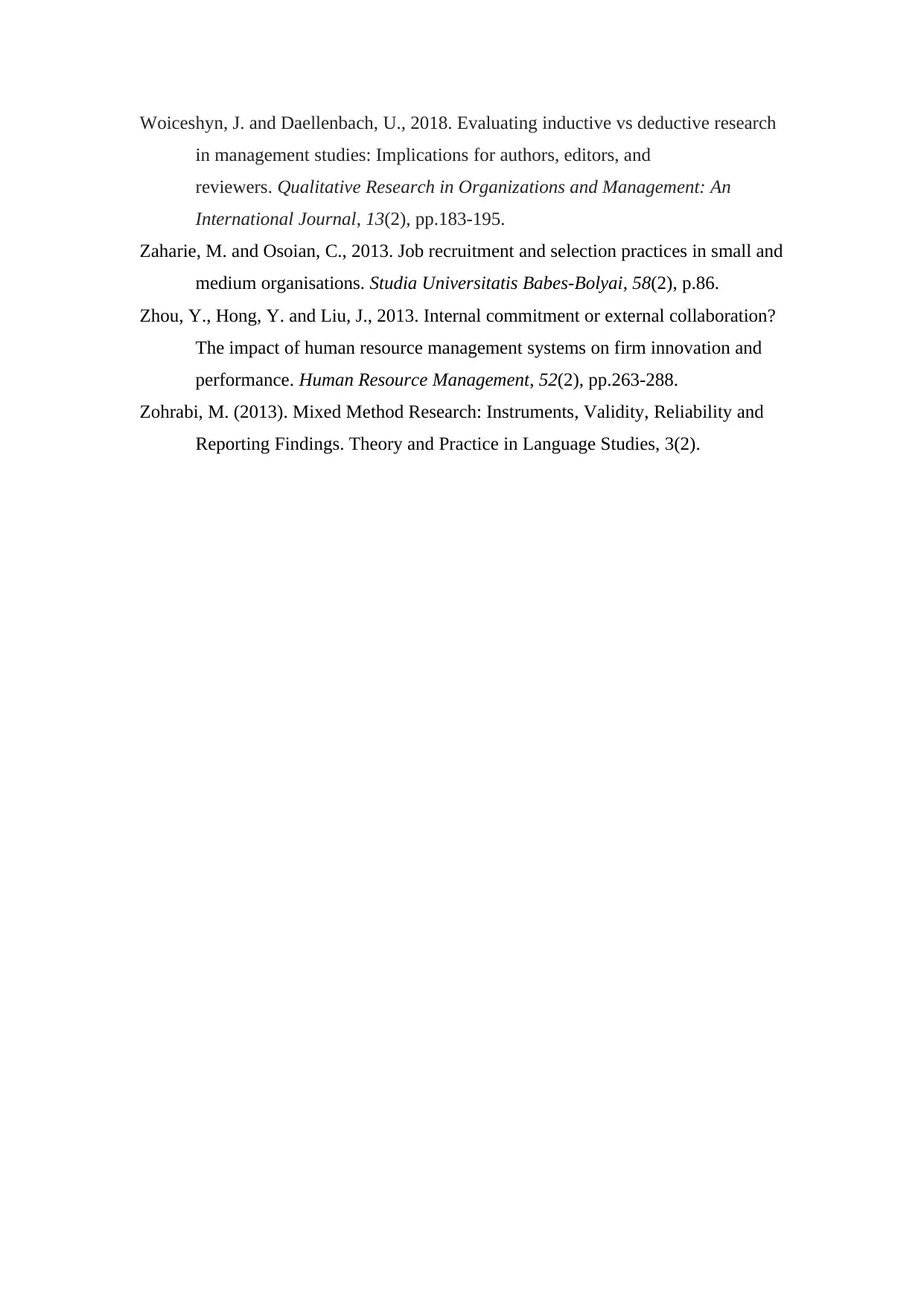
Woiceshyn, J. and Daellenbach, U., 2018. Evaluating inductive vs deductive research
in management studies: Implications for authors, editors, and
reviewers. Qualitative Research in Organizations and Management: An
International Journal, 13(2), pp.183-195.
Zaharie, M. and Osoian, C., 2013. Job recruitment and selection practices in small and
medium organisations. Studia Universitatis Babes-Bolyai, 58(2), p.86.
Zhou, Y., Hong, Y. and Liu, J., 2013. Internal commitment or external collaboration?
The impact of human resource management systems on firm innovation and
performance. Human Resource Management, 52(2), pp.263-288.
Zohrabi, M. (2013). Mixed Method Research: Instruments, Validity, Reliability and
Reporting Findings. Theory and Practice in Language Studies, 3(2).
in management studies: Implications for authors, editors, and
reviewers. Qualitative Research in Organizations and Management: An
International Journal, 13(2), pp.183-195.
Zaharie, M. and Osoian, C., 2013. Job recruitment and selection practices in small and
medium organisations. Studia Universitatis Babes-Bolyai, 58(2), p.86.
Zhou, Y., Hong, Y. and Liu, J., 2013. Internal commitment or external collaboration?
The impact of human resource management systems on firm innovation and
performance. Human Resource Management, 52(2), pp.263-288.
Zohrabi, M. (2013). Mixed Method Research: Instruments, Validity, Reliability and
Reporting Findings. Theory and Practice in Language Studies, 3(2).
1 out of 36
Related Documents
Your All-in-One AI-Powered Toolkit for Academic Success.
+13062052269
info@desklib.com
Available 24*7 on WhatsApp / Email
![[object Object]](/_next/static/media/star-bottom.7253800d.svg)
Unlock your academic potential
© 2024 | Zucol Services PVT LTD | All rights reserved.





